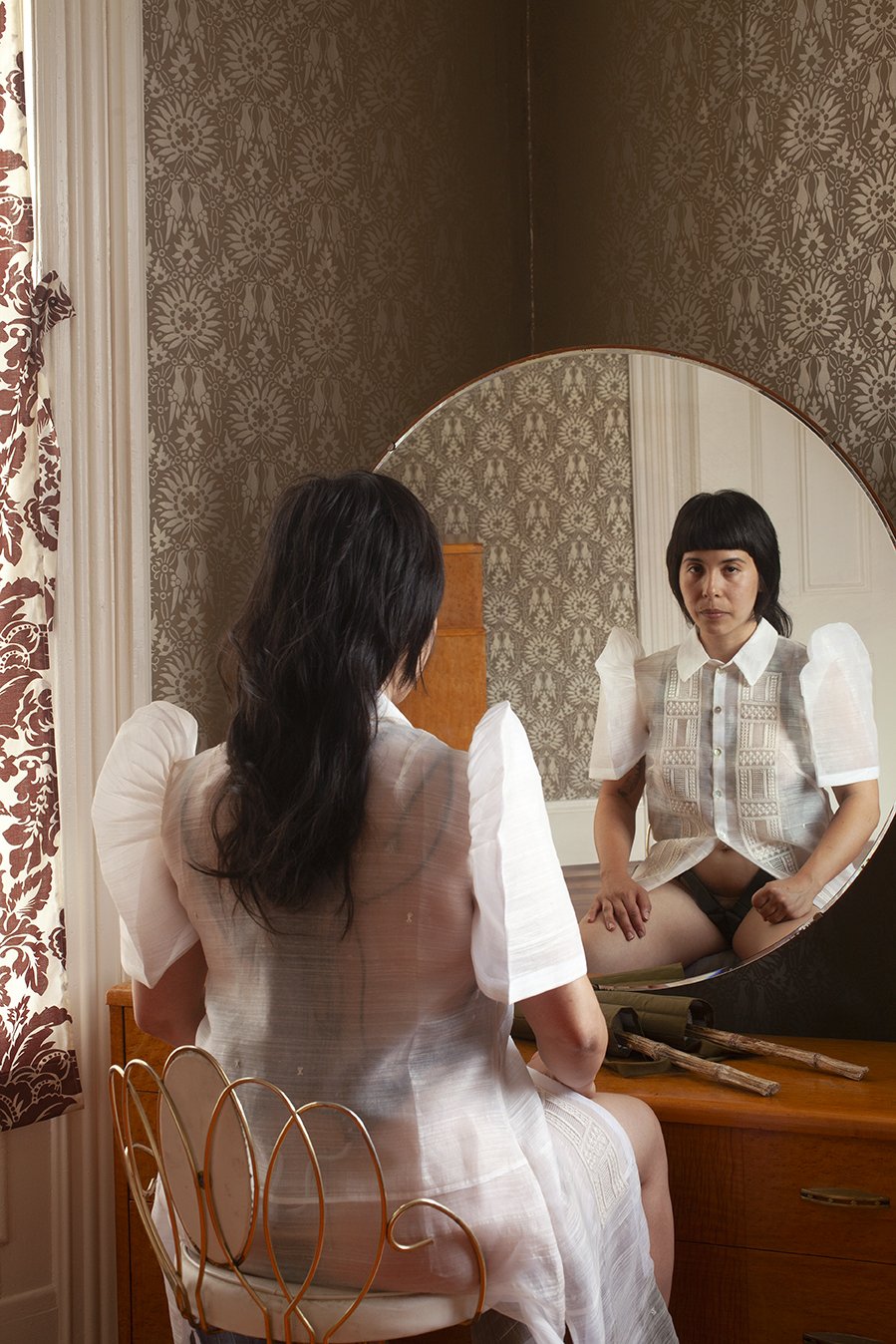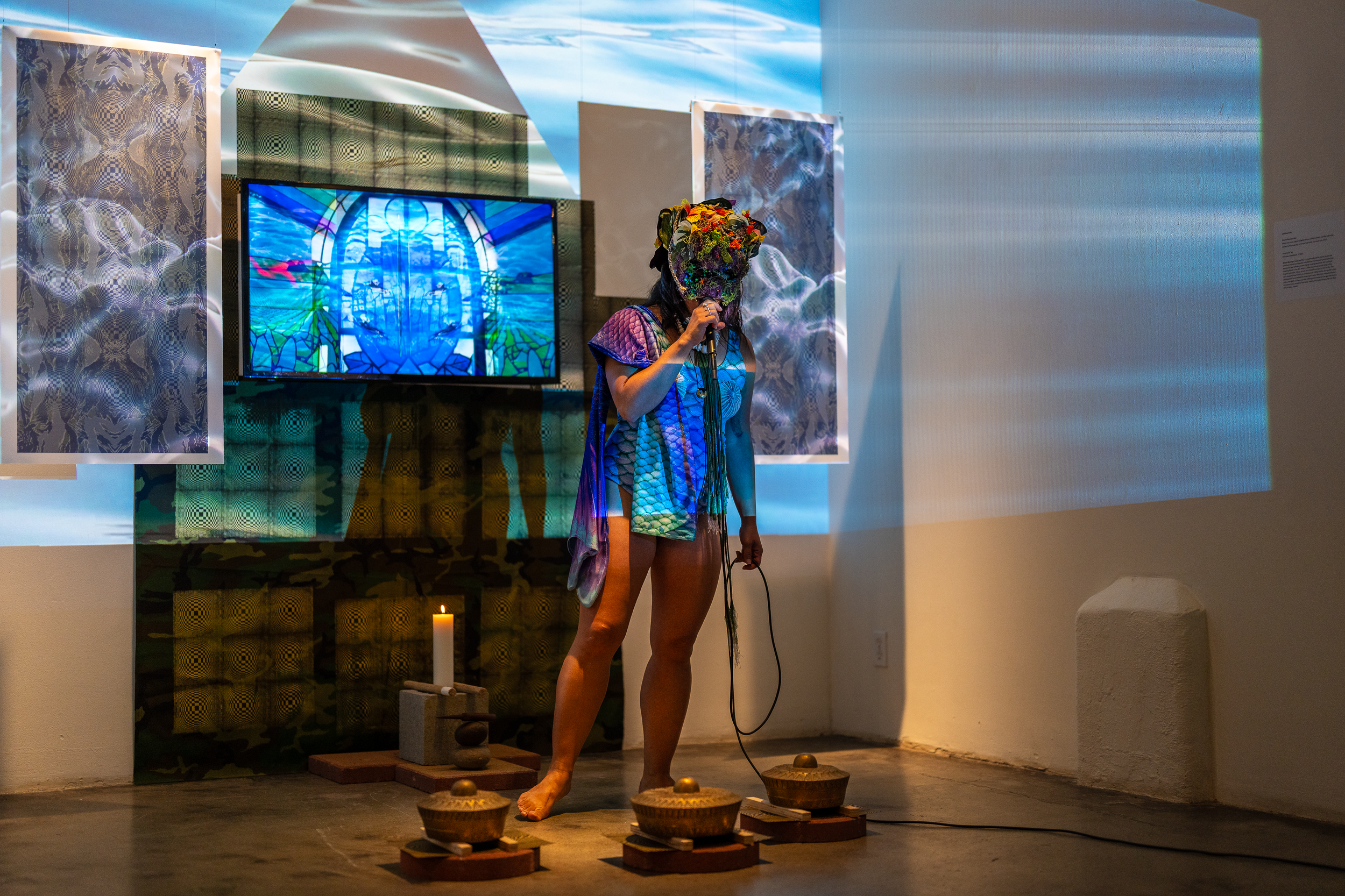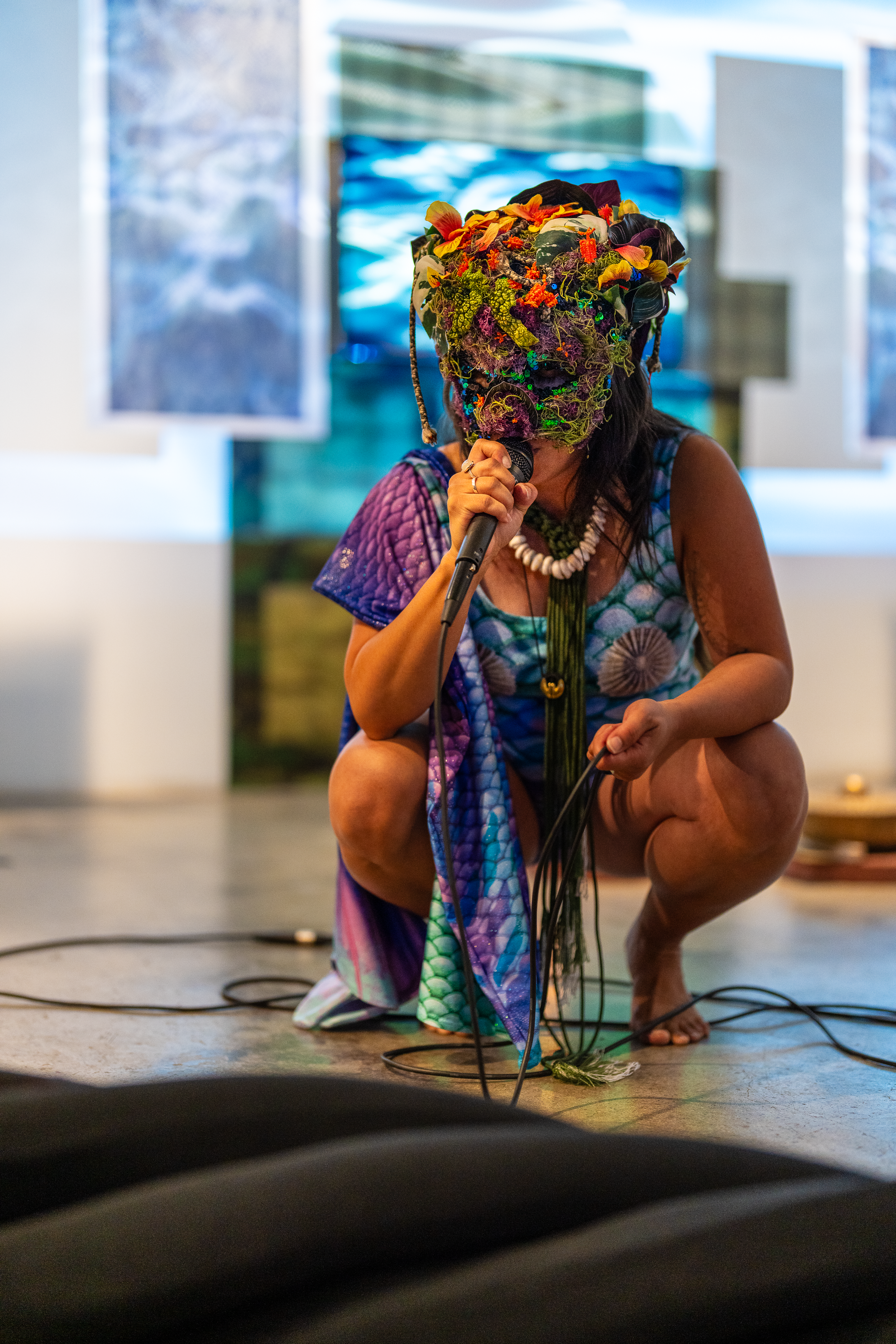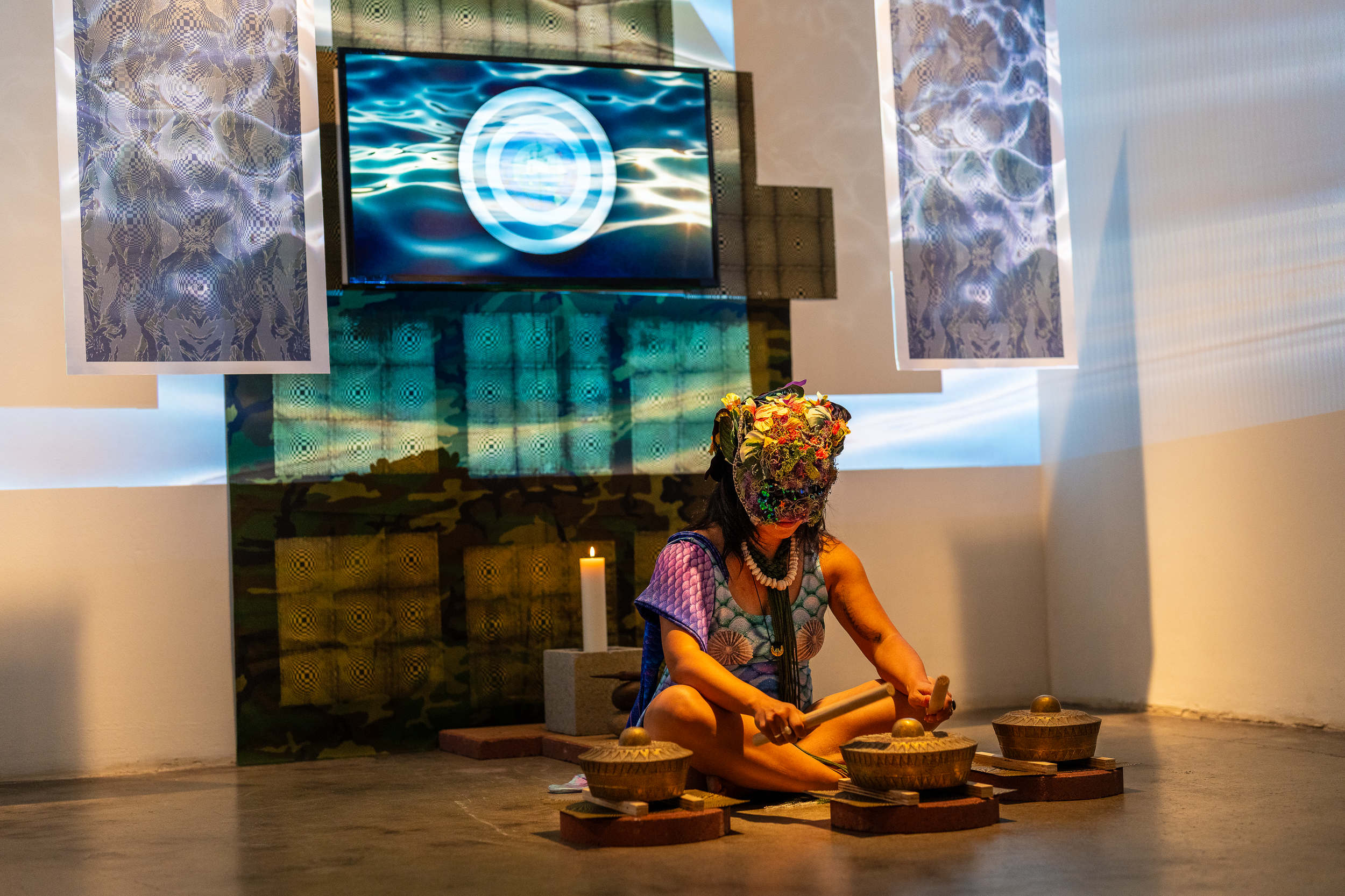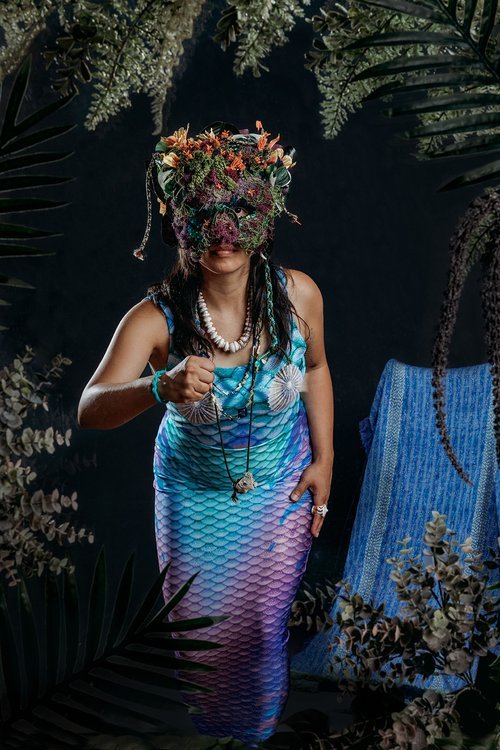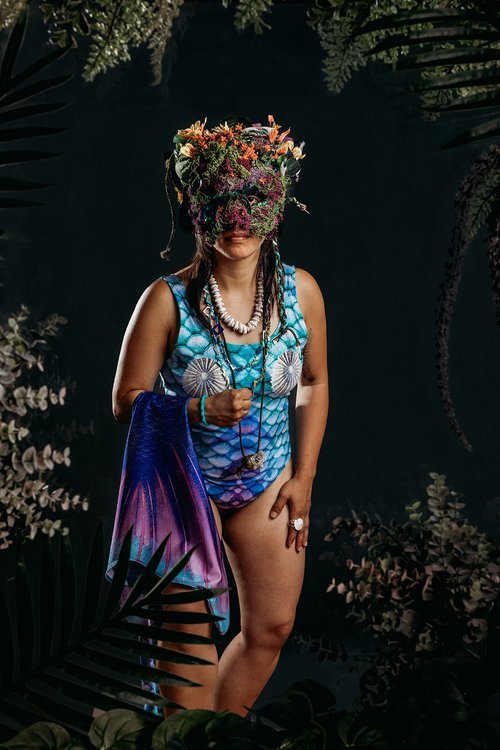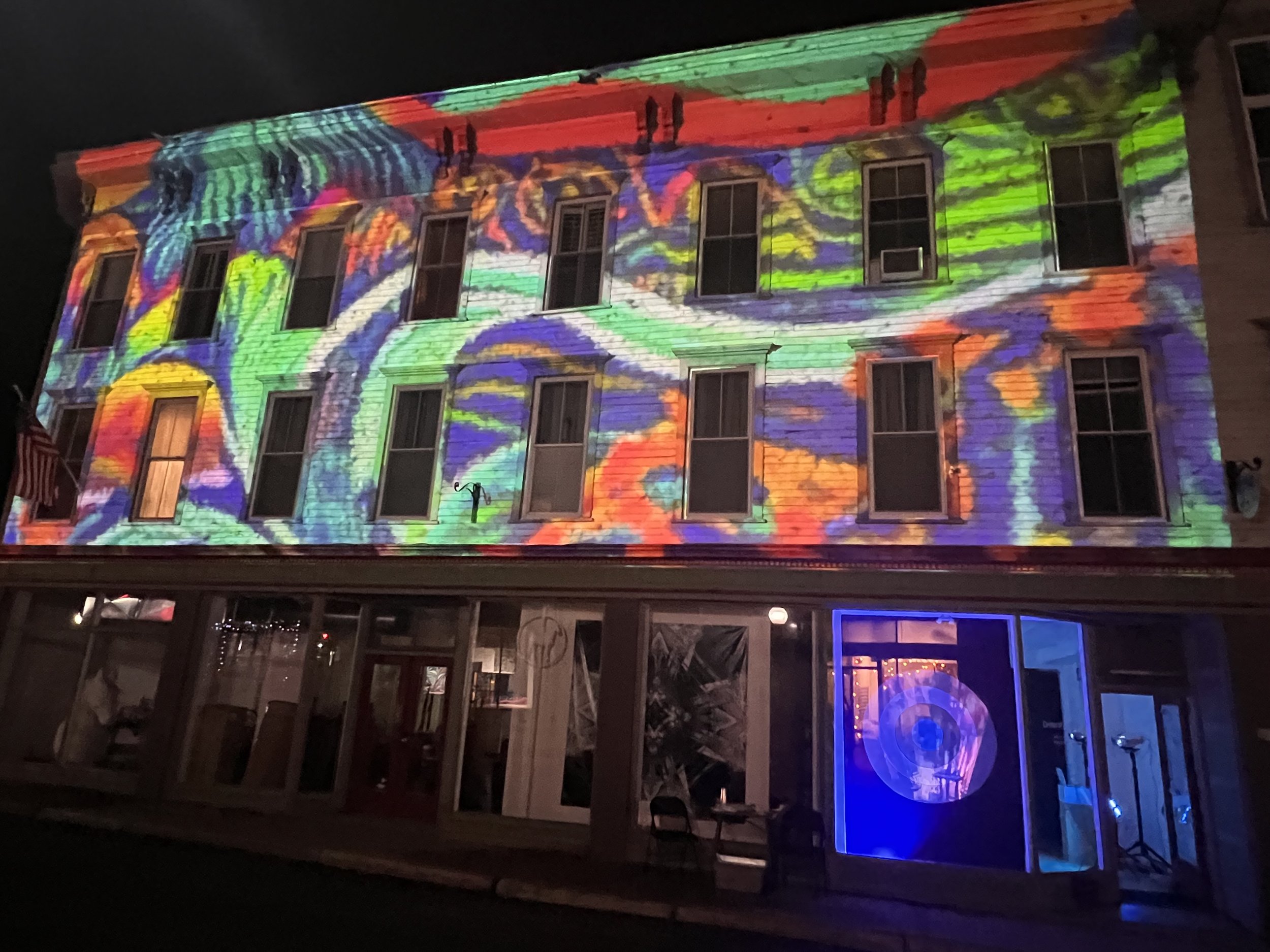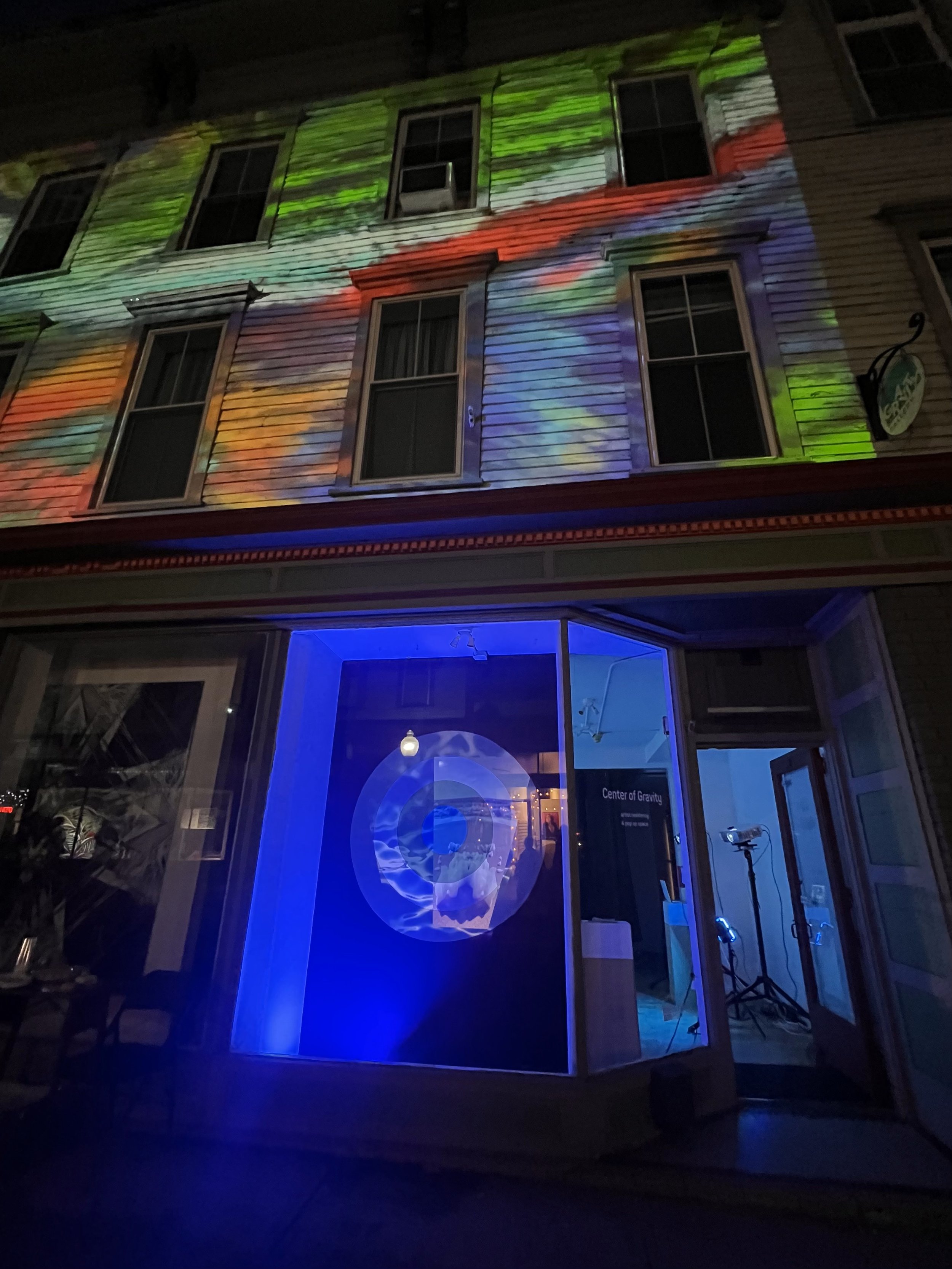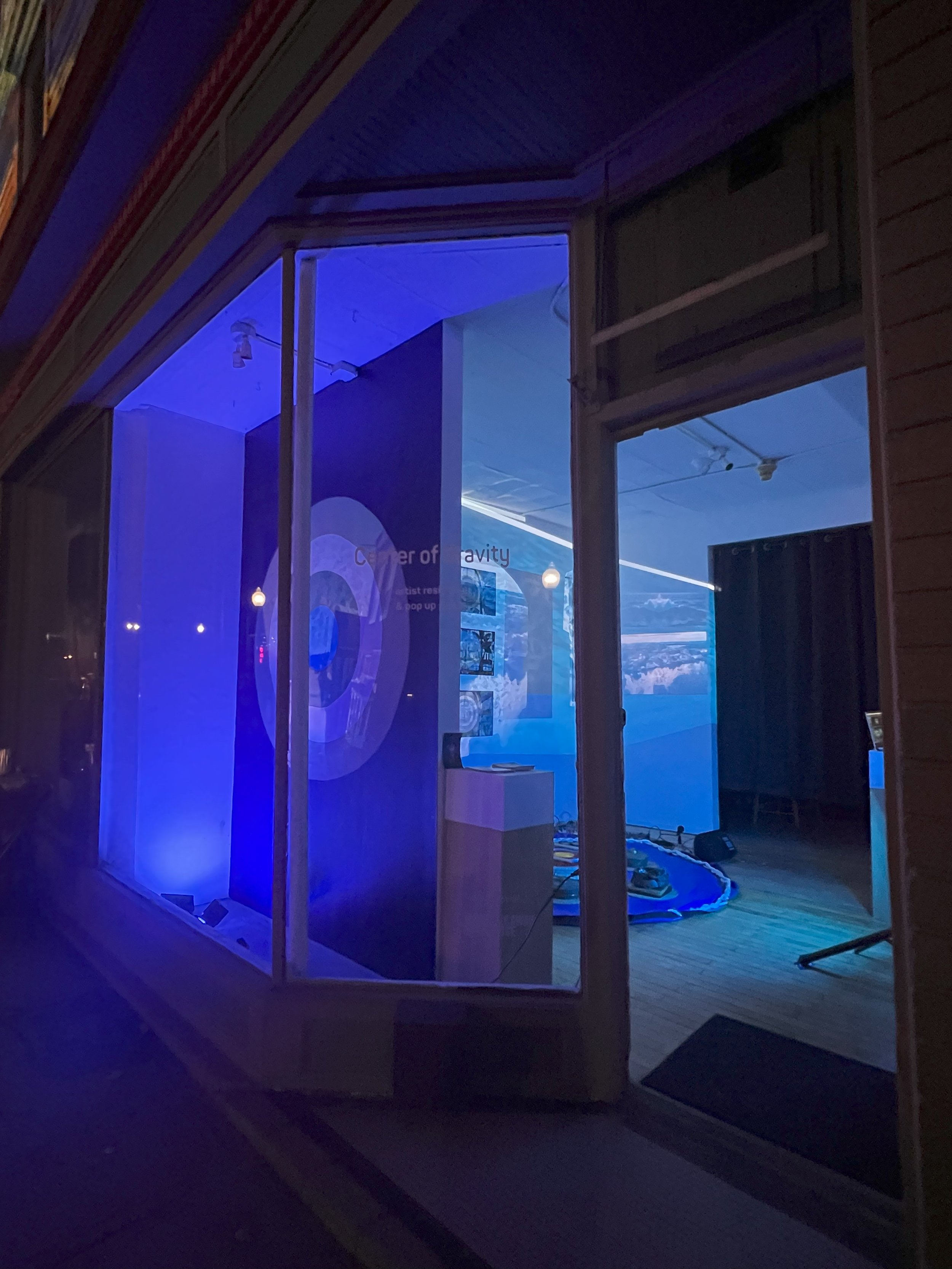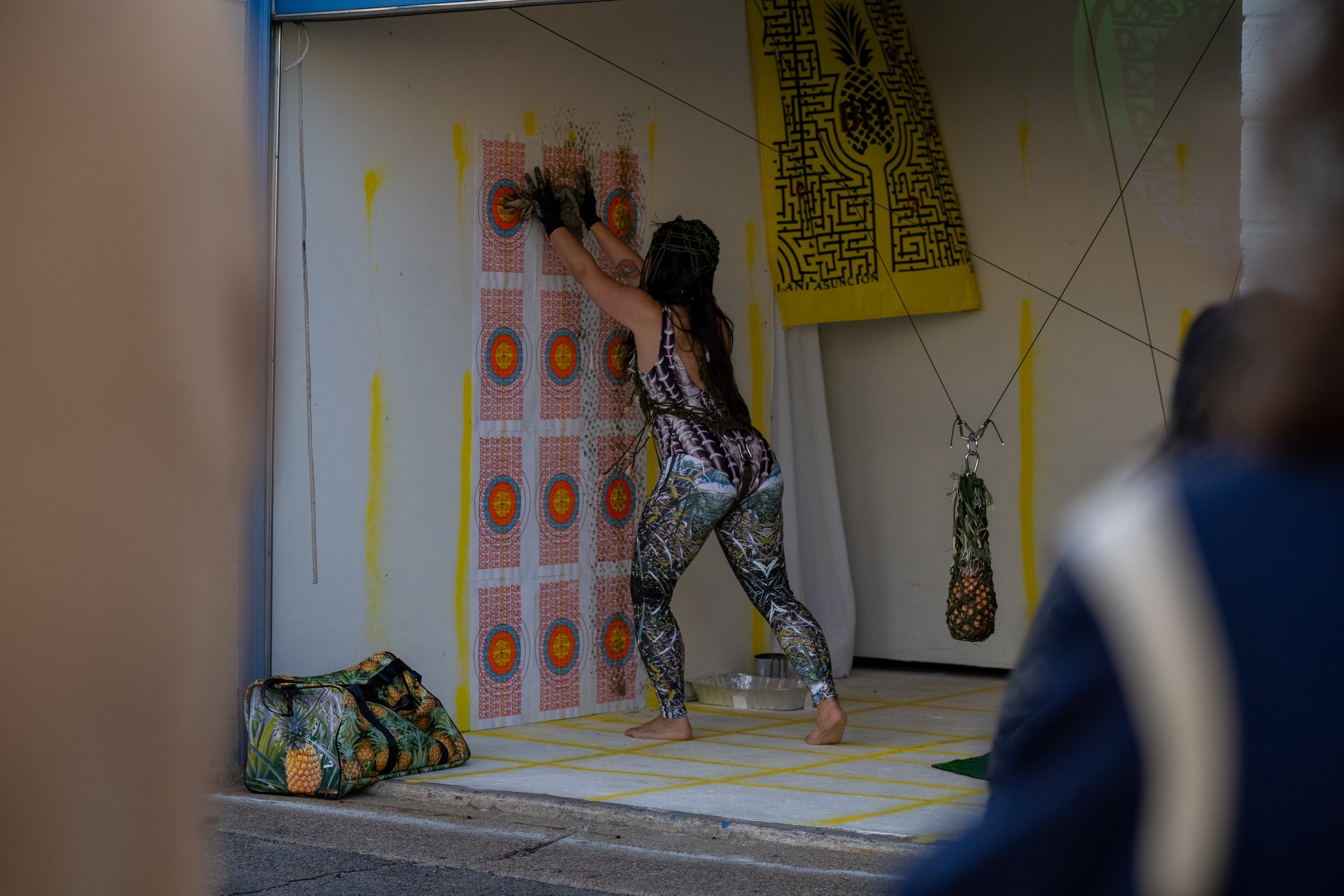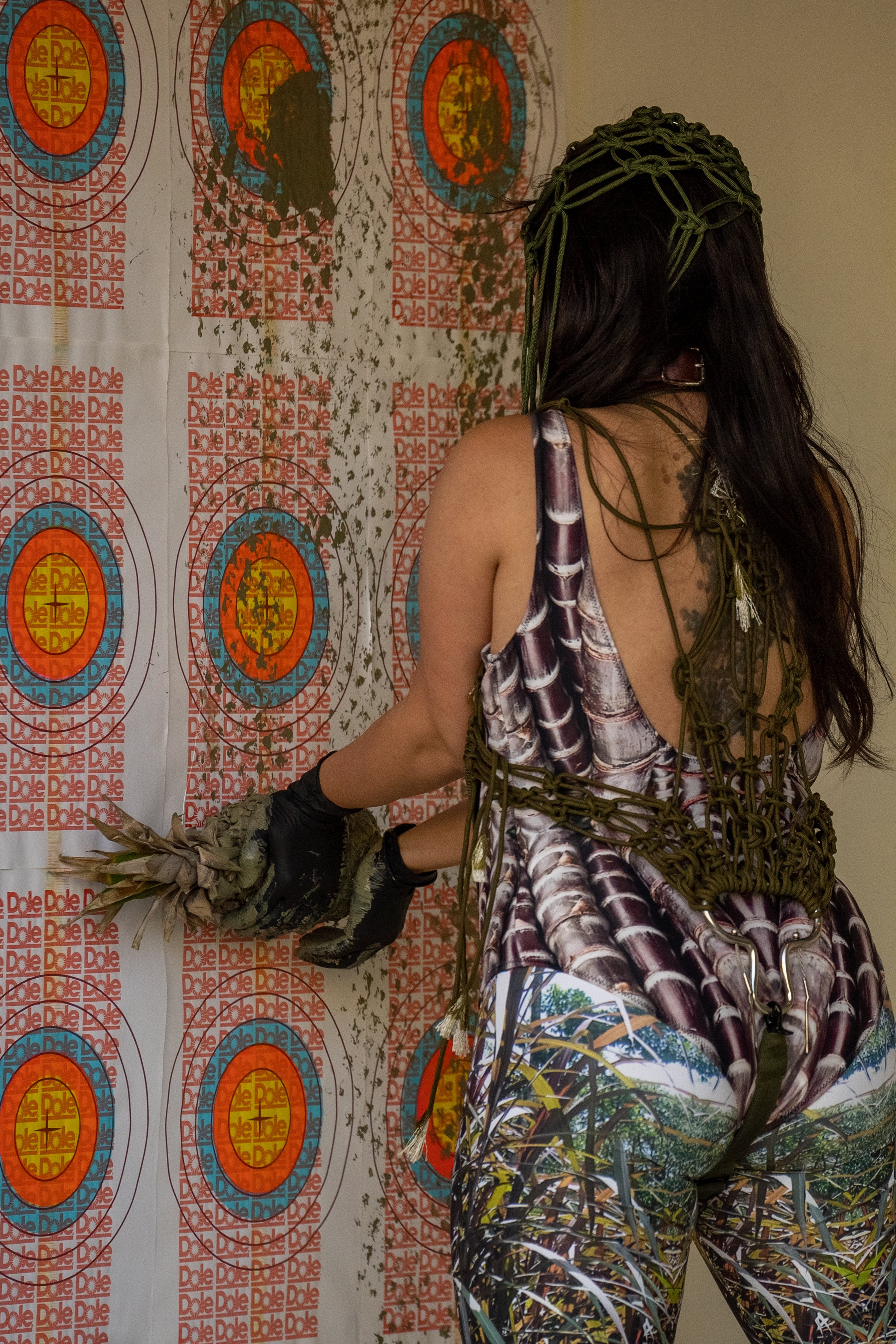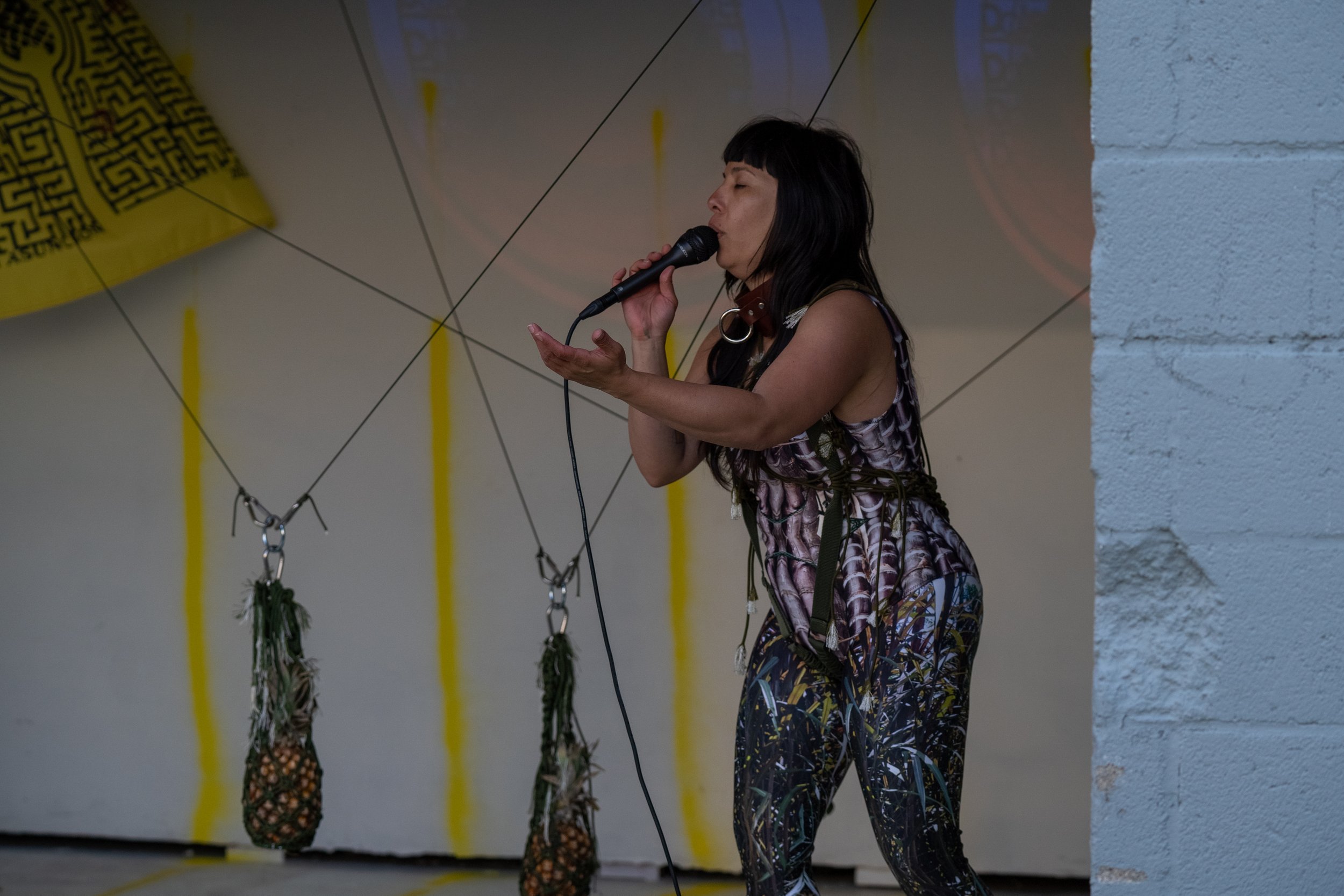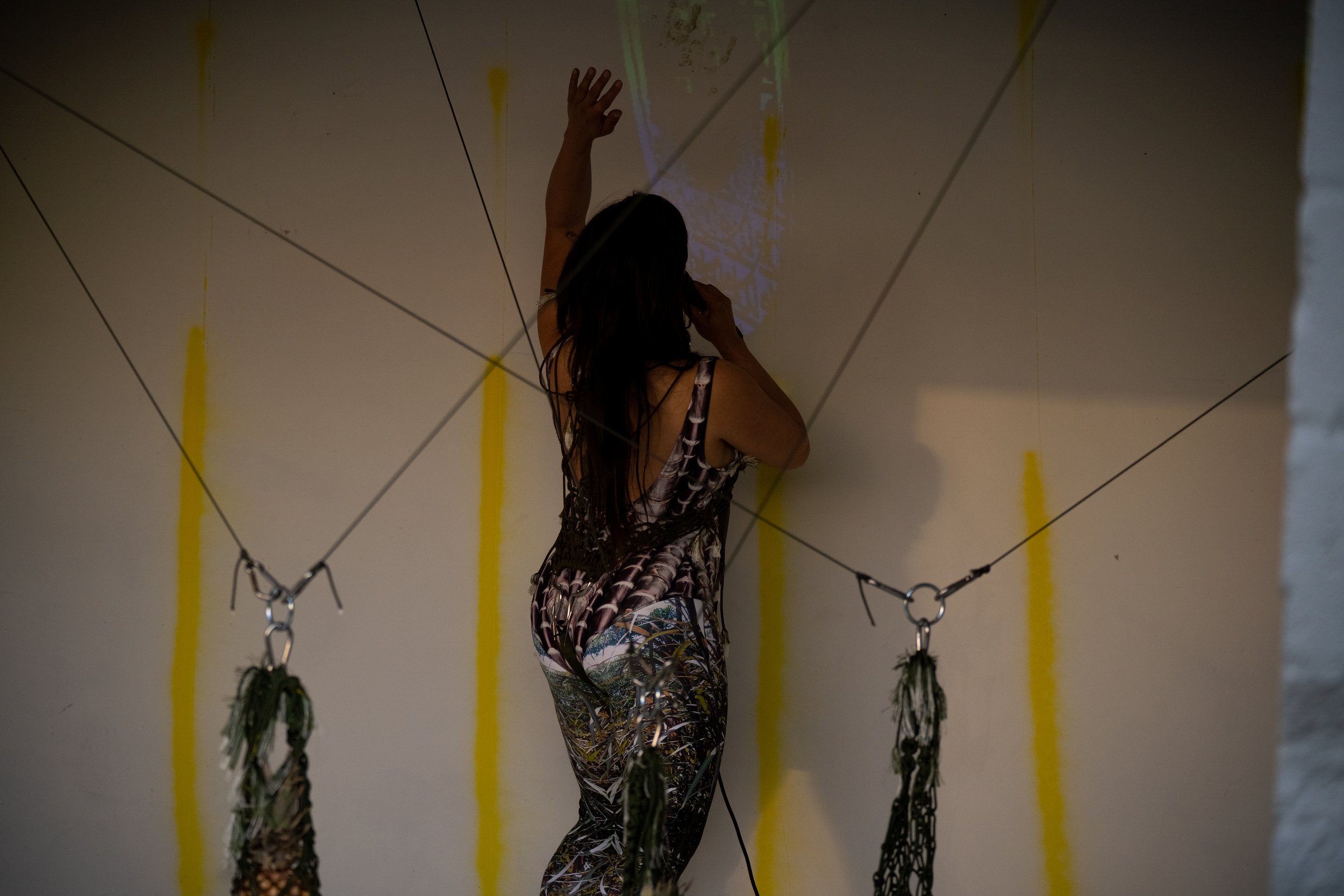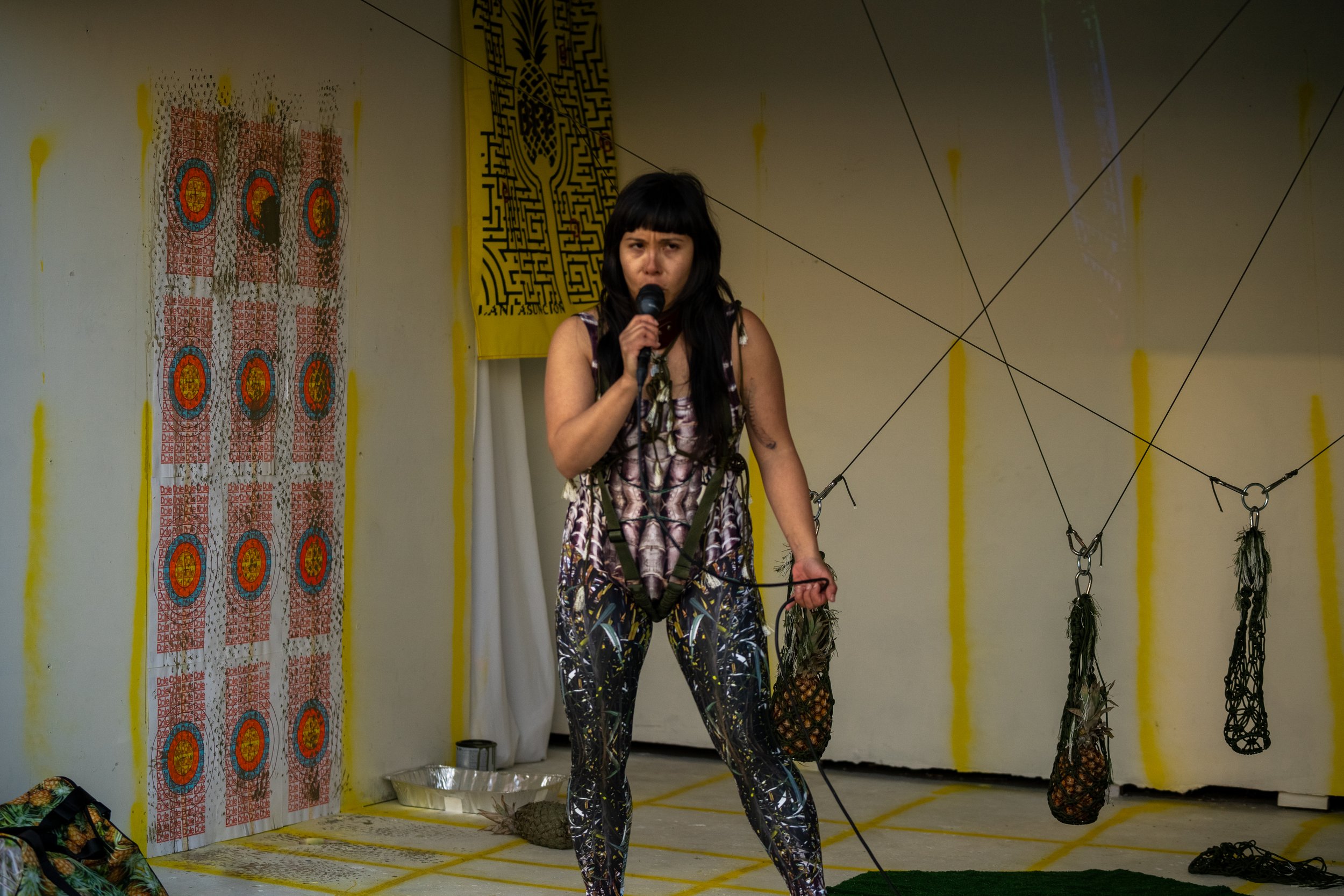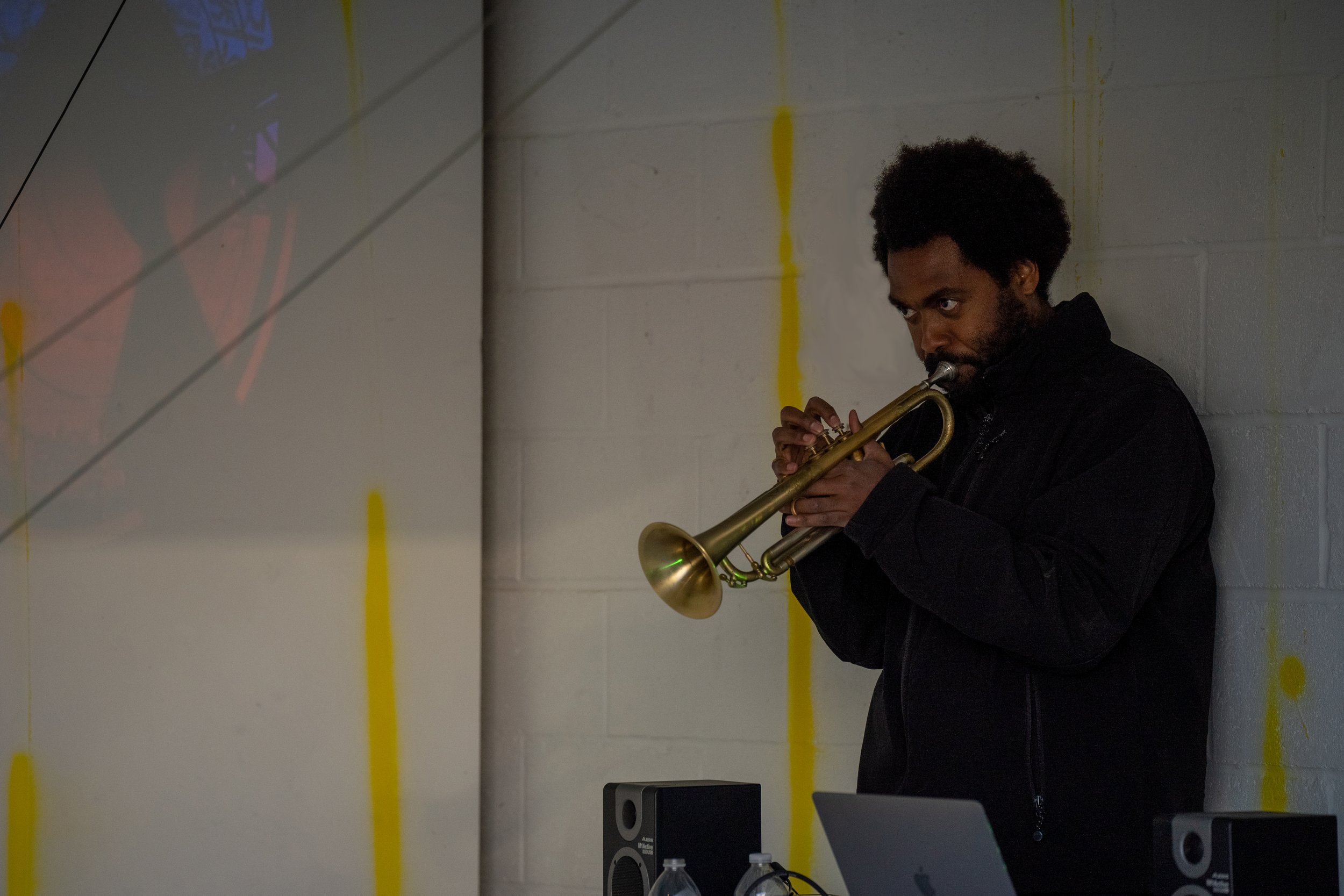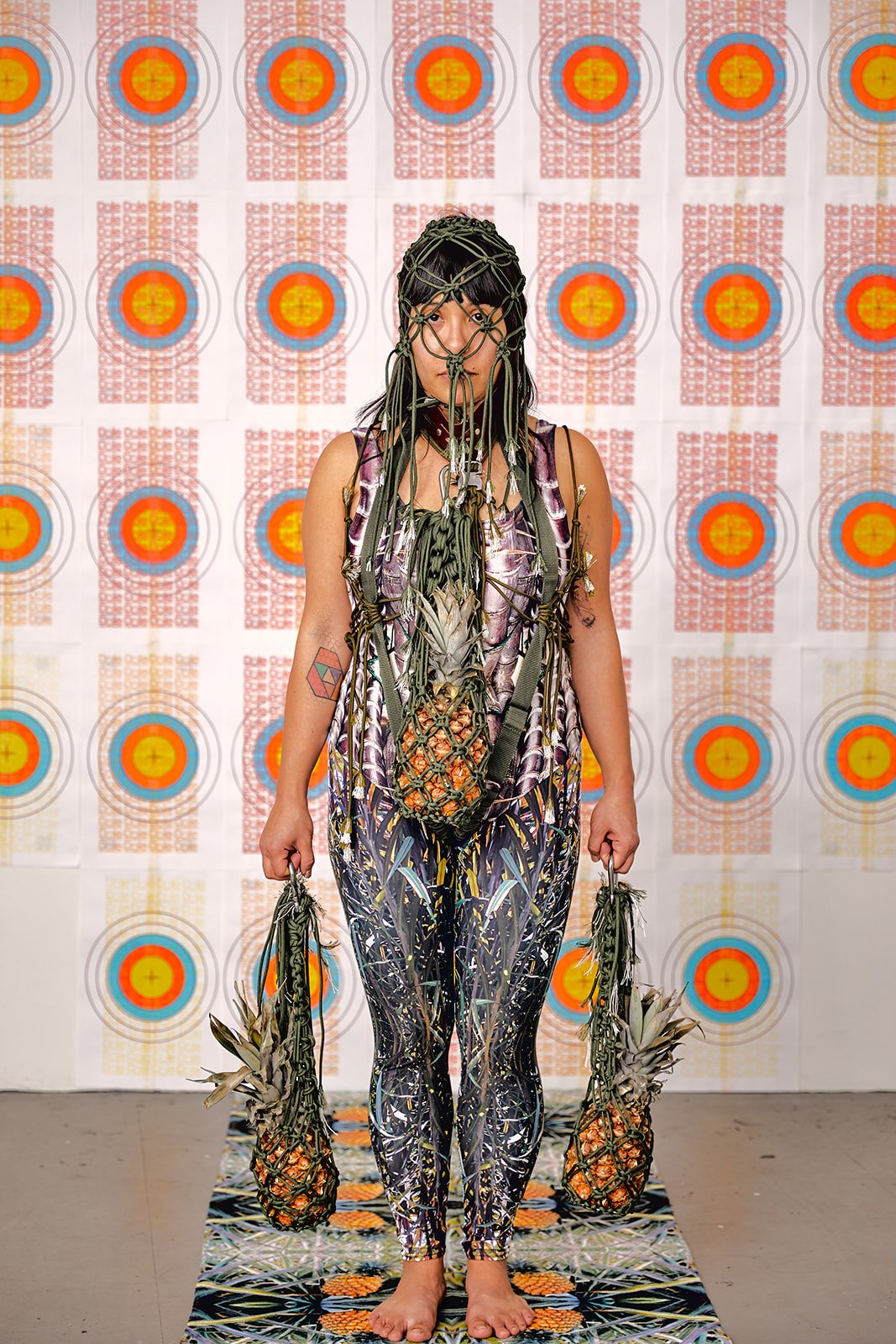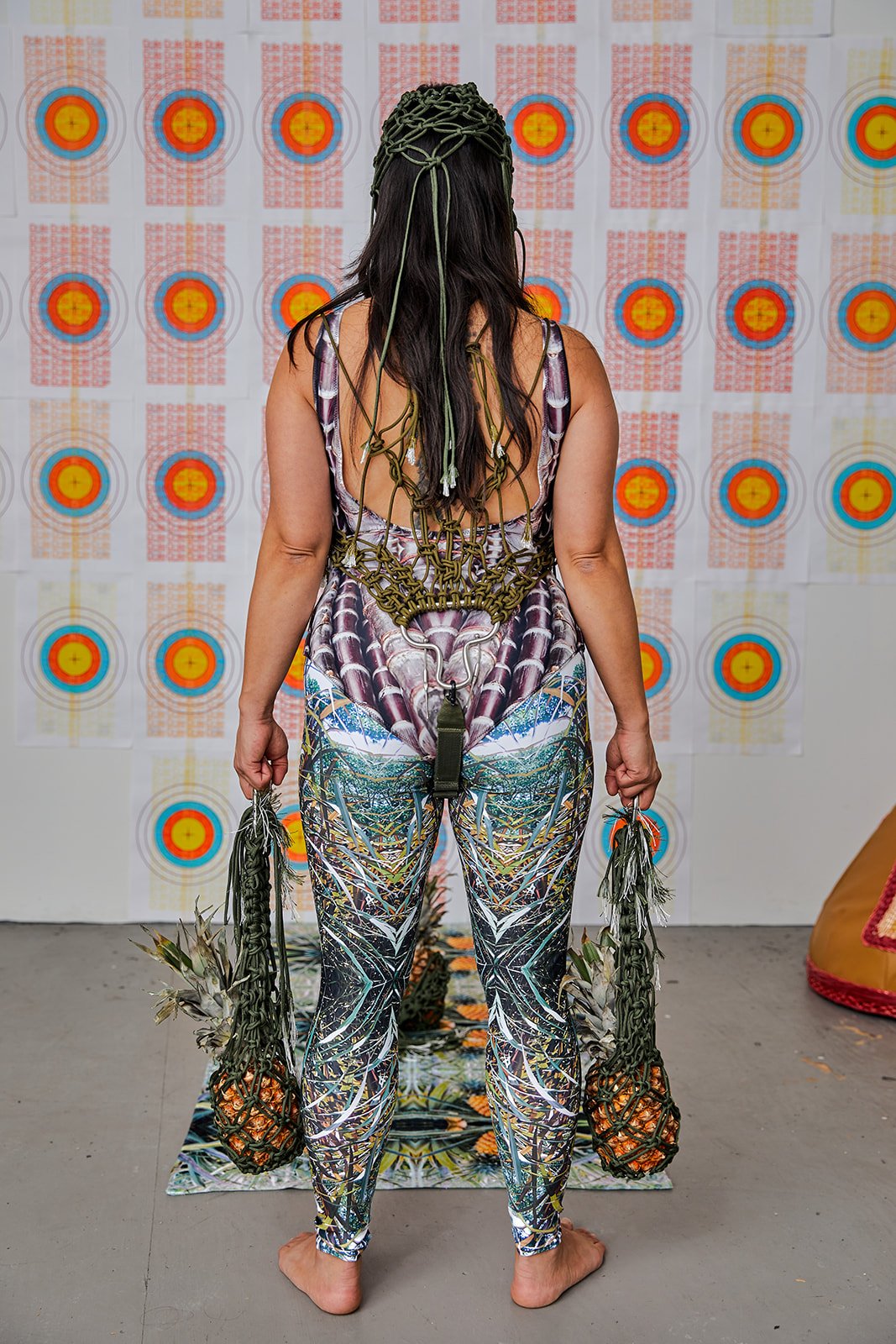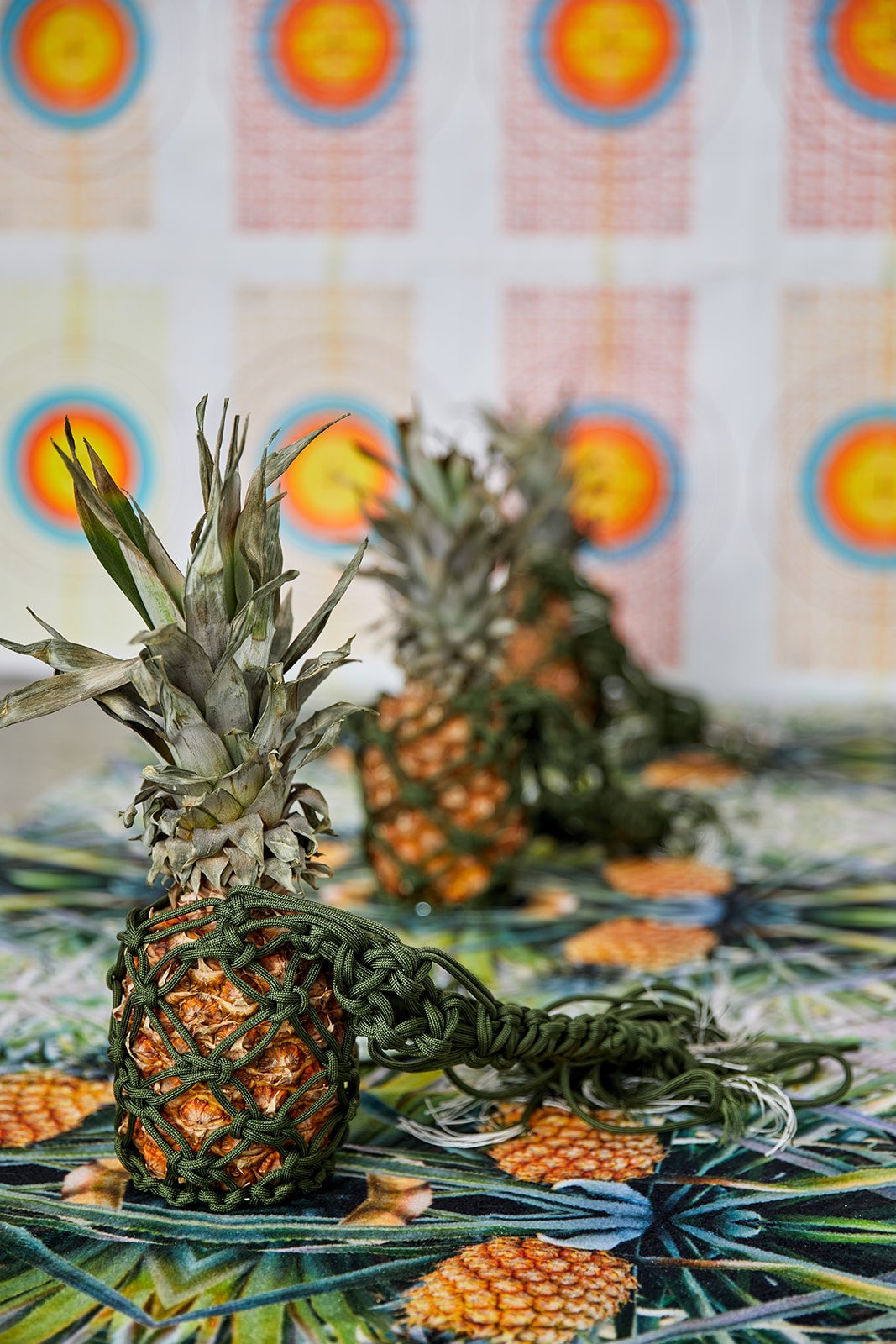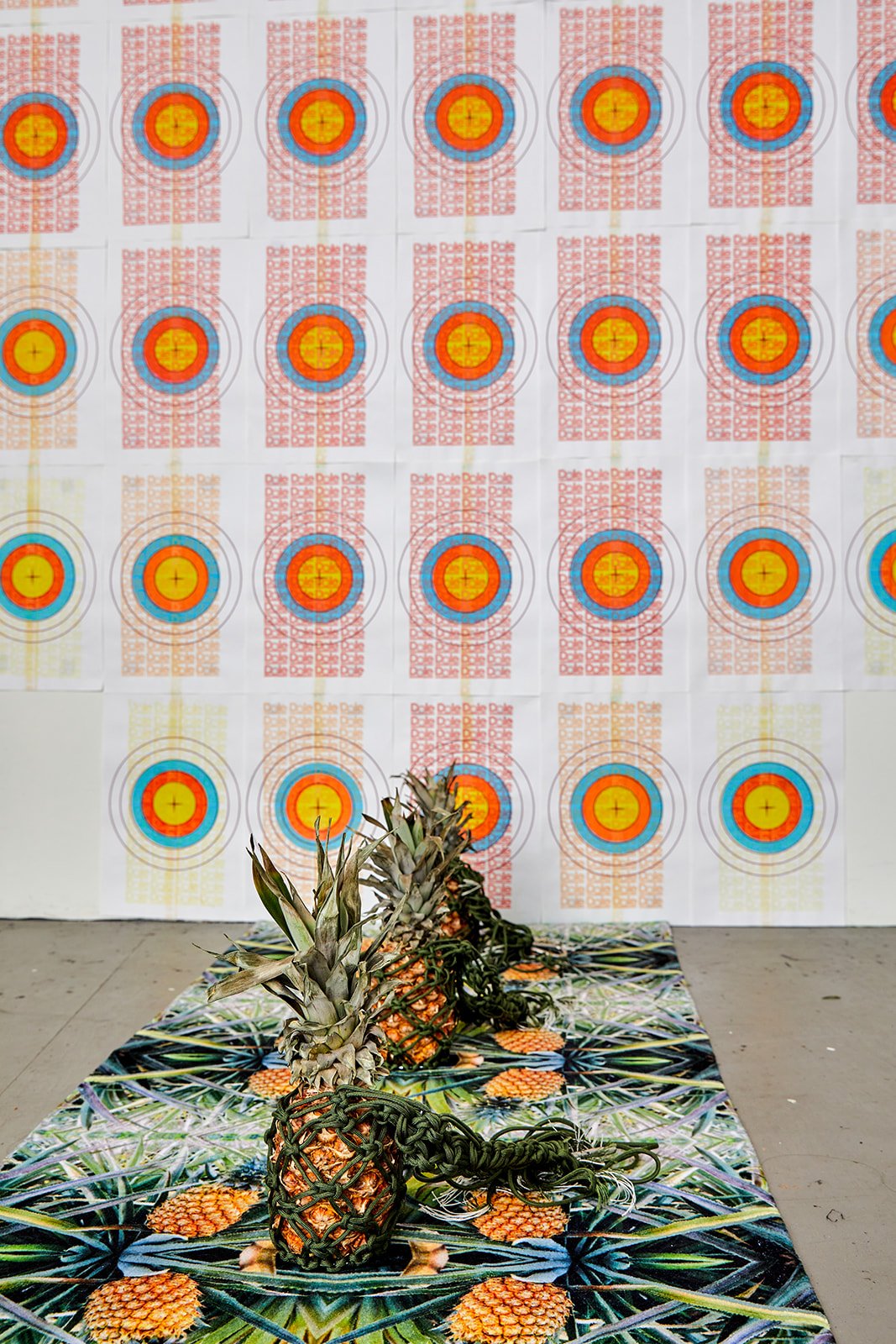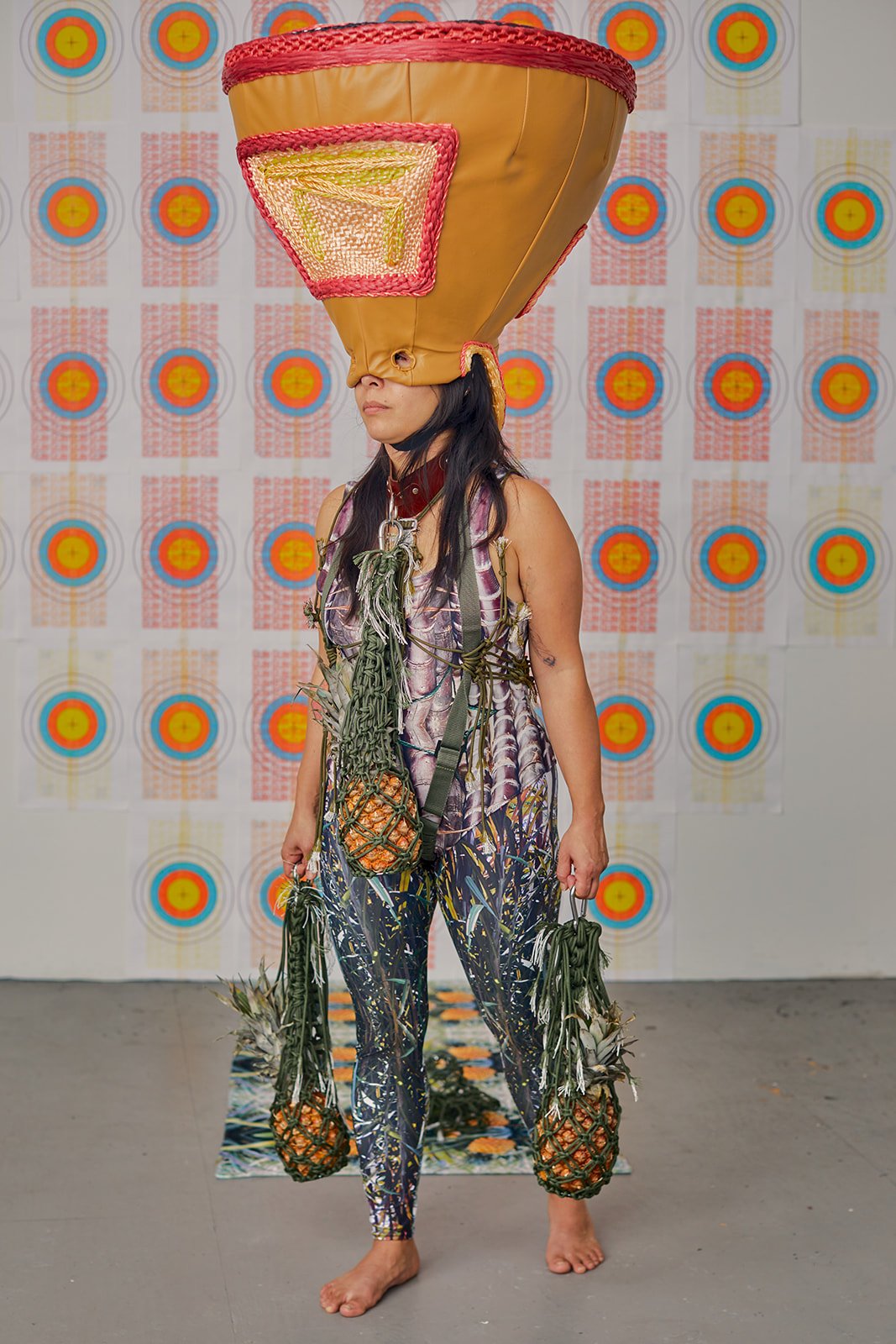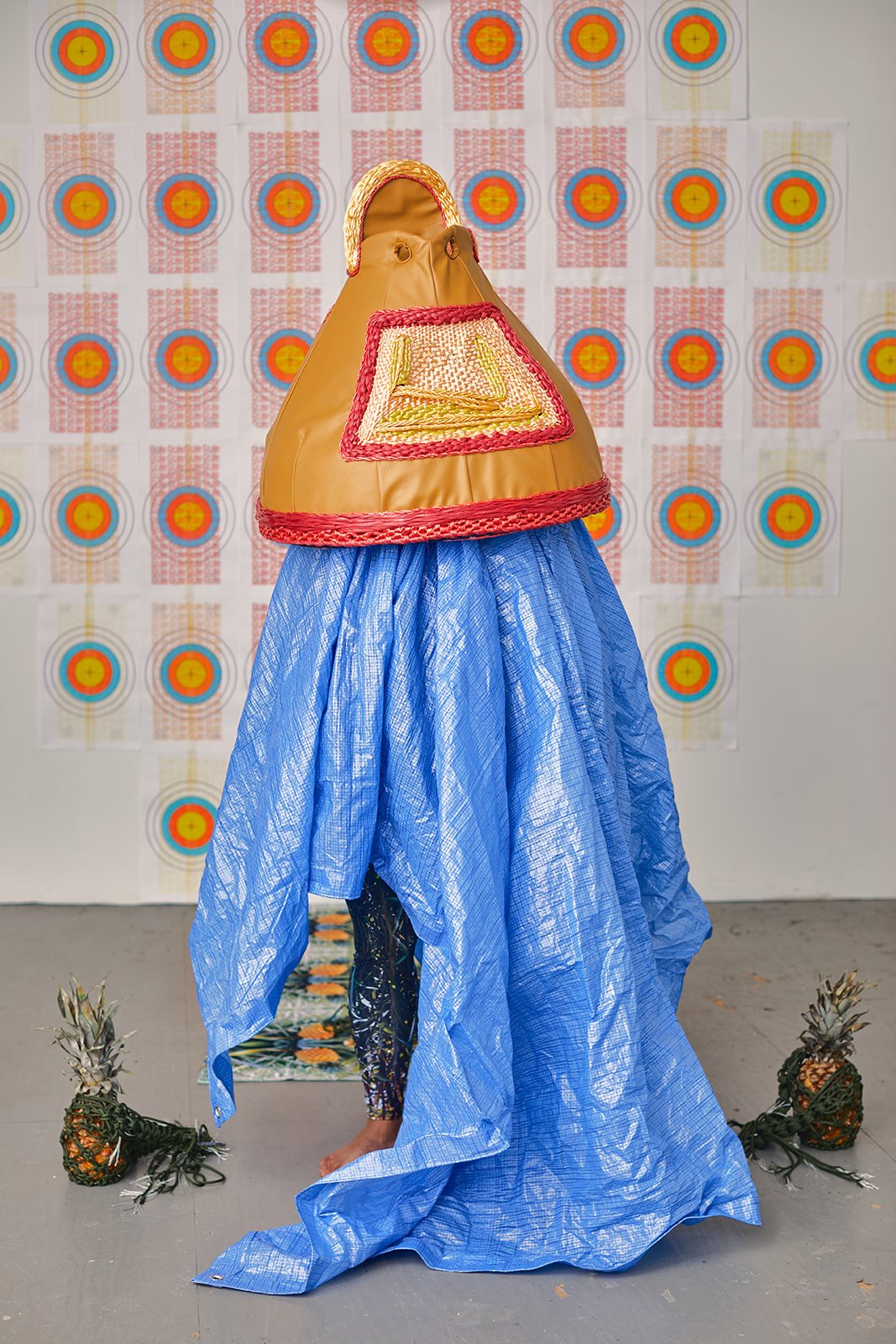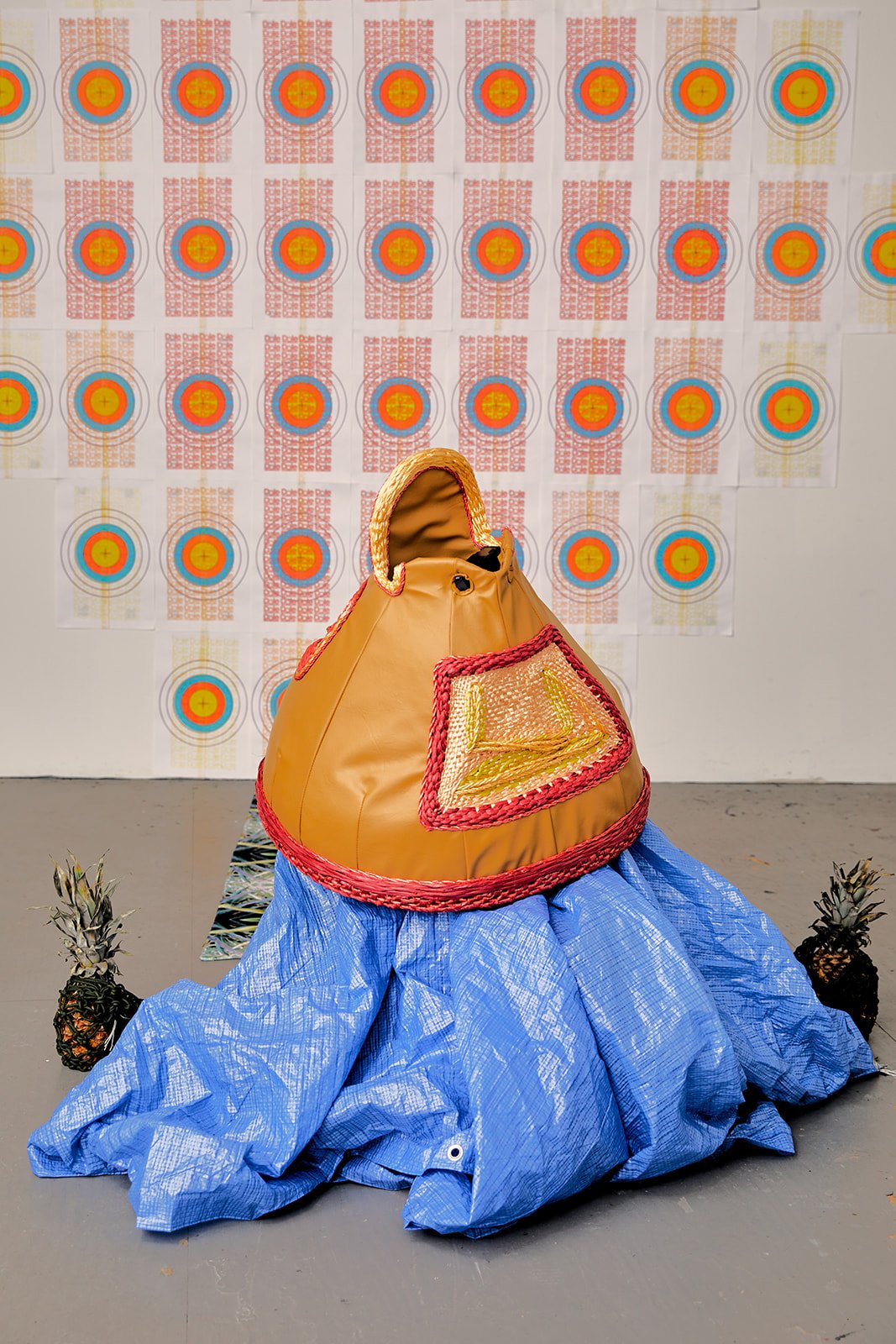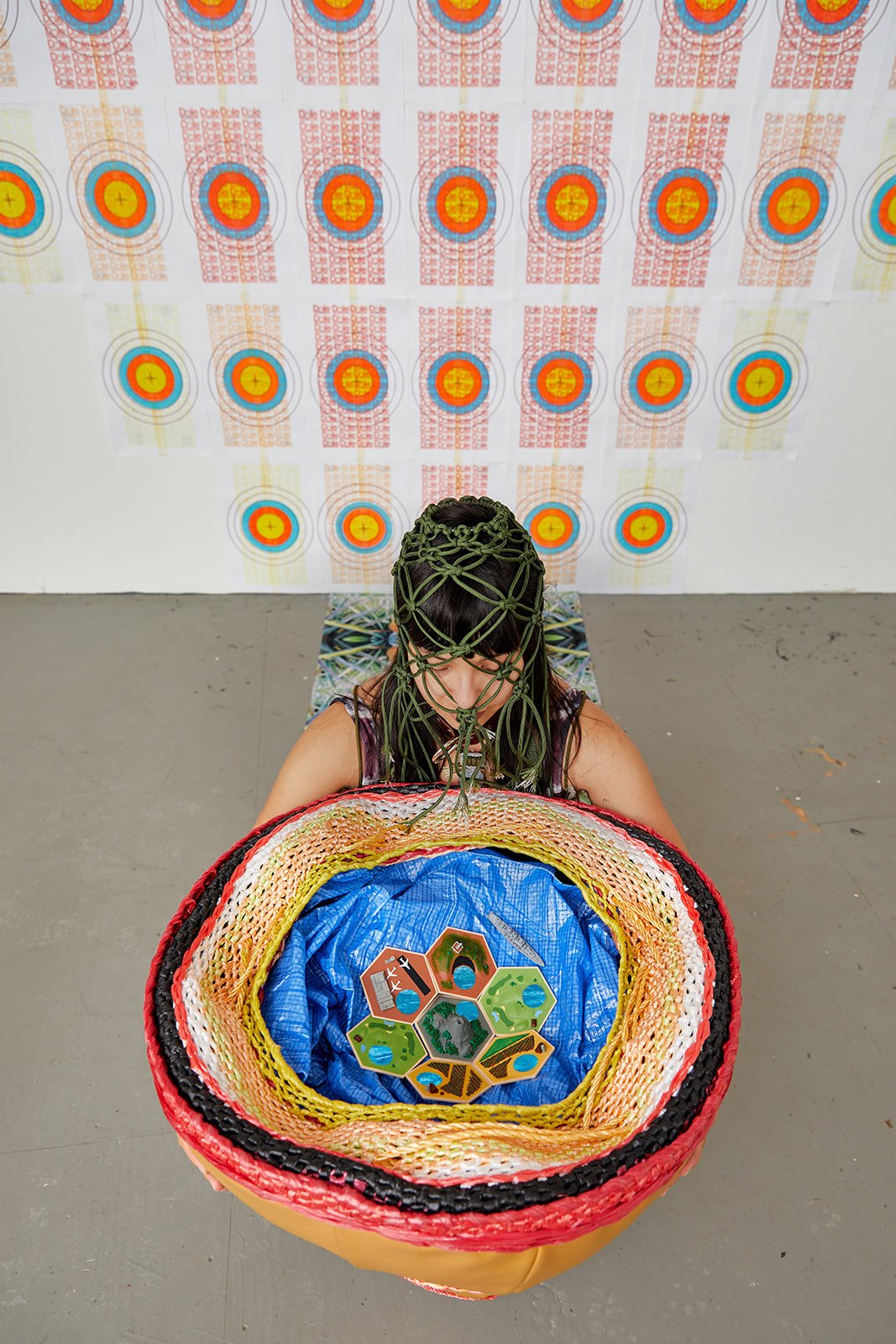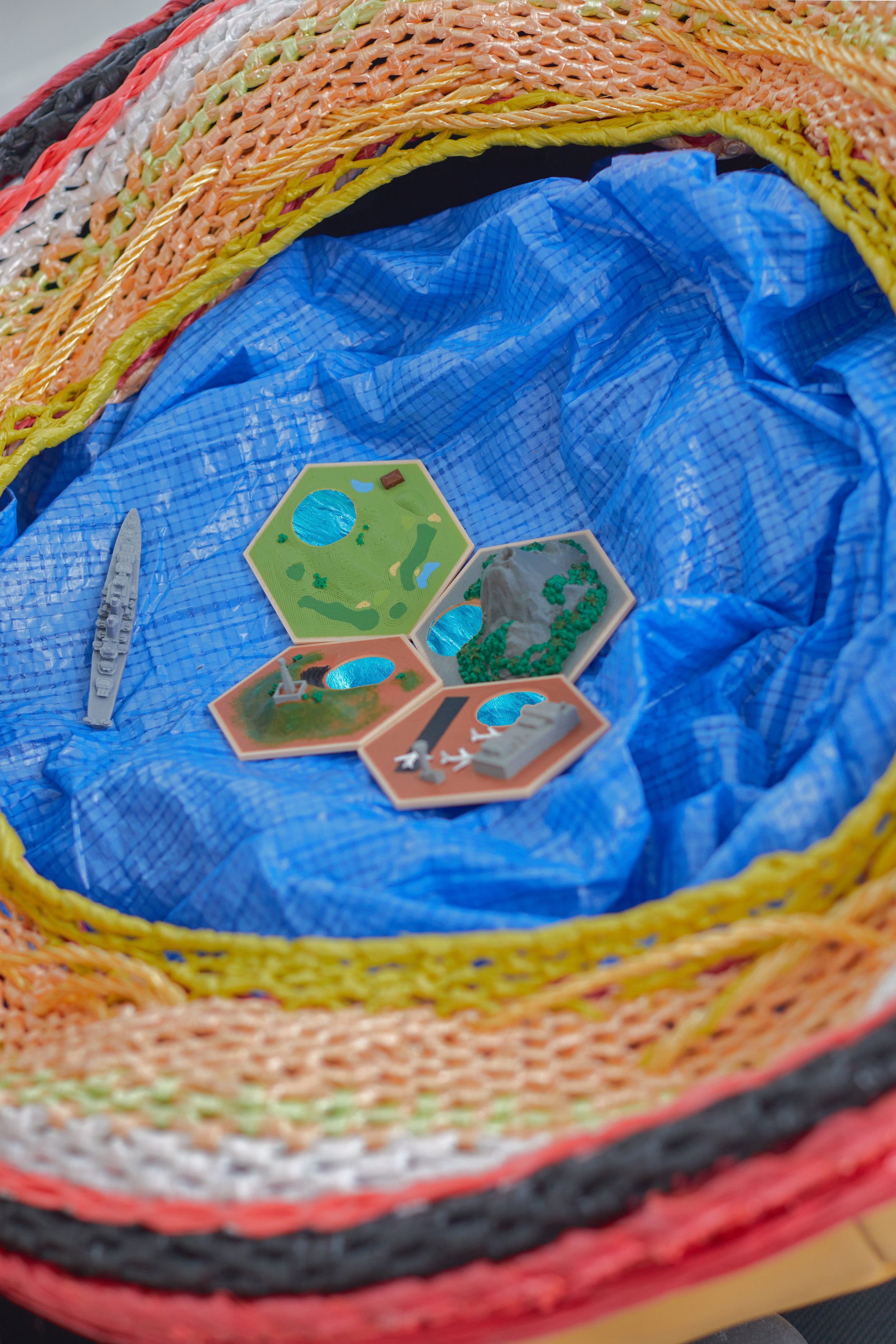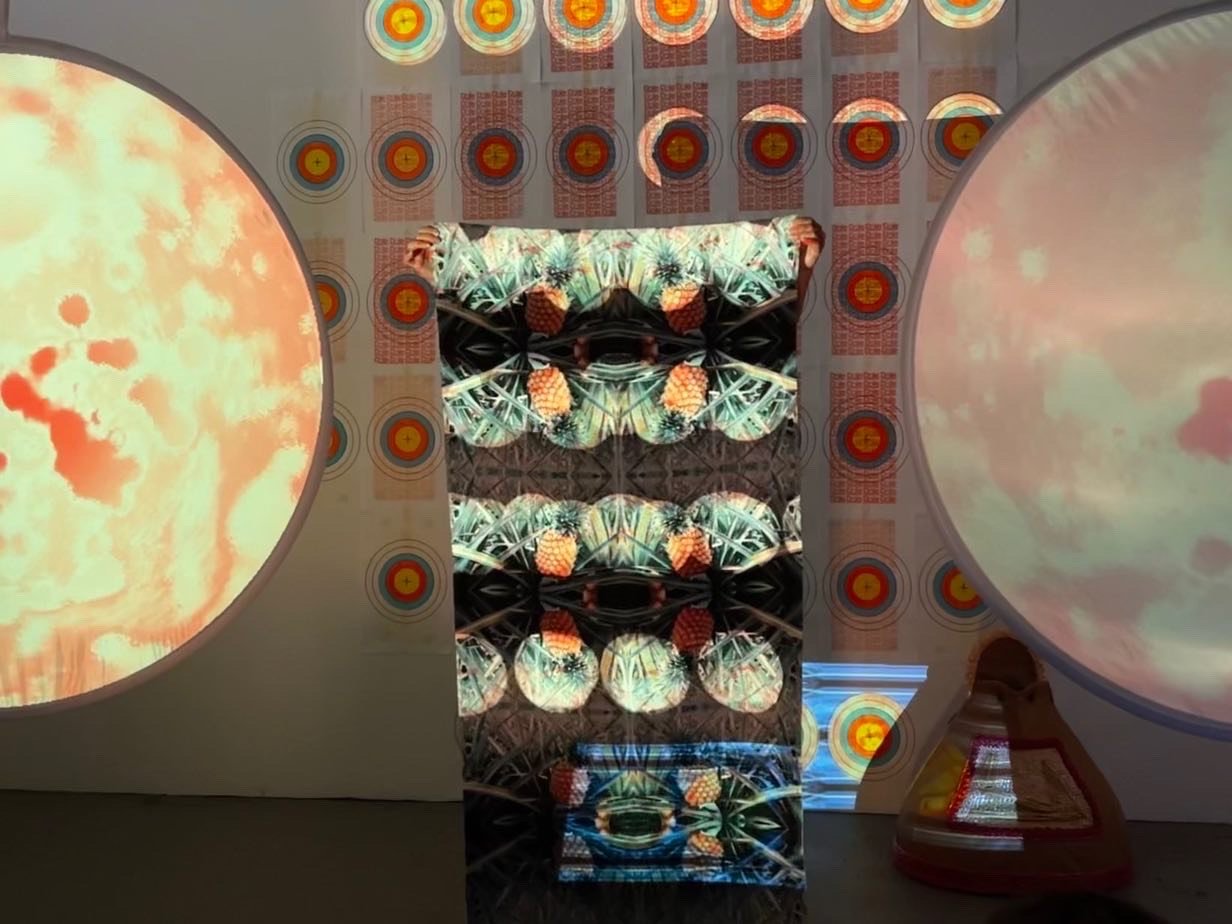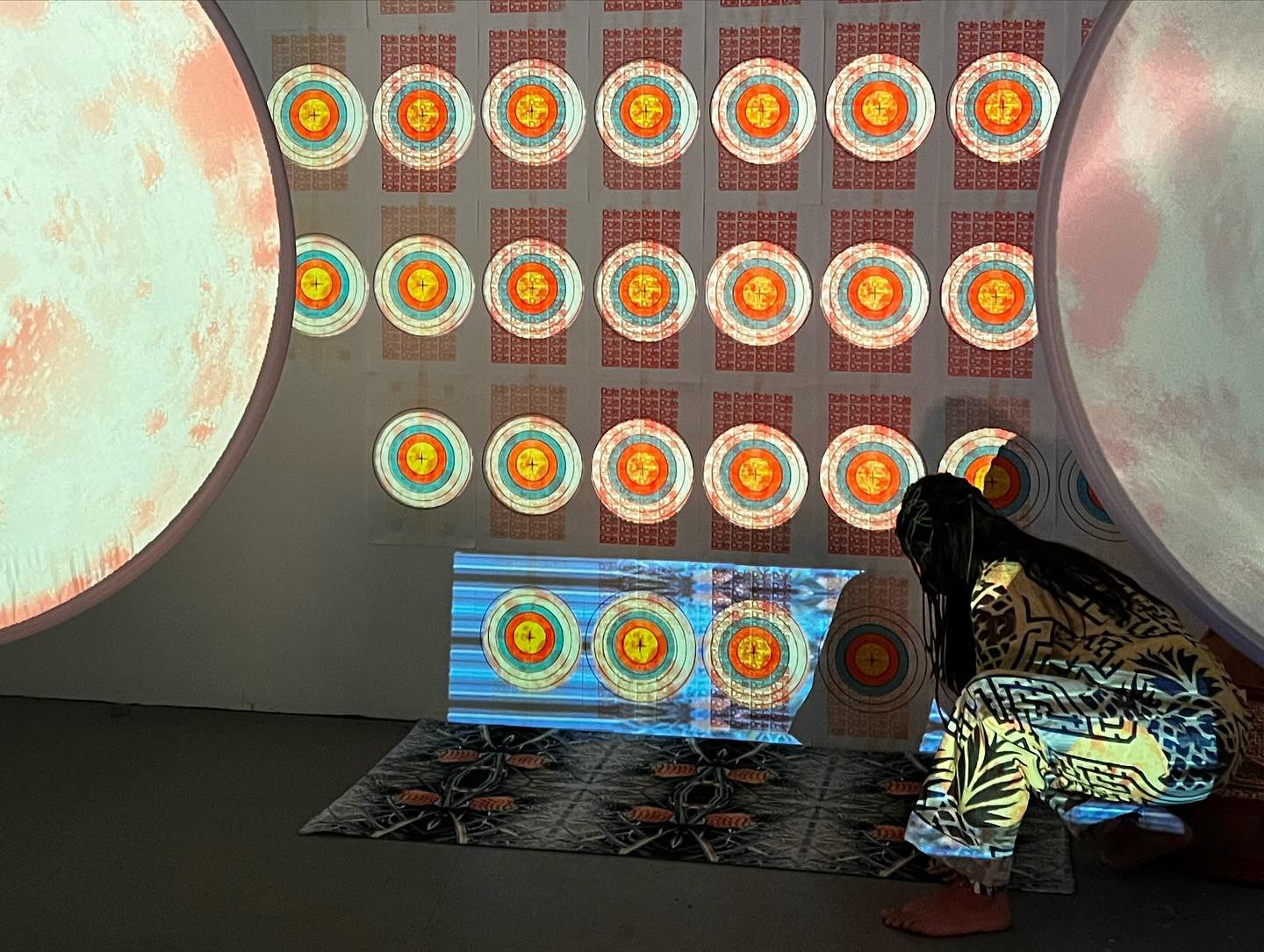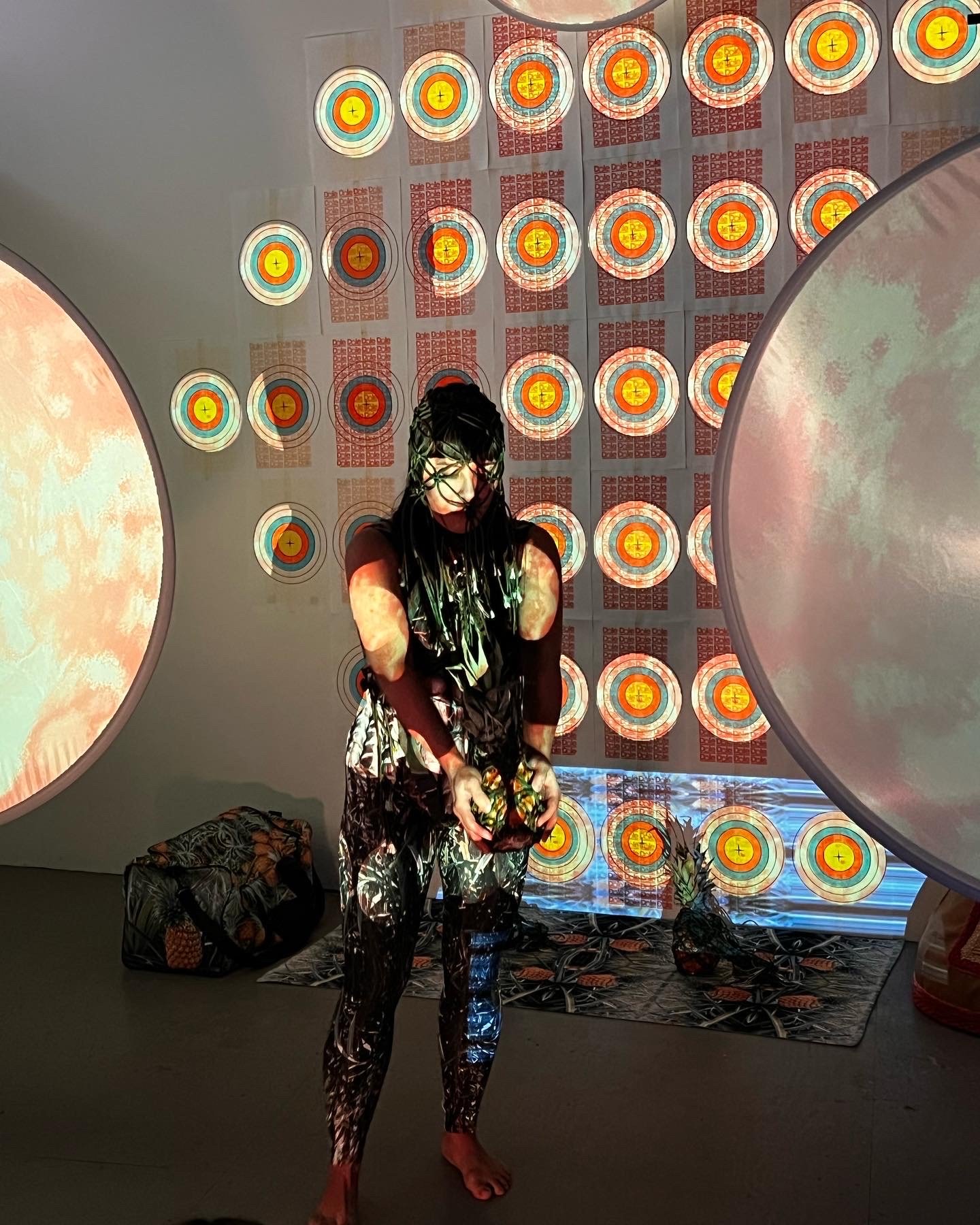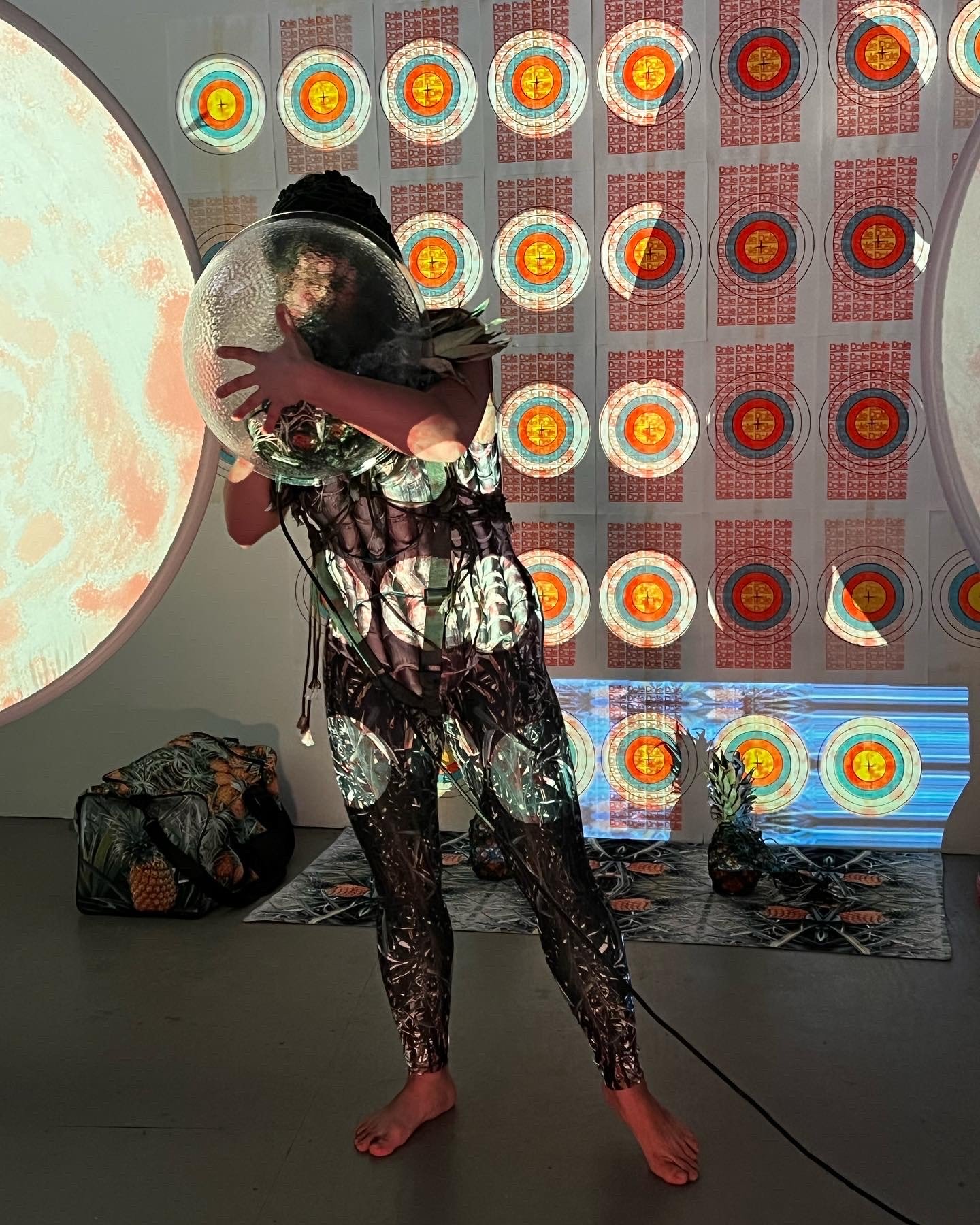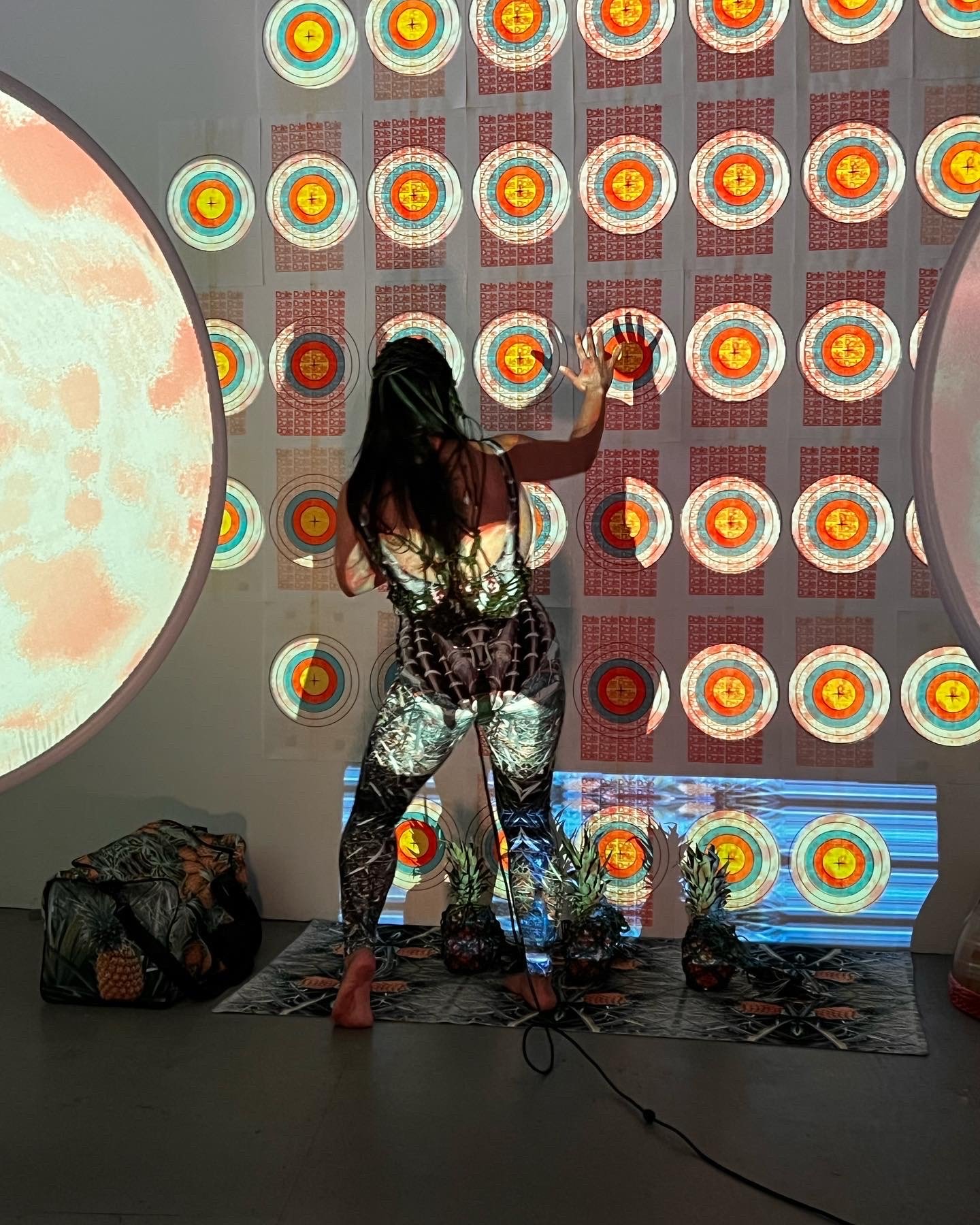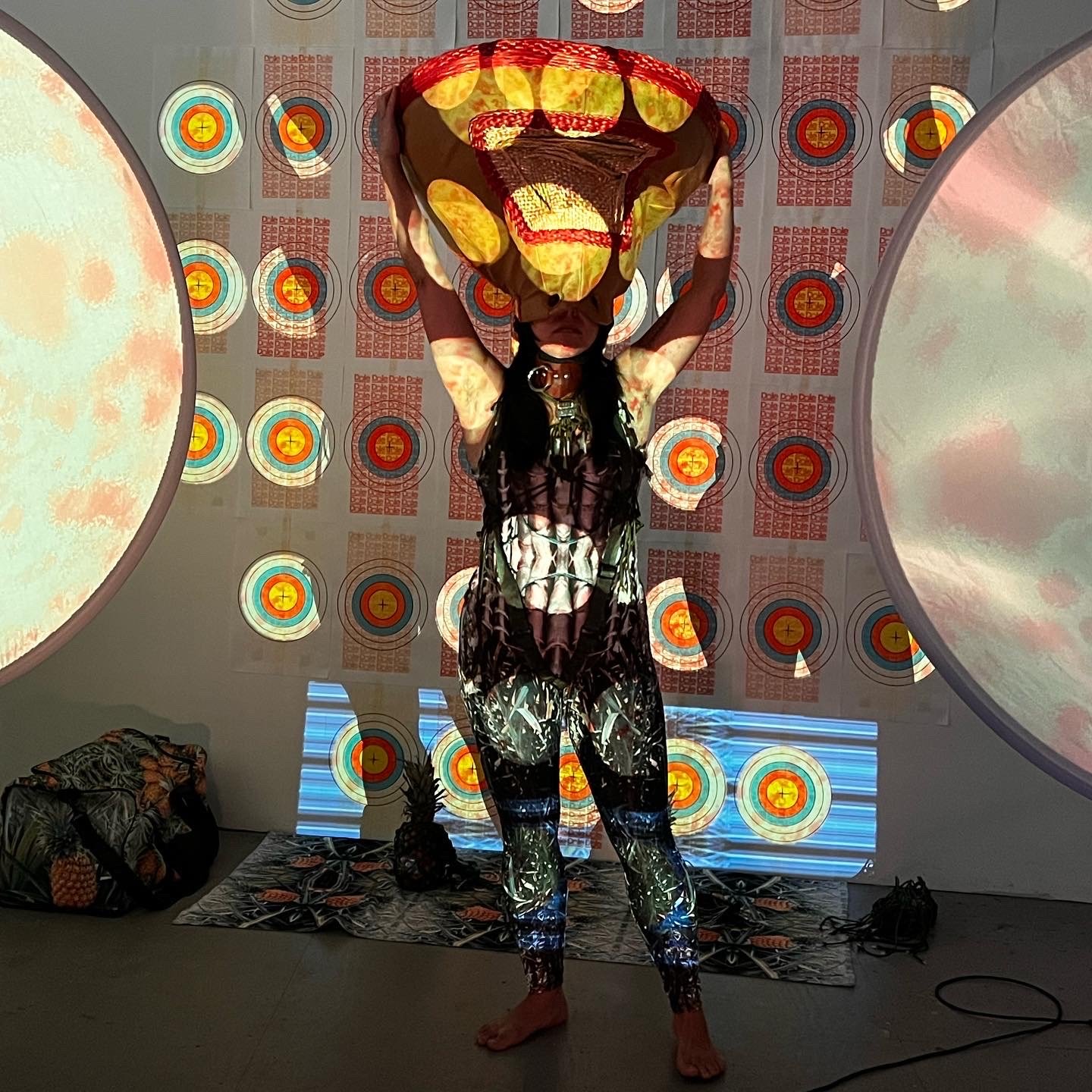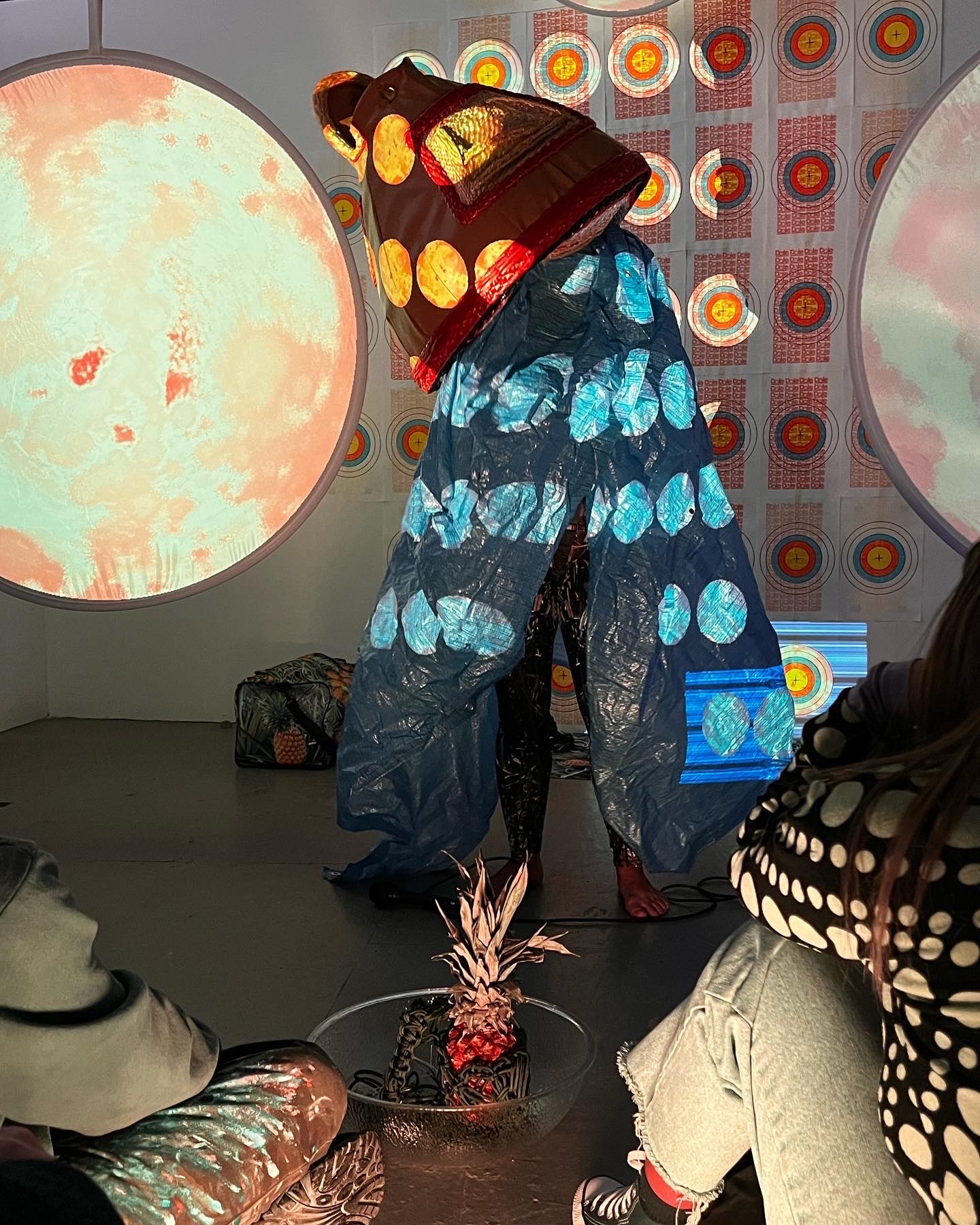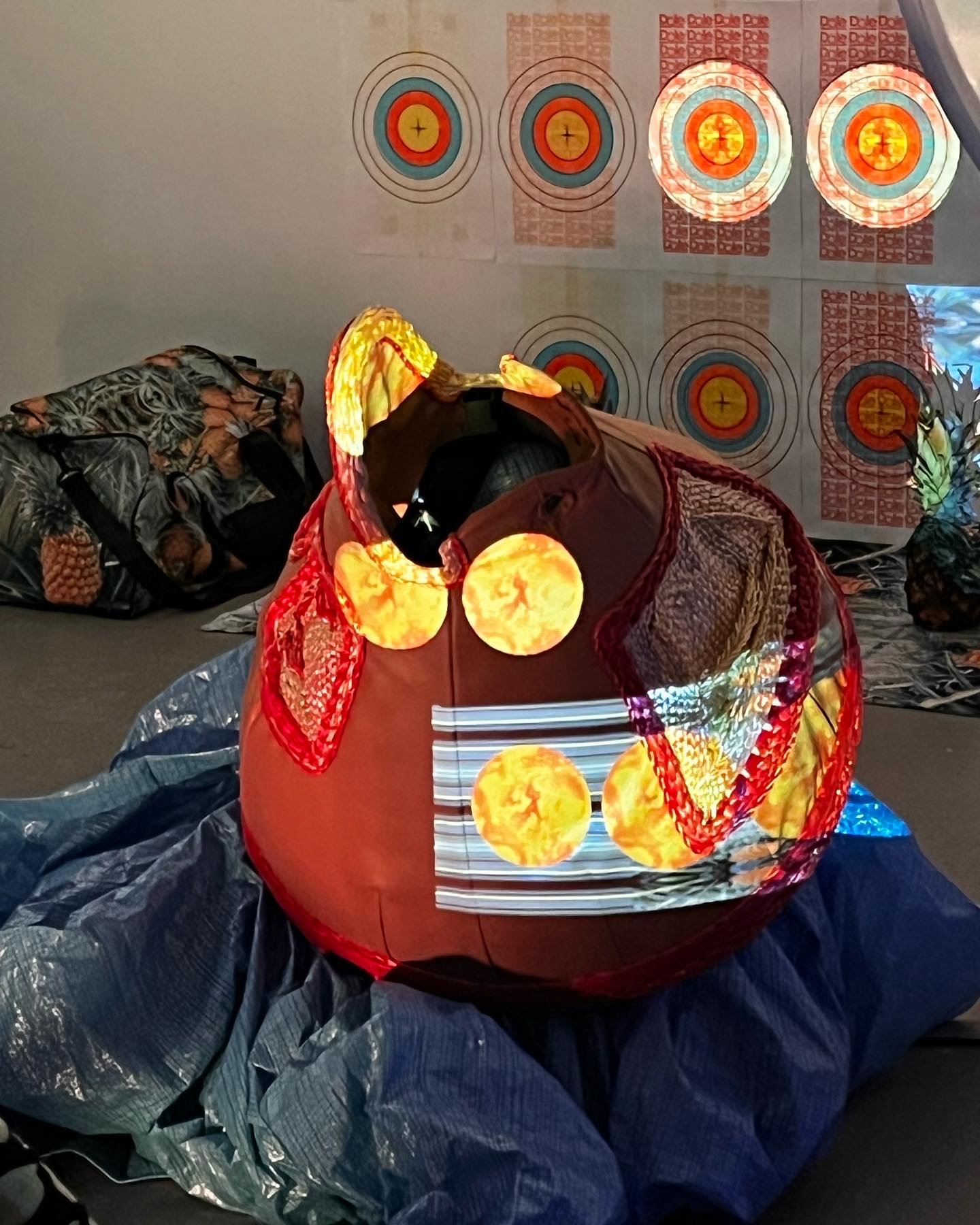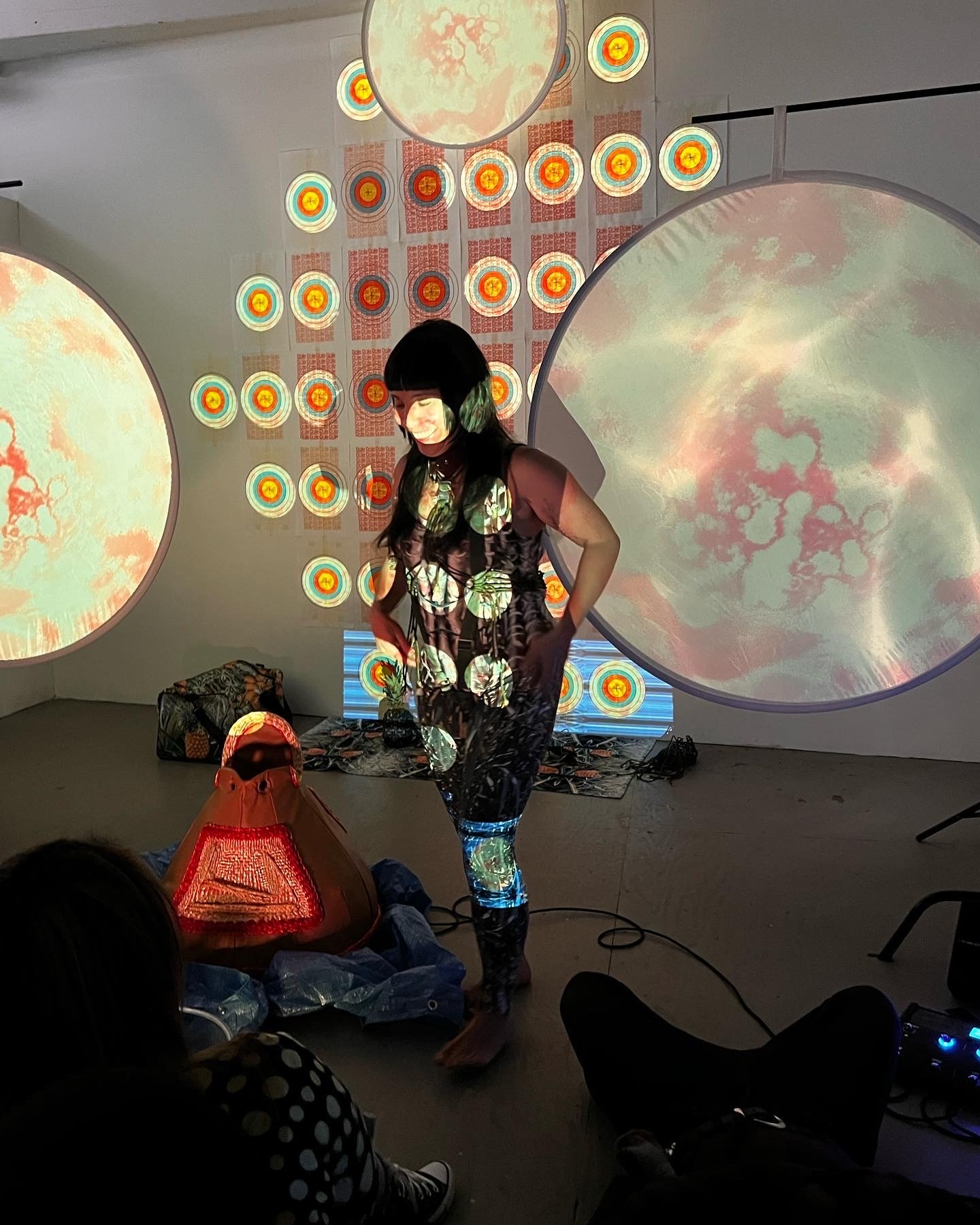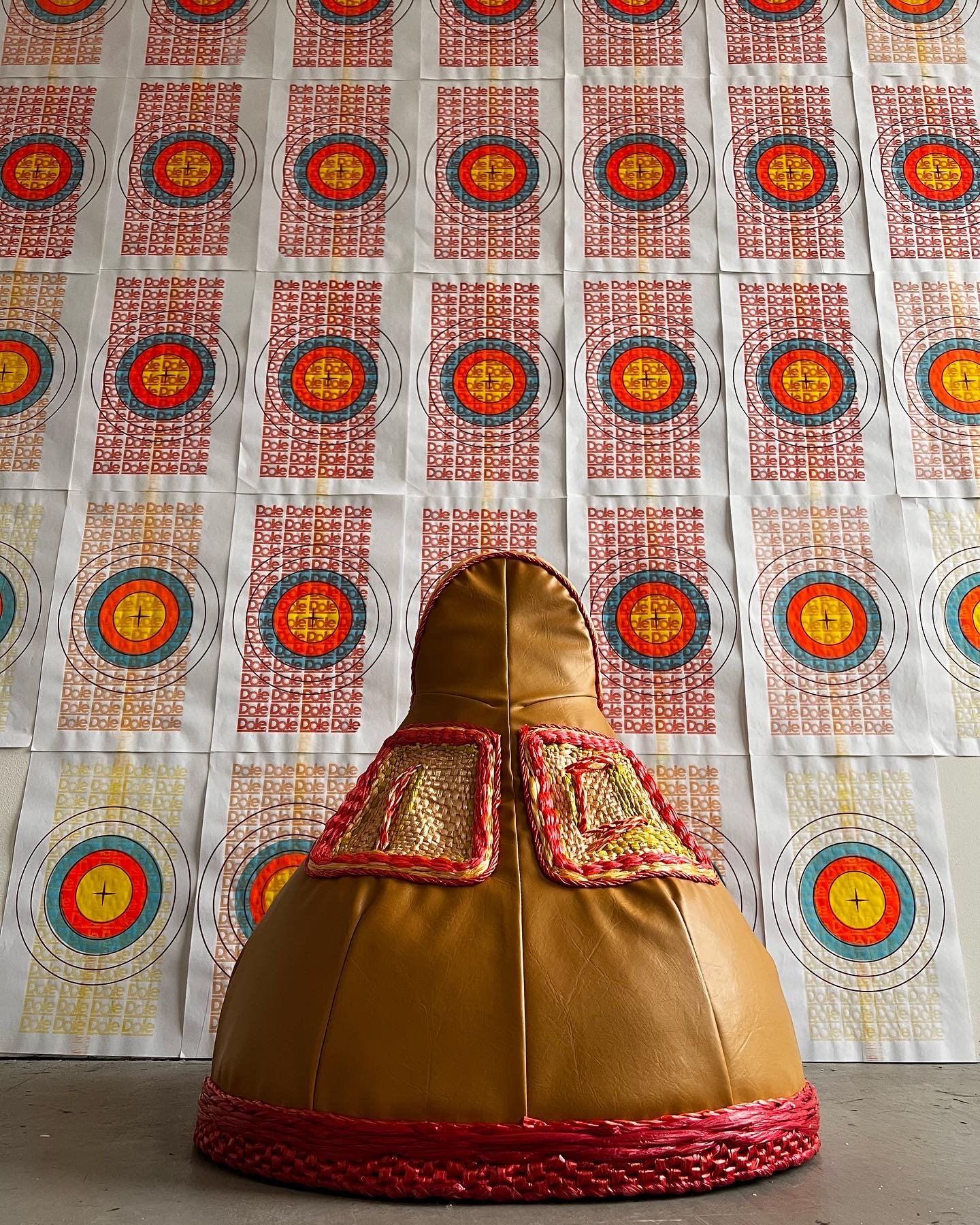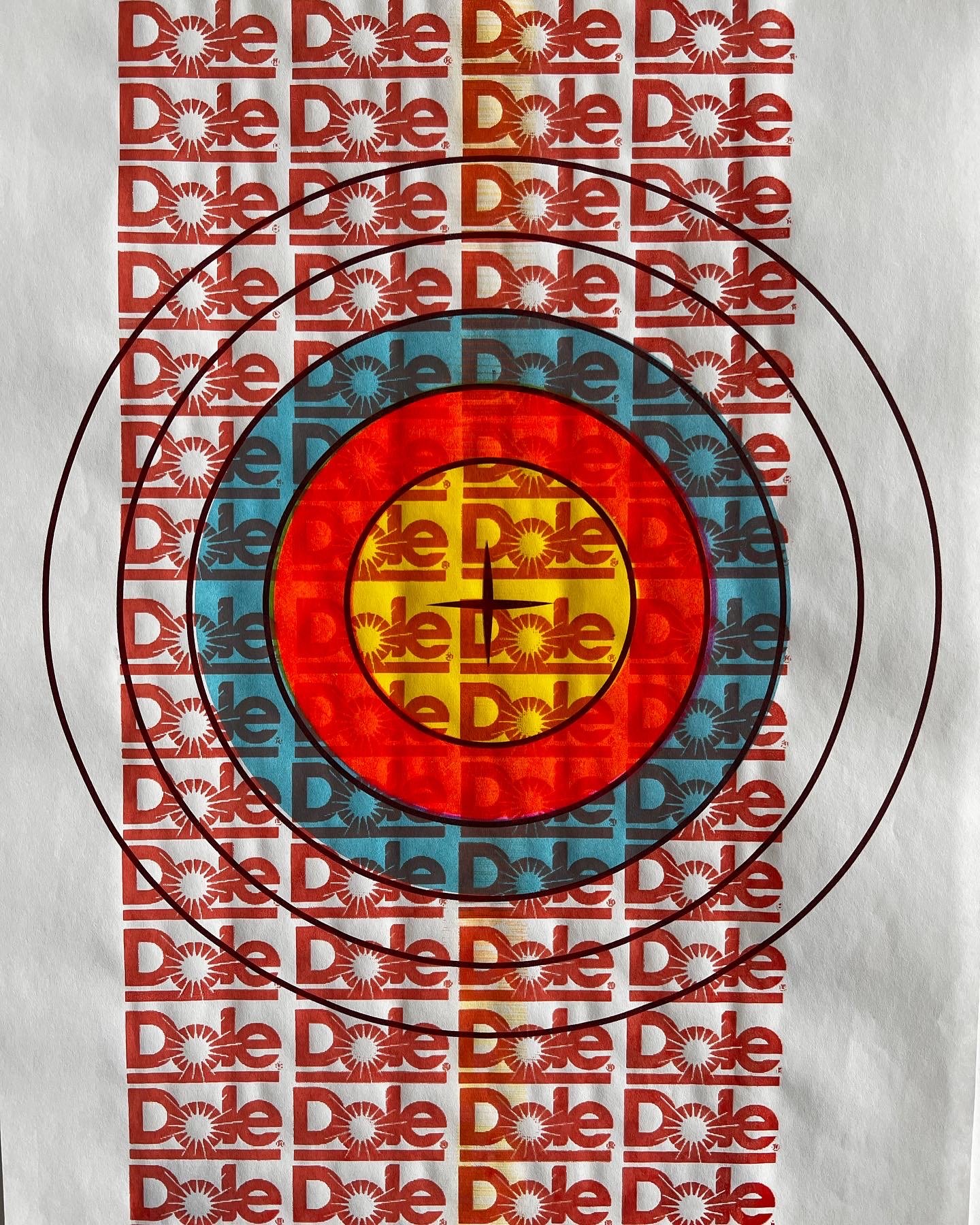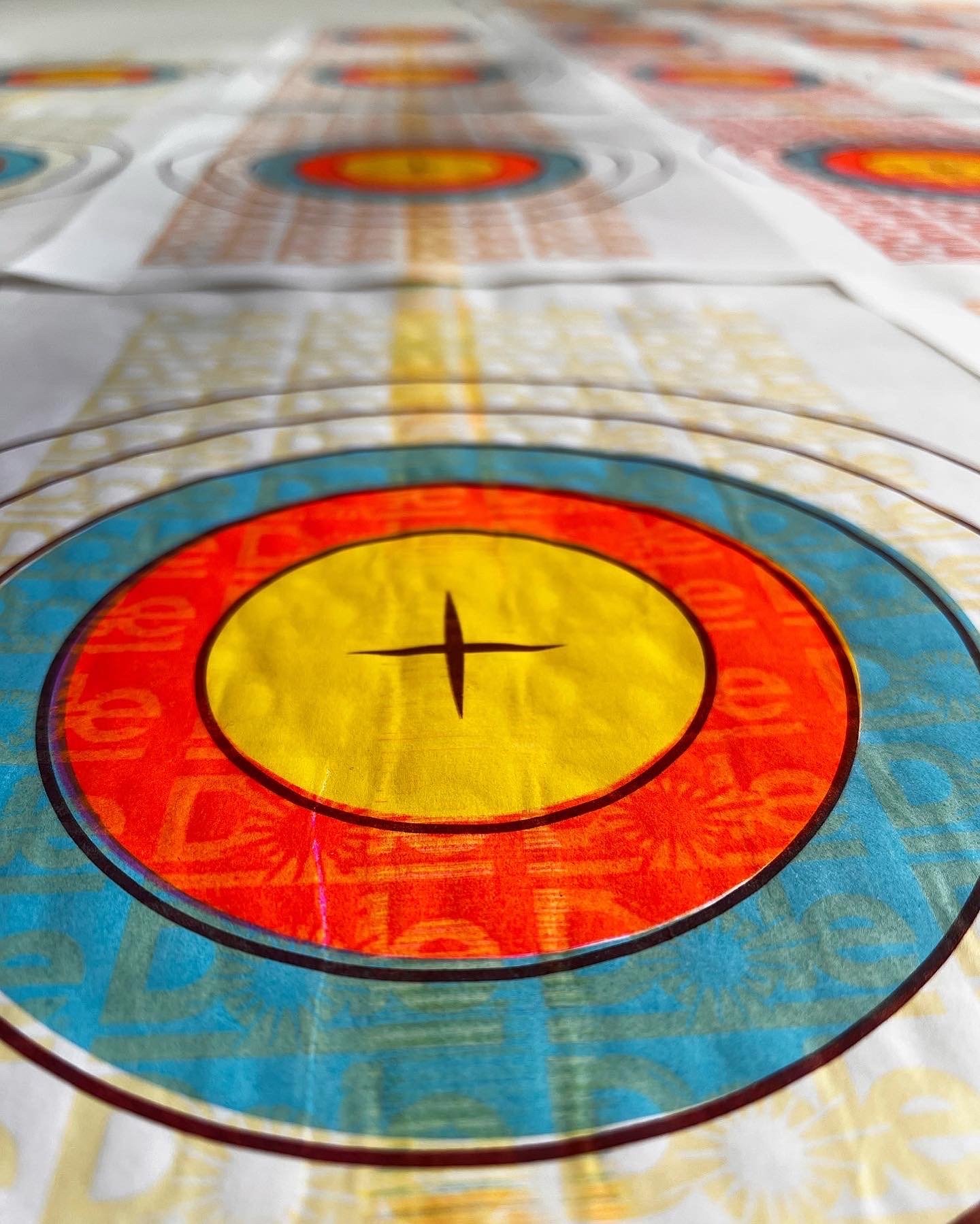Duty-Free Paradise curated by J.R. Uretsky
Mills Gallery at Boston Center for the Arts
January 20 - April 13, 2024
Duty-Free Paradise (DFP) is a survey of fifteen years of Asunción’s research and interdisciplinary work that reflects on the the connected relationship of Hawai’i and New England. Through the lens of tourism, around which the Islands’ economy heavily circulates, this work explores the contradictions between perceptions and realities of island life as a paradise constructed through American pop culture, underwritten by militarism and biopolitics. As a Filipinx-American who grew up in Hawaiʻi, now living in Boston, Asunción offers an exposition of Boston’s complicated history with Hawaiʻi. Through honoring Kānaka Maoli culture and the Filipinx diaspora, they embody characters that critique colonialism and imperialism with a compelling sense of ritualistic care. In the 1920s, Asunción’s grandparents immigrated from the Philippines to the island of Oʻahu to work at the Kahuku Sugar Plantation, where Asunción’s father was born. Decades later, Asunción found themselves creating in their studio in Jamaica Plain, a few blocks away from the historic Dole House home of James Drummond Dole — founder of The Hawaiian Pineapple Company, now known as the Dole Food Company. Dole’s legacy is intricately rooted in the dispossession of indigenous Kānaka Maoli lands orchestrated by his cousin, Governor Stanford Dole, a key figure in the 1893 coup against the Hawaiian Monarchy. In 1898, the once-free sovereign state was illegally annexed by the United States. Mirroring the same year Spain formally ceded the Philippine Islands to the U.S. This convergence of events set the stage for the migration of Filipinos to Hawaiʻi, where they labored on plantations such as Dole’s.
Neon sign by Knox Neon in Providence, RI | Photography by Melissa Blackall
This project was supported, in part, by a Emergency Grant for the Foundation for Contemporary Arts
Duty-Free Paradise Store, 2021-2024 - Enter DFP Store Here
Neon sign created by Knox Neon, printed garments, zines, audio merch, and other printed matter
The concept store addresses companies like Dole and their role in contributing to the exploitation of the island and commodification of Hawaiian culture long perpetrated by the tourism industry in Hawai’i. A visual element repeated in the products is the Duty-Free Paradise [DFP] logo, which originates from an image taken from the Dole Plantation Maze Garden entrance ticket.
79 Visitors, 2021
79 synthetic red and white plastic leis
Hawai’i discouraged tourists from visiting during the COVID-19 pandemic to protect those living on the islands. In September 2020, during the peak of the COVID-19 pandemic, it was recorded in the Hawai’i Tourism Authority report ‘2020 Hawaii Visitor Statistics’ that 79 visitors traveled from Japan to Hawai’i compared to 143,928 in 2019, and in comparison, there were 6,033 from the United States.
Tubó Gun, 2021
Sugarcane, glass gun, wooden gun mounts, paper, gold ink, upholstery nails
Talunan sabong (defeated cock), 2007-2024
Preserved rooster feet, 19th-century square cut nails, beeswax string, leather, wood
Talunan is a popular Filipino chicken soup, but it also means loser or defeated. Sabong is another Tagalog word that translates to ‘cockfight.’ Despite the name, talunan soup is sometimes made from the winning cock of the brood when it is too old to fight. This work reflects the nuances of war, violence, and sport and how all exist in cultures like Hawai’i and the Philippines, where Imperialism and U.S. militarization have played a role in shaping their past and current histories.
Big Luau Give Back Aloha, 2021
Pigment print on α-cellulose paper
39” x 36.5”
1930s vintage non-brand Hawai’i bathing suit, 3D printed Boston Old State House with gold leaf, Brwngrlz laser engraved Queen Lili'uokalani earrings, glass tubó gun, military cabling and gun sling harness, silk bandana.
Photography by Sasha Pedro
Fair Use Hawai’i, 2021
3-channel video, 11:26 min.
This work critiques tourist activity during the COVID-19 pandemic and the commodification of Hawaiʻi as an escape to paradise for those living in the U.S. “mainland.” The video addresses the ways advertising media for eco-tourism continues neoliberal economic and political gain through the exploitation of Hawai’i resources, land, and peoples. The performative action of boxing reflects the cultural struggle for a sense of identity and independence. The video uses transmedia storytelling by forcing the viewer to consider the backdrop of U.S. tourism in relation to the cultural violence and oppression over the past two centuries.
Golden Token: Secret Stations, 2021
360 video, 11:50 min.
This 360 video is a first-person exploration of the Dole Plantation Pineapple Garden Maze, an attraction located near Whitmore Village in Wahiawa, where Asunción’s family currently lives. Features in the video is an old stock, vintage 1959 golden coin commemorating the U.S. annexing Hawai’i as the 50th State of the United States.
The U.S. military has controlled this land since 1898. In 1941, the Naval Computer and Telecommunications Area Master Station Pacific (NCTAMS PAC) relocated to this area of Wahiawa on approximately 700 acres of land in central Oahu on the eastern side of the highest part of the Schofield Barracks Army installation. Today, the Dole Plantation’s website boasts having the world’s largest maze as of 2008, a 2.5-mile botanical maze composed of 14,000 Hawaiian plants. It also states it is one of Oahu’s most popular visitor attractions and welcomes more than one million visitors a year.
Secret Stations: Bango 720740, 2024
Printed flag, flag pole, paint (Manila Green)
Painted text on back of flag: BLOOD, BONES, Aloha!
The Duty-Free Paradise logo is based on the entrance ticket to the Dole Plantation Pineapple Garden Maze and edited to leave only the phrase Secret Stations. This flag echoes the histories of the land the Dole Garden Maze occupies. The red target imagery comes from a scavenger hunt for children, produced by the Dole Plantation, to discover the Islands of Hawai'i by finding and collecting all eight of them. Exploration and land grabbing reflects the U.S. colonization and annexation of Hawai'i.
720740 is the number of the ticket Asunción received the day they toured the garden maze, and bango is the Japanese word for number. On the plantations, bango tags were worn on chains around plantation laborers' necks, and the worker's race typically determined the shape. Borrowed from the slave tag system used in the South before the American Civil War, every plantation in Hawai'i used the bango system. Laborers were required to wear their bango during working hours, and plantation accounts listed bango numbers rather than the employees' names.
Pineapple Girl Series: Departing Tide, 2010 (left screen)
Video documentation of performance, Ka’ena Point, Oahu, HI
According to Kānaka Maoli tradition, Kaʻena Point is the place of departure for souls leaving this world. In 1899, the Oahu Railway and Land Company constructed a railway that encompassed 70 miles from Honolulu through Kahuku to transport sugarcane. Most of the tracks were destroyed by a tsunami in 1946. Parts of them are visible along the Ka'ena Point Trail.
Pineapple Girl Series: 3 Seasons, 2010-2011 (right screen)
Video documentation of performance, Storrs, CT
The Pineapple Girl series began in 2007, the same year as the final industrial harvest of pineapples in Hawai’i. Shot in Storrs, Connecticut, and Ka‘ena Point Keawa’ula on O’ahu near Dillingham Airbase, this work is a meditation on the colonial ties between New England and Hawai’i. The pineapple is an eulogized fruit with a long history of being desired due to American agricultural corporations like Castle & Cooke and Dole Hawaii Pineapple Company (now Dole Food Co.) commercializing the fruit. It took 146 years for the production of pineapples to end in Hawai’i. Remnants of this industry remain in the Hawaiian landscape, littered with signs that read ‘for agricultural use only,’ posted by Monsanto Co. Kunia, who now grows corn in those fields that are then shipped back across the Pacific Ocean to feed cattle.
Dole House Performance, 2022
Video documentation of performance in front of Dole House in Jamaica Plain, MA
In the 1920s, Asunción’s grandparents immigrated from the Philippines to the island of O’ahu to work at the Kahuku Sugar Plantation, where Asunción’s father was born. Decades later, Asunción found themselves in Jamaica Plain, a few blocks away from the historic Dole House home of James Drummond Dole – founder of The Hawaiian Pineapple Company, now known as the Dole Food Company. Dole’s legacy is intricately rooted in the dispossession of indigenous Kānaka Maoli lands orchestrated by his cousin, Governor Stanford Dole, a key figure in the 1893 coup against the Hawaiian Monarchy. In 1898, the once-free sovereign state was illegally annexed by the United States. In the same year, Spain formally ceded the Philippine Islands to the U.S., where they labored on plantations such as Dole’s.
The Local, 2010-2024
14-year petrified pineapple, wood
Asunción started working on this project in 2010 a few years following the closing of pineapple plantations in Hawai`i. Asunción built a custom crate around a fresh pineapple, letting it petrify over time with the closing of the plantations. The final plantation closed on Maui in 2007, moving overseas to the Philippines and Puerto Rico. This piece symbolizes the last pineapple plantation crop, marking the end of 146 years of producing this fruit as a mono-crop in Hawai’i.
Photography by Melissa Blackall
Duty-Free Paradise
Mills Gallery at Boston Center for the Arts
January 20 - April 13, 2024
Dole House (Self Portrait), 2021
Pigment print on α-cellulose paper
29” x 36.5”
Queer barong tailored by Hai Wen Lin made from piña fiber with traditional Filipino embroidery, military survival cord harness, gun sling, petrified sugarcane.
Photography by Rita Lombardi while in residence at the Wedding Cake House in Providence, Rhode, Island.
BLOOD, BONES, ALOHA!, 2024
Dirt and pigment on panel wood, sand
Photography by Melissa Blackall
This work reflects Queen "Lydia" Lili'uokalani's writing while imprisoned at Iolani Palace following the 1893 overthrow of the Hawaiian monarchy by a Euro-American oligarchy who wanted control of the Hawaiian government. In 1898, the United States illegally annexed the once-free Hawai'i despite Queen Lili'uokalani's letters protesting the U.S. assertion of ownership without due process or just compensation. In the same year, following the Spanish-American War the Treaty of Paris (1898) ended the period of Spanish colonization in the Philippines and granted possession of Cuba, Puerto Rico, Guam, and the Philippines to the United States.
Wai Warnings, 2024
Nautical light and sand
WAI Red Hill Hex, 2021
Printed flag, flag pole, paint (Manila Green)
Painted text on back of flag: BLOOD, BONES, Aloha!
WAI Red Hill Hexis a multimedia piece addressing the water crisis in 2014 when 27,000 gallons of jet fuel leaked from one of the fuel storage tanks at Red Hill in Moanalua. These storage tanks are the largest of its kind in the U.S. and sit only 100 feet above one of Oʻahu's main aquifers which would affect the water supply of residents from Hālawa to Maunalua in Hawaiʻi Kai. On March 7, 2022, the Department of Defense announced the planned closure of the Red Hill facility after years of local activists fighting for water justice for the removal of the fuel tanks. This piece serves as a call to action to protect the most sacred of resources, water, in solidarity with the O’ahu Water Protectors fight against irreversible environmental damage.
Sirena I, 2022
Pigment print on α-cellulose paper
Photography by Sasha Pedro and mask made in collaboration with J.R. Uretsky
The Sirena is a Filipinx siren trained in Kali, the national martial arts in the Philippines taught by Survival Arts - a community for Pinay / Pilipina / Filipinx, non-binary, gender expansive and woman-identified BIPOC people. Survival Arts is also a training community that aims to protect the mind, body, and spirit against violence.
Together Sirena and Survival Arts protect queer BIPOC people against colonization and white supremacy. They are beings of decolonization efforts who warn of a future rooted in environmental racism.
Wai Warnings: Through the Eyes of Atlas, 2023
Digital video projection
Photography by Melissa Blackall
SONG/LAND/SEA
|
SONG/LAND/SEA |
DIG & RISE | Kala Art Institute, Berkeley, CA
SONG/LAND/SEA | Binakol Blessing
HD video, digital pigment prints on fabric, silkscreen on paper/fabric/cement, candle, balancing stones, kulintang gongs, ironwood kali knife by Survival Arts
2023
Decoding the Colonial | NAPJ - performance series with artist Joanna Tam
Now + There | Lot Lab
Boston Navy Yard, Charleston, MA
September 16, 2023 at 3-5 pm
Mural by Massiel Grullón
Photography by James Barham
Decoding the Colonial | NAPJ
Performance with Boston based artist Joanna Tam at Lot Lab - Public Art Programming. We presented site-specific performances and creative interventions in partnership with Now + There. Responding to 2023 Lot Lab at the Boston Navy Yard history and geography as a post-colonial military industrial shipyard that is adjacent to both the Boston Harbor waters and the Freedom Trail next to the USS Constitution Museum, Asunción and Tam’s projects are an extension of their ongoing explorations into the construction of national identity, safety, empowerment, and freedom in the wake of cultural and environmental oppression. Find out more about these performances at https://www.nowandthere.org/events/decodingthecolonial
Binakol Blessing | Sirena + Kali
Photography by Jason Brawdy & AJ Schnettler
Treasure Island, San Francisco, CA
2023
Binakol Blessing is a multimedia installation and performance series from SONG/ LAND/ SEA, a series that speaks to the current climate crisis and how high tech industry developments and military initiatives simultaneously affect the North American East and West Coast, specifically the Bay Area in San Francisco, CA and Seaport in Boston, MA. This affects both areas environmentally, culturally, and economically. They are also areas subject to flooding due to rapid sea levels rising caused by climate change. This performance serves as warning and signifier of the rapid climate change crisis which has been affecting the global North and South.
Wai Warnings: Through the Eyes of Atlas, 2023
HD video 11:00 min.
Site specific performance and video work made in collaboration with artificial intelligence (A.I.) software through text prompt rendered videos edited with location footage taken in the Seaport in Boston, MA with performance footage from Treasure Island in San Francisco - 2023 Fellowship at Kala Arts Institute in Berkeley, CA.
The multimedia performance series and sound work in this project incorporates installations of printmaking and video that documents and follows climate change causing excessive rain currently creating floods in the Bay Area in California and sea levels rising in the Boston Seaport Harbors.
It also follows the water crisis in Hawai’i due to leakage from the U.S. Navy Red Hill Fuel Storage Facility in Kapūkaki, Oahu and the devastating fires in Lāhainā, Maui (August 8. 2023) caused by hurricane winds and dry arid landscapes due to militarization, eco-tourism, and colonial neoliberal plantation histories (Duty-Free Paradise, 2020-2023).
This video work combines segments from Asuncion’s 'Tabi Tabi Po' and 'Red Hill Hex' performances with audio sampling from José Maceda – Field Recordings In Philippines [1953–1972] Forest Sound (1967) and field recordings from Oakland and Pacifica Bay in California. Group field recording research and work done in community with Rhythm in Nature Residency taught and facilitated by percussionist/composer Susie Ibarra. The video work is a visual score for voice and kulintang gongs for live performance.
Sirena I-III (2021-23)
Photography by Sasha Pedro
Mask by J.R. Uretsky (2021) | DFP Maze Necklace by Juvana Soliven (2021) | Woven Ikat (rain) Inabel by Timothy Manalo (2020) | Duty-Free Paradise (DFP) Sirena Design (2021)
Center of Gravity | Artist Residency - Walkaway House
North Adams, MA
2023
CONFETTI video projection mapping on residency building by Pamela Hersch Visuals in partnership with Installation Space, HHH Studio, and MCLA Gallery 51.
Photo documentation by Carolina Porras Monroy
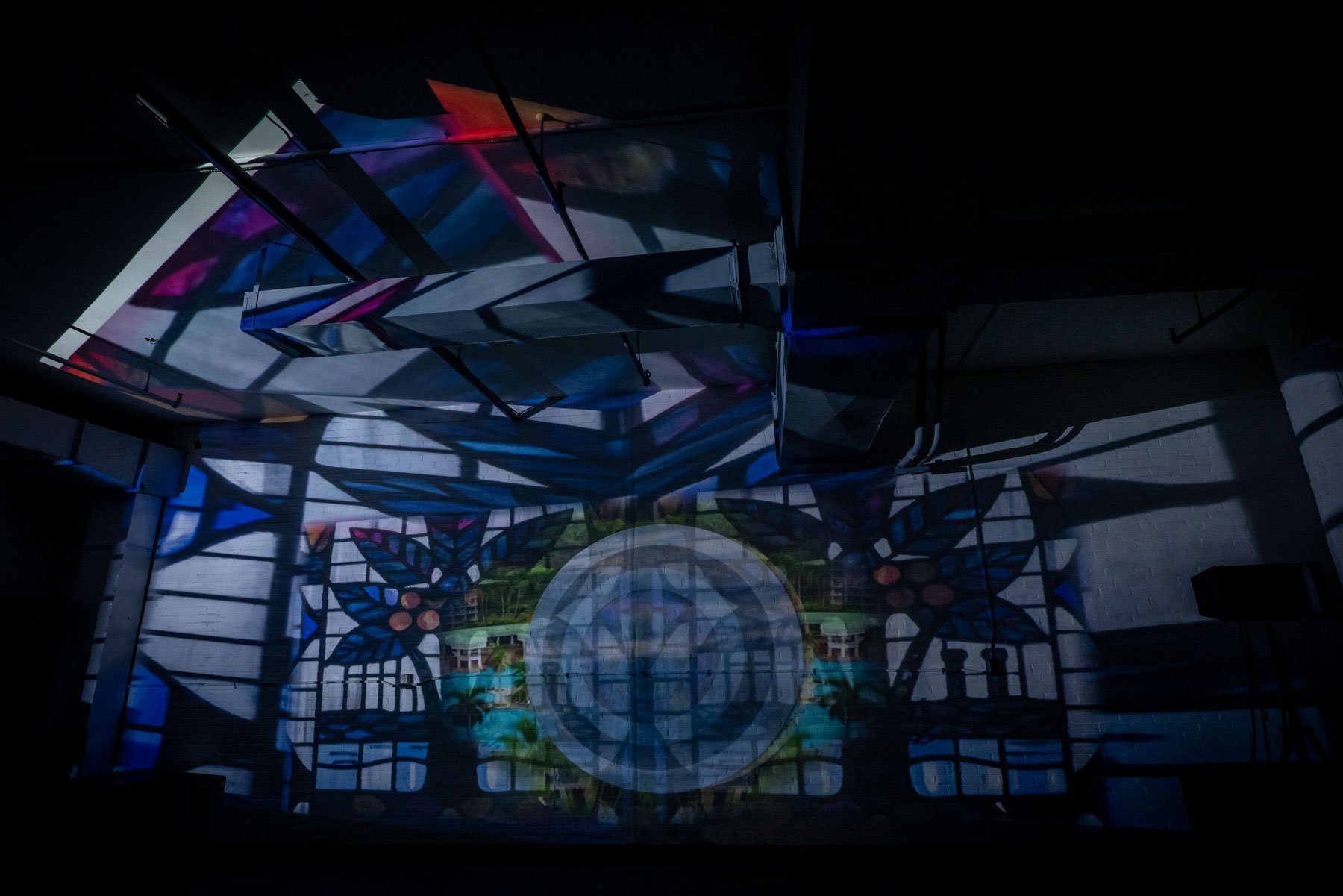
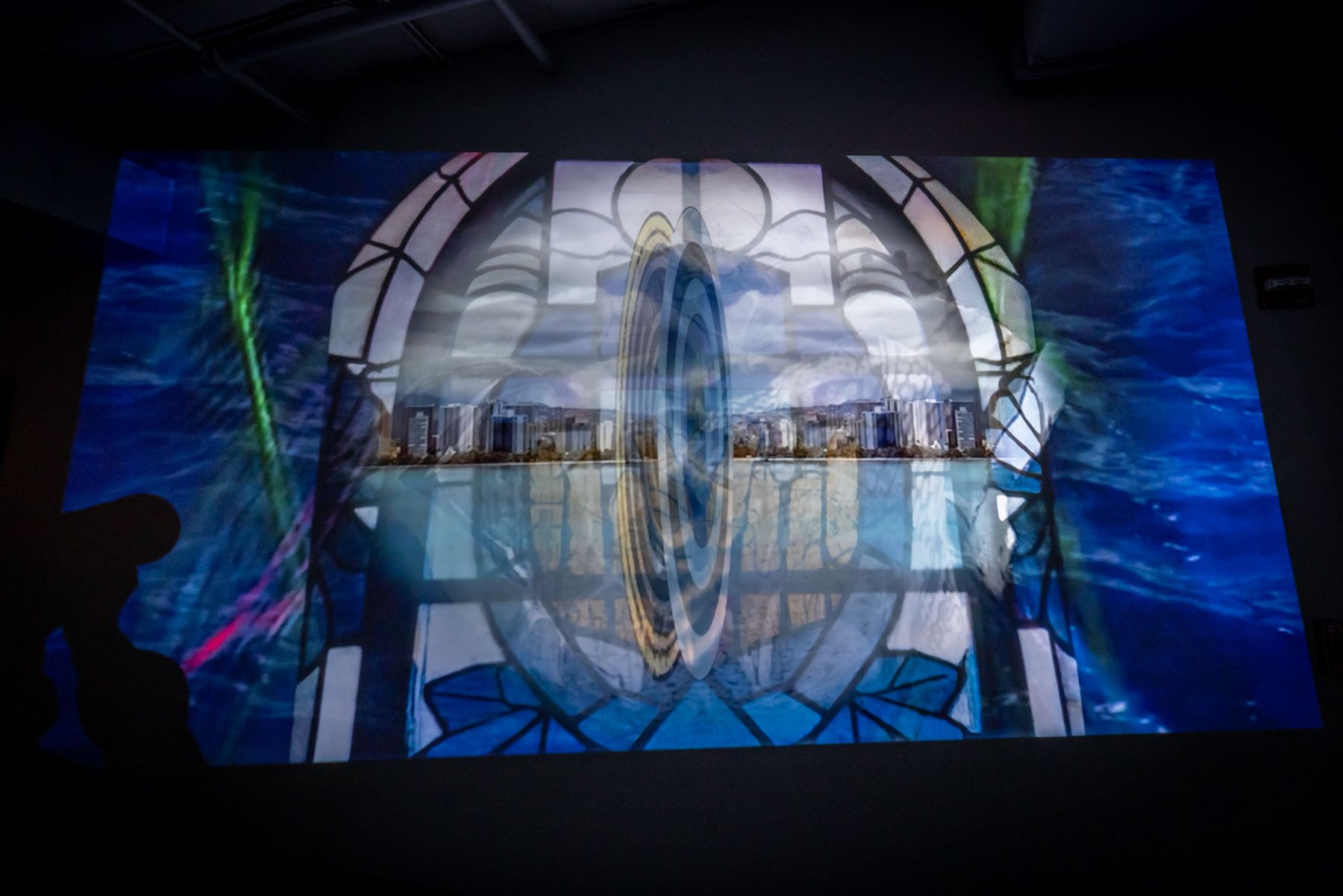
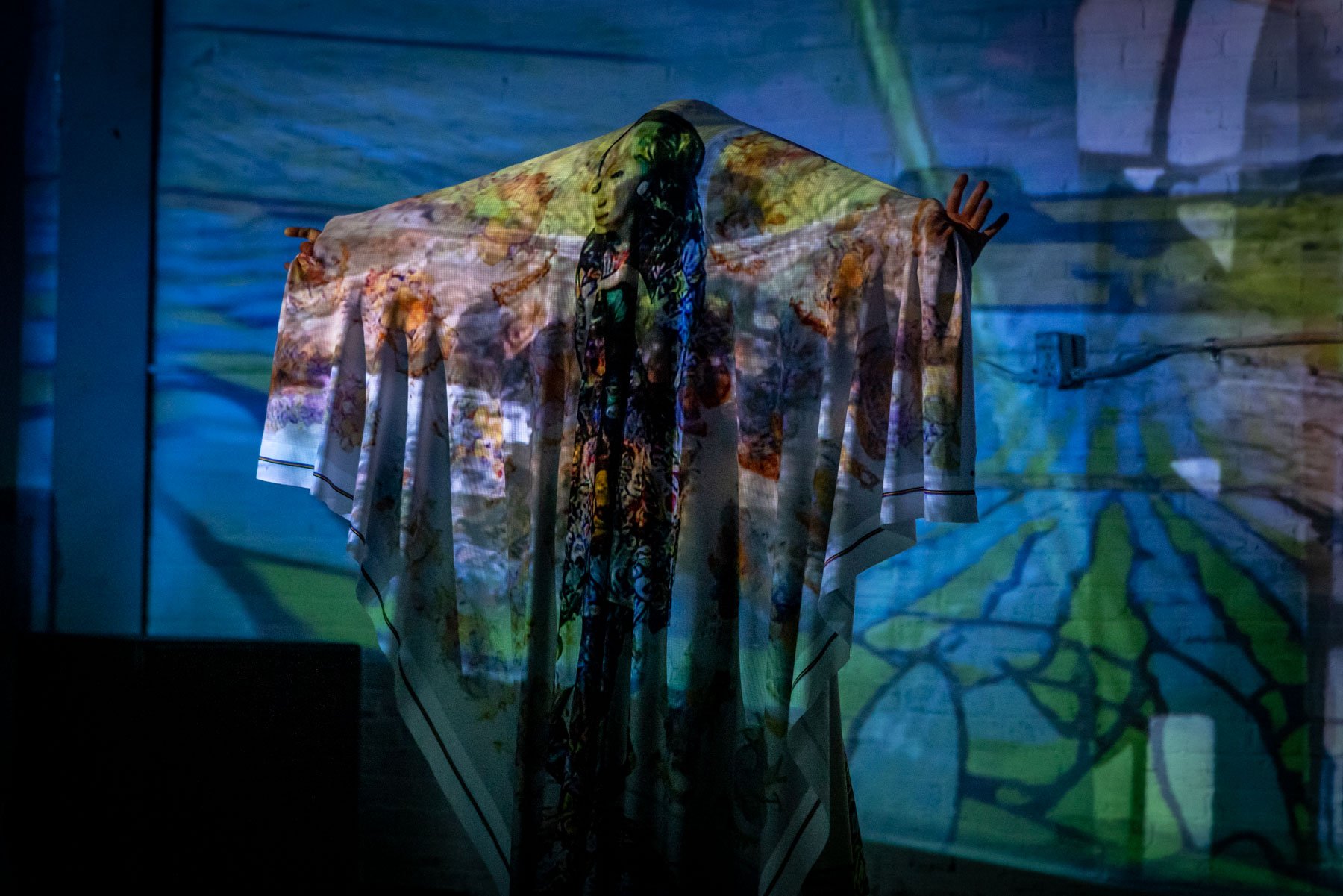
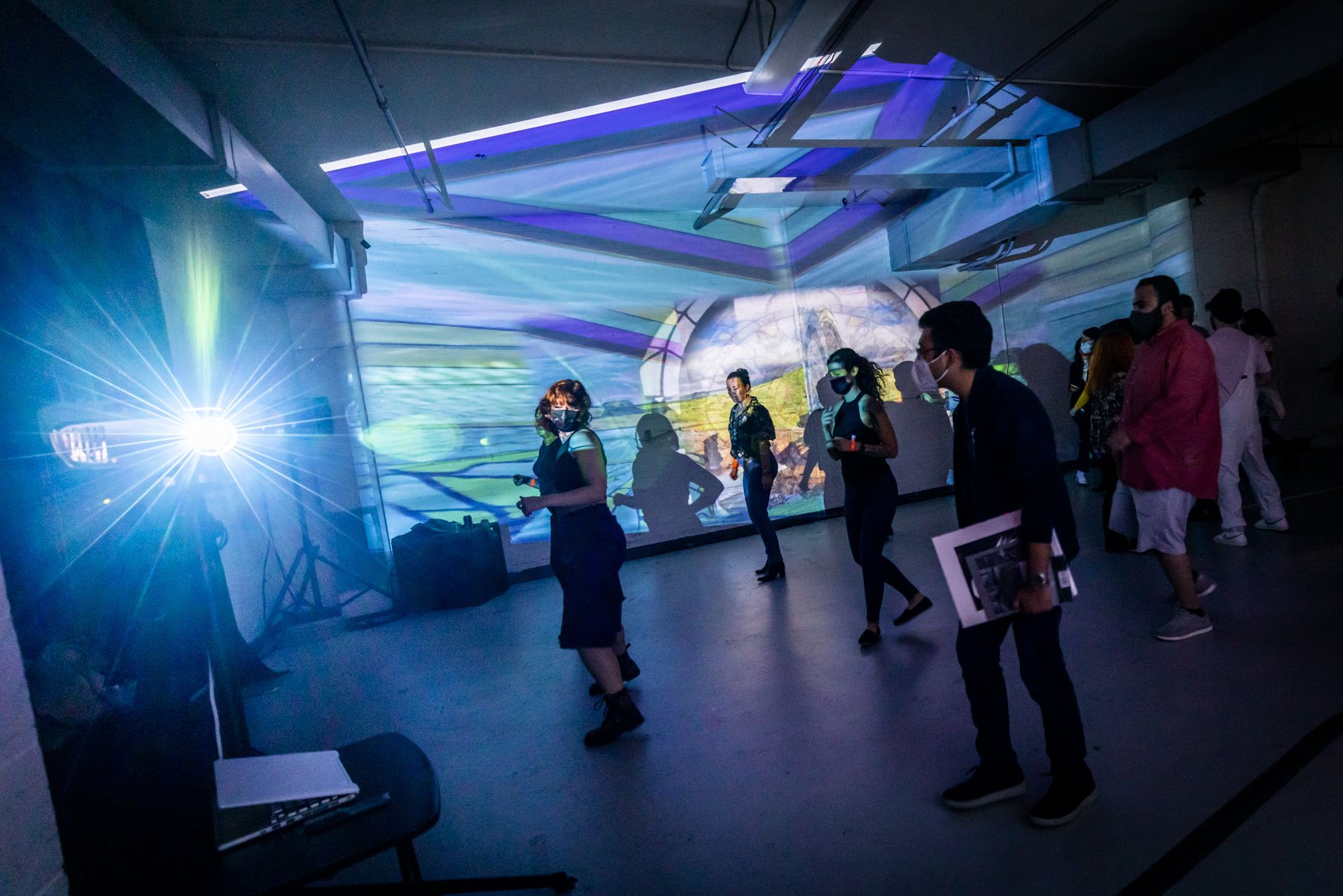
Duty-Free Paradise | WAI: Red Hill Hex
Documentation of multimedia projection mapped installation of WAI | Red Hill Hex and performance
Boston Book Art Fair, Boston Center for the Arts, Boston, MA
2022
Photography by Melissa Blackall
This multimedia installation was created by reimagining Duty-Free Paradise (2020-23) series made in collaboration with artificial intelligence A.I. renders of sugar and pineapple plantation stained glass that have been restructured, edited, layered with video and merged into animations. This work is activated through projection mapping, combined with print and performance work taken from ‘WAI: Red Hill Hex’ addressing the ongoing water crisis in Hawai’i due to leakage from the U.S. Navy Red Hill Fuel Storage Facility in Kapūkaki, Oahu.
It was made in solidarity with the work of O’ahu Water Protectors those working towards water justice efforts around the Red Hill water crisis.
DUTY-FREE PARADISE
|
DUTY-FREE PARADISE |
Duty-Free Paradise performance collab with mezzo soprano Pauline Tan at Somerville Museum, Oct. 8, 2022
Sanctuary City exhibition programming curated by Julia Csekö
Photography by Feda Eid
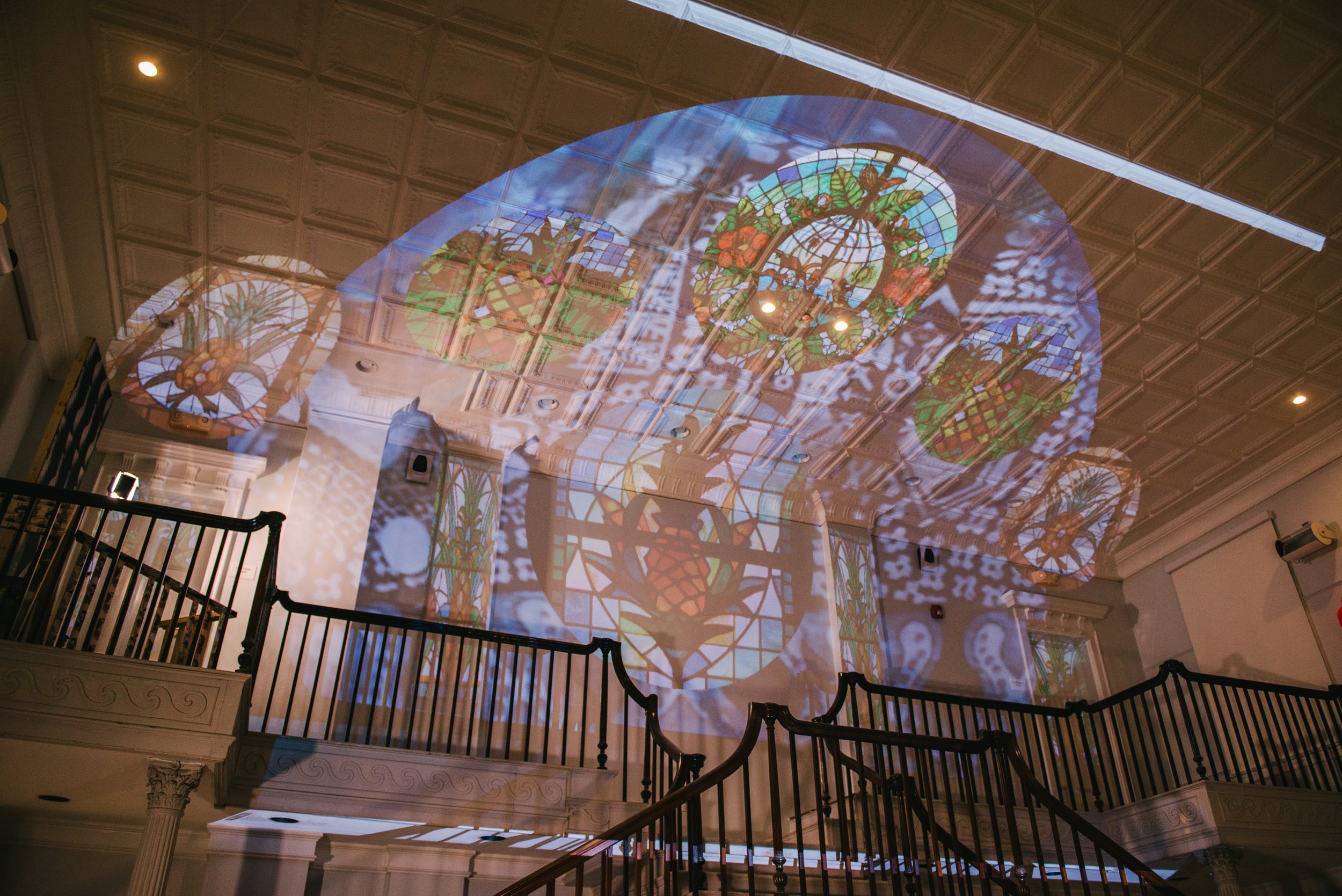
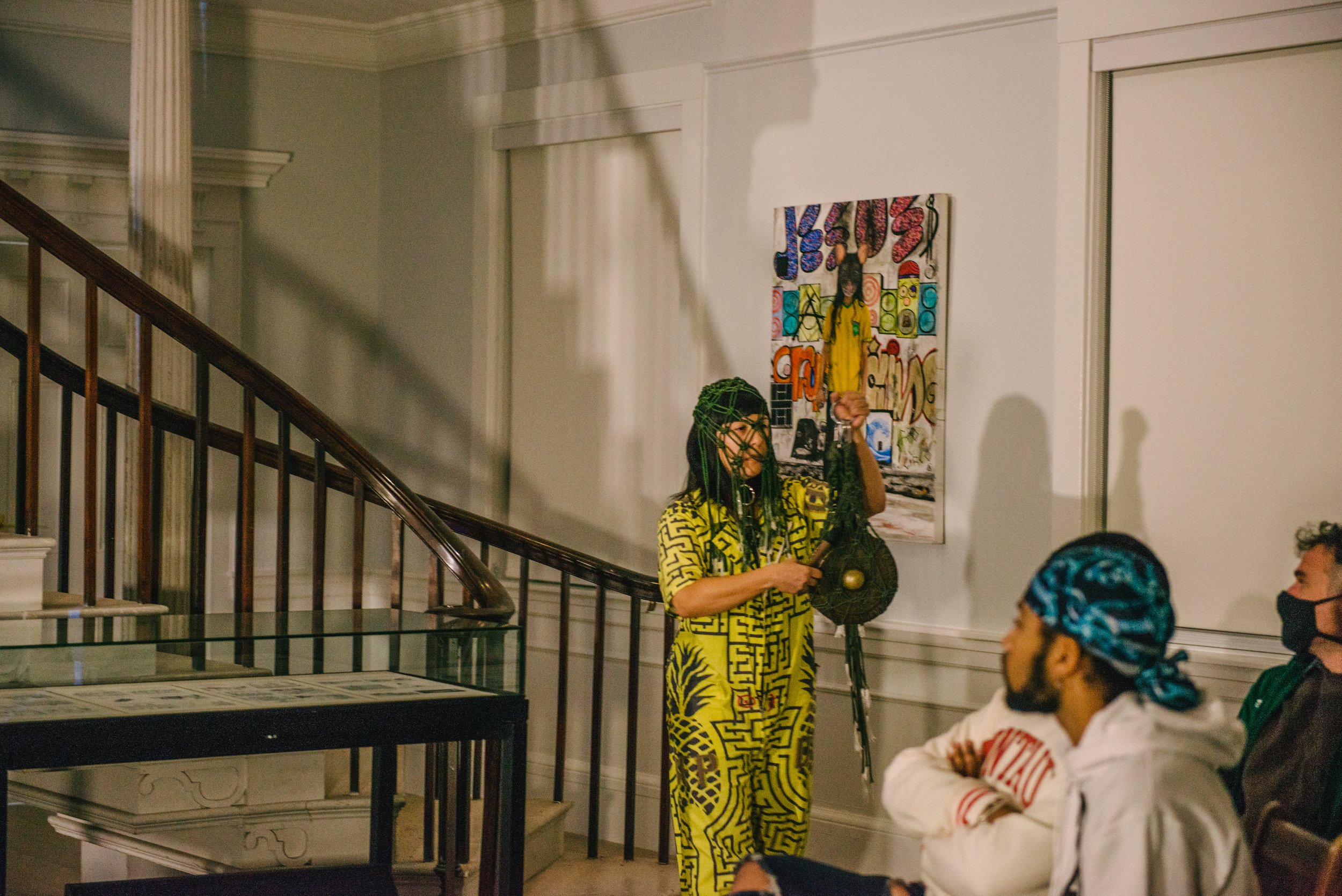
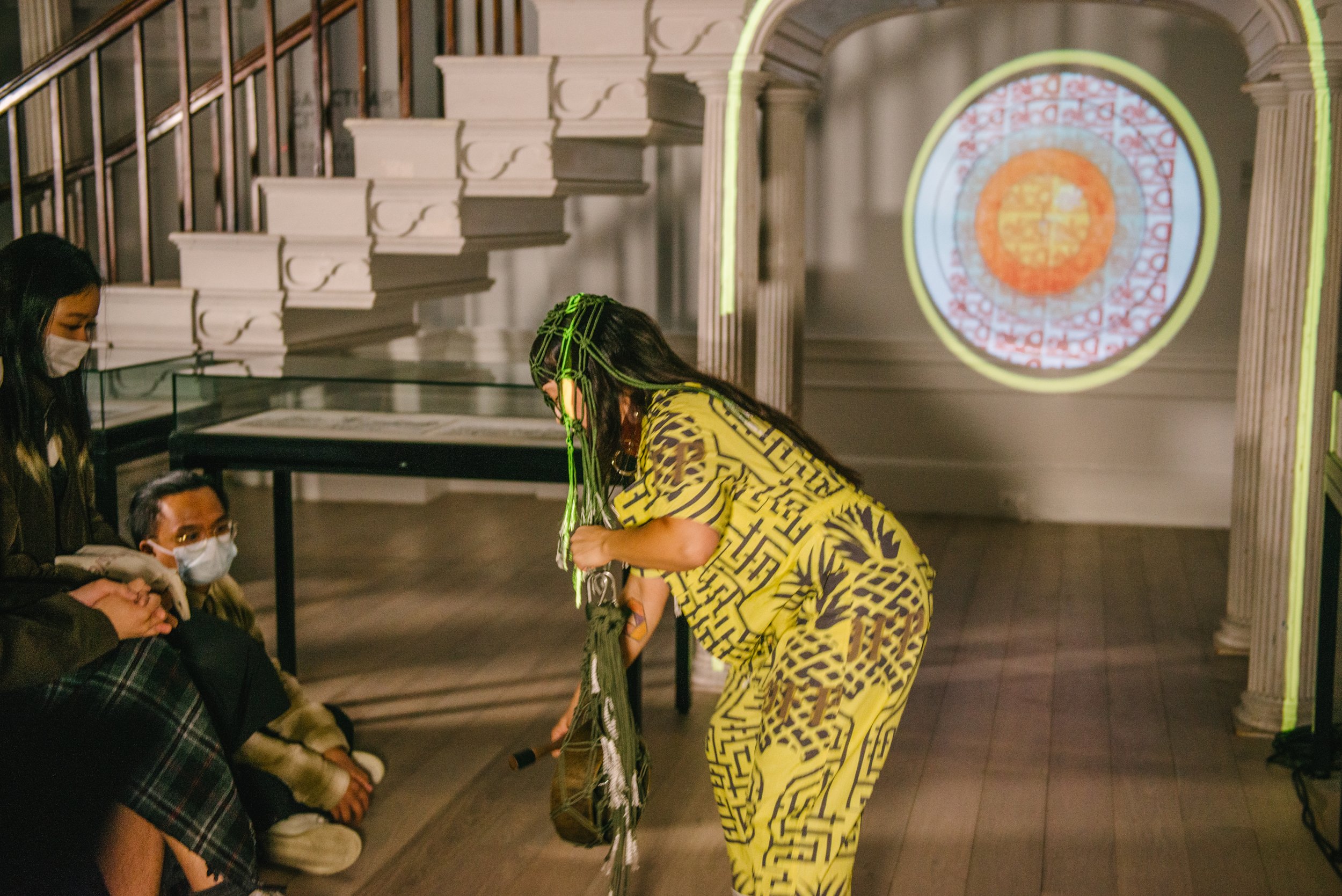
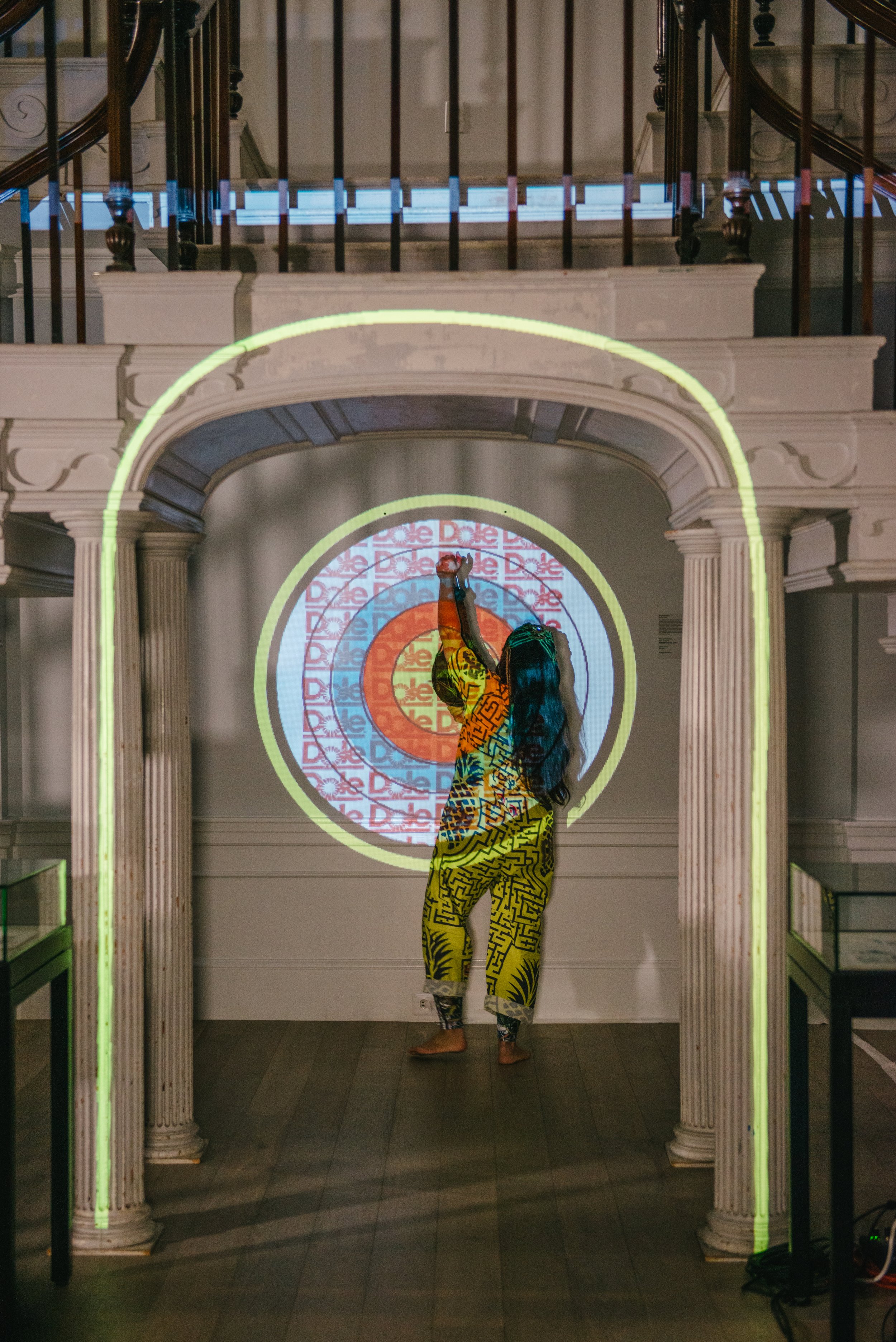
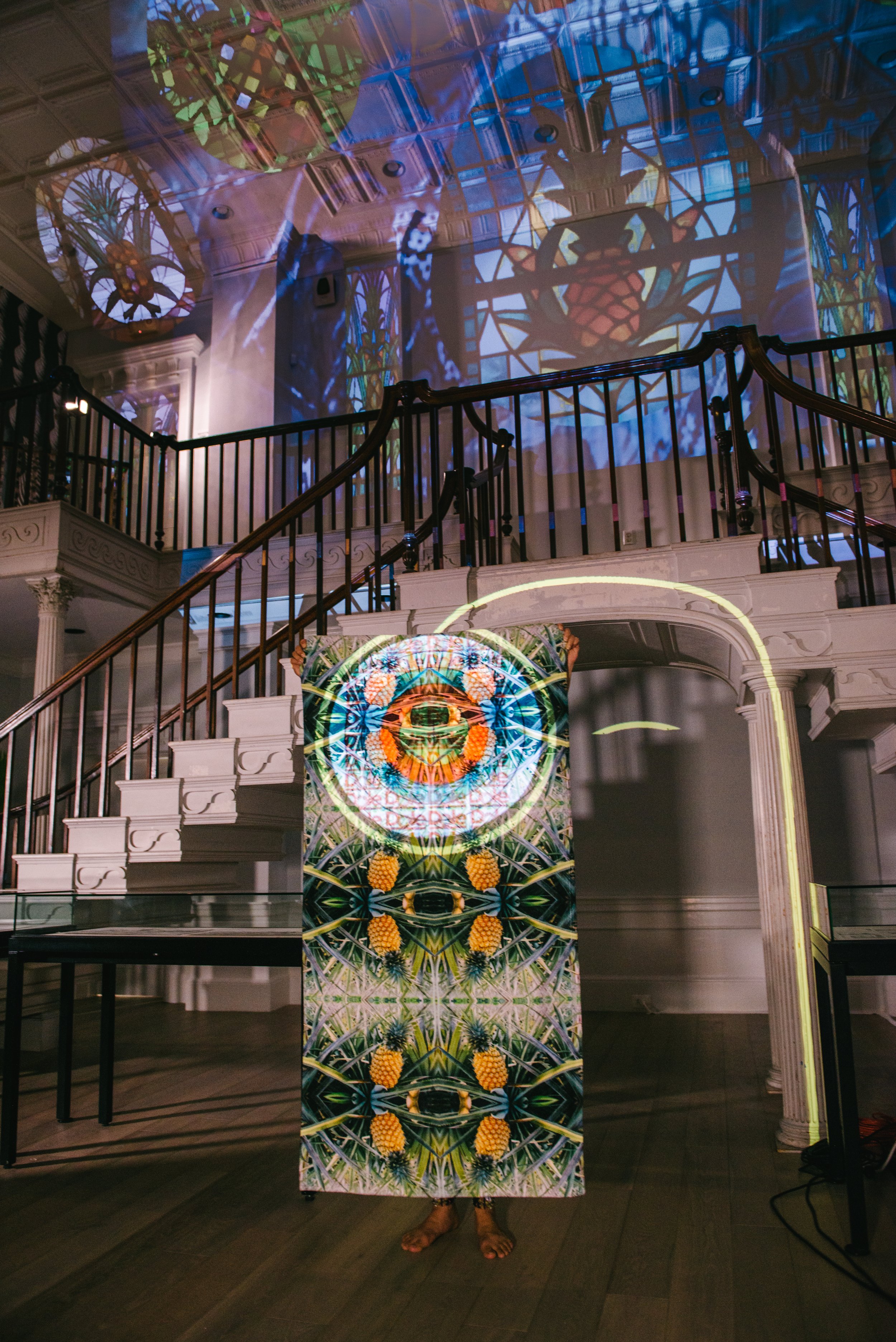
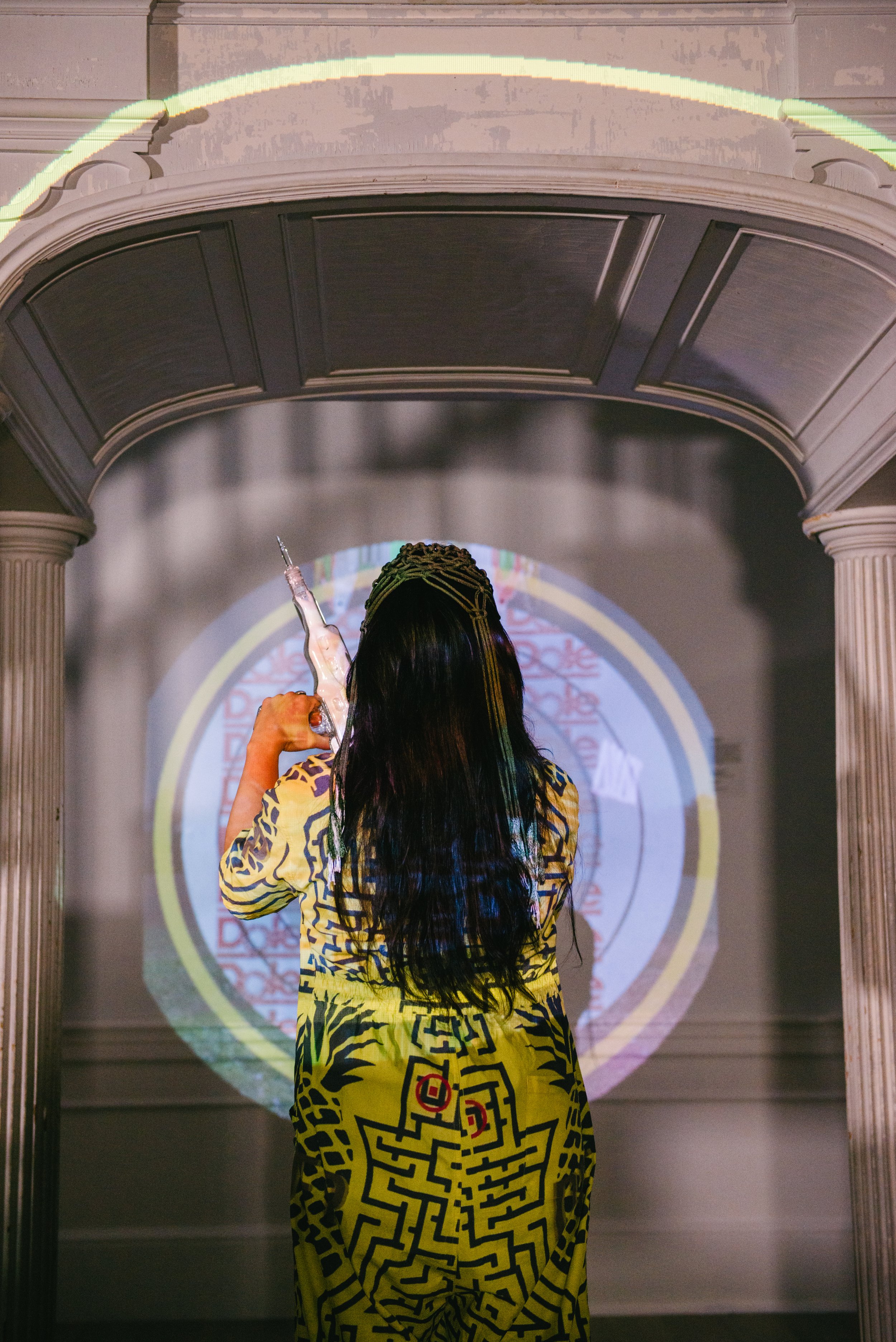
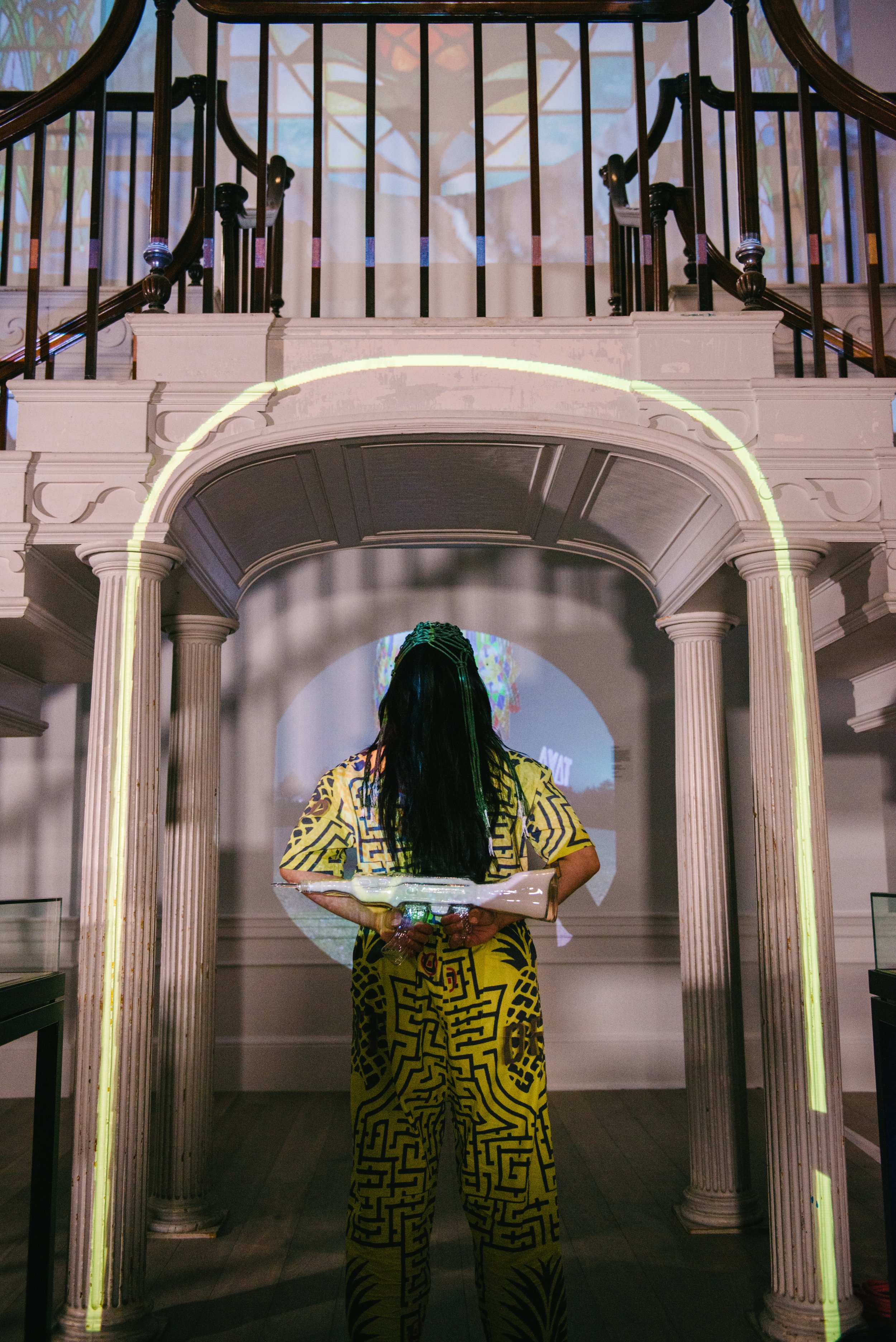
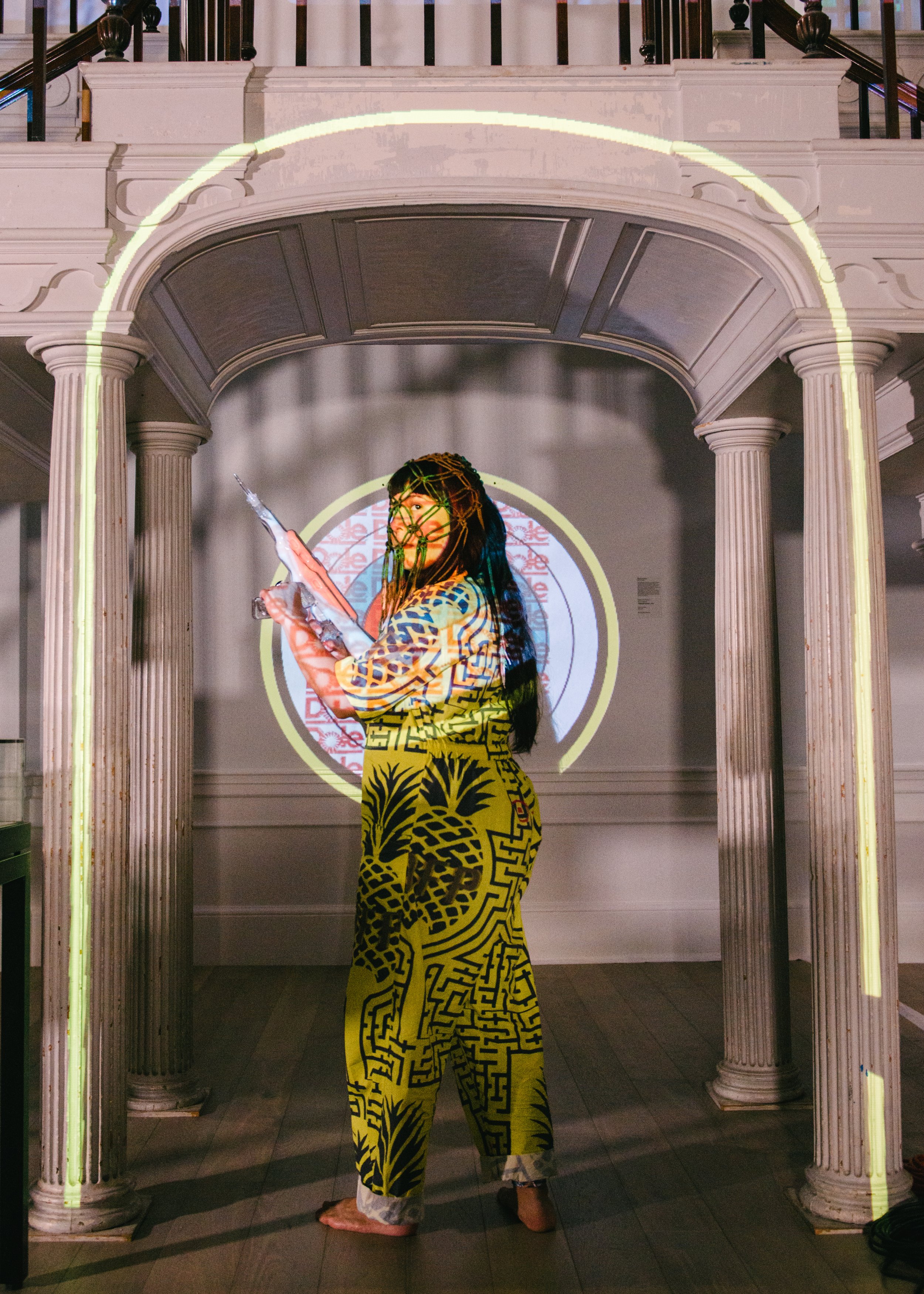
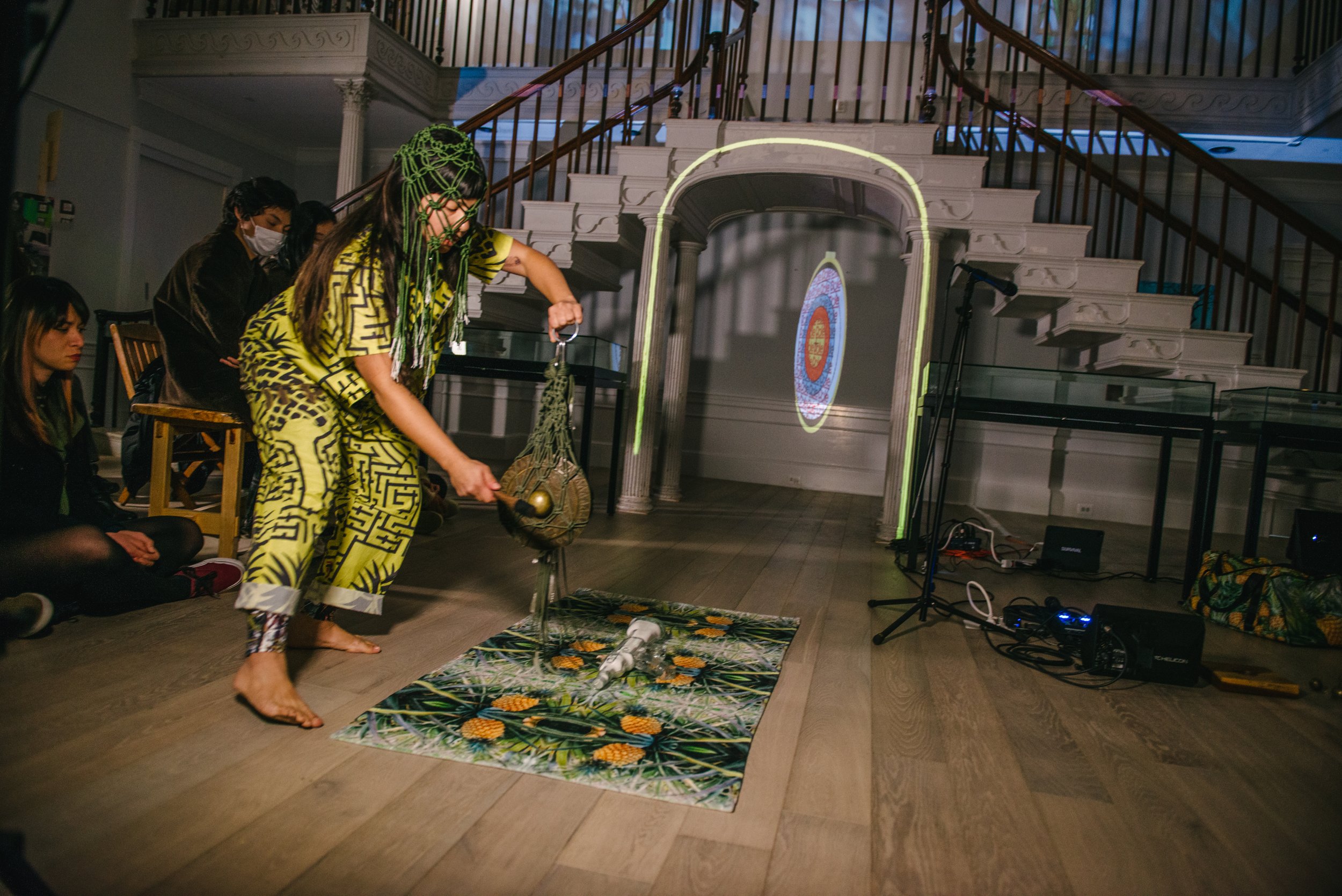
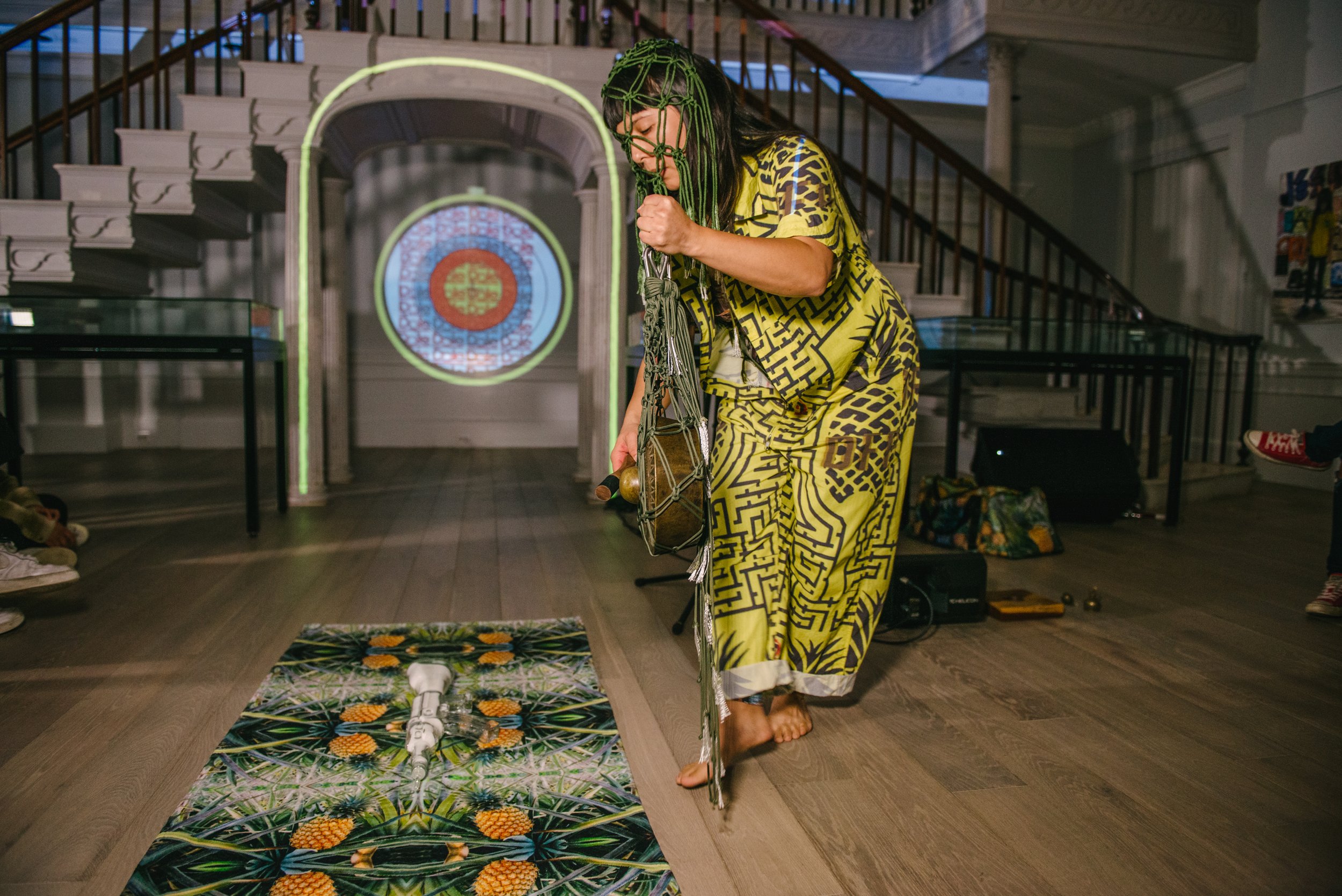
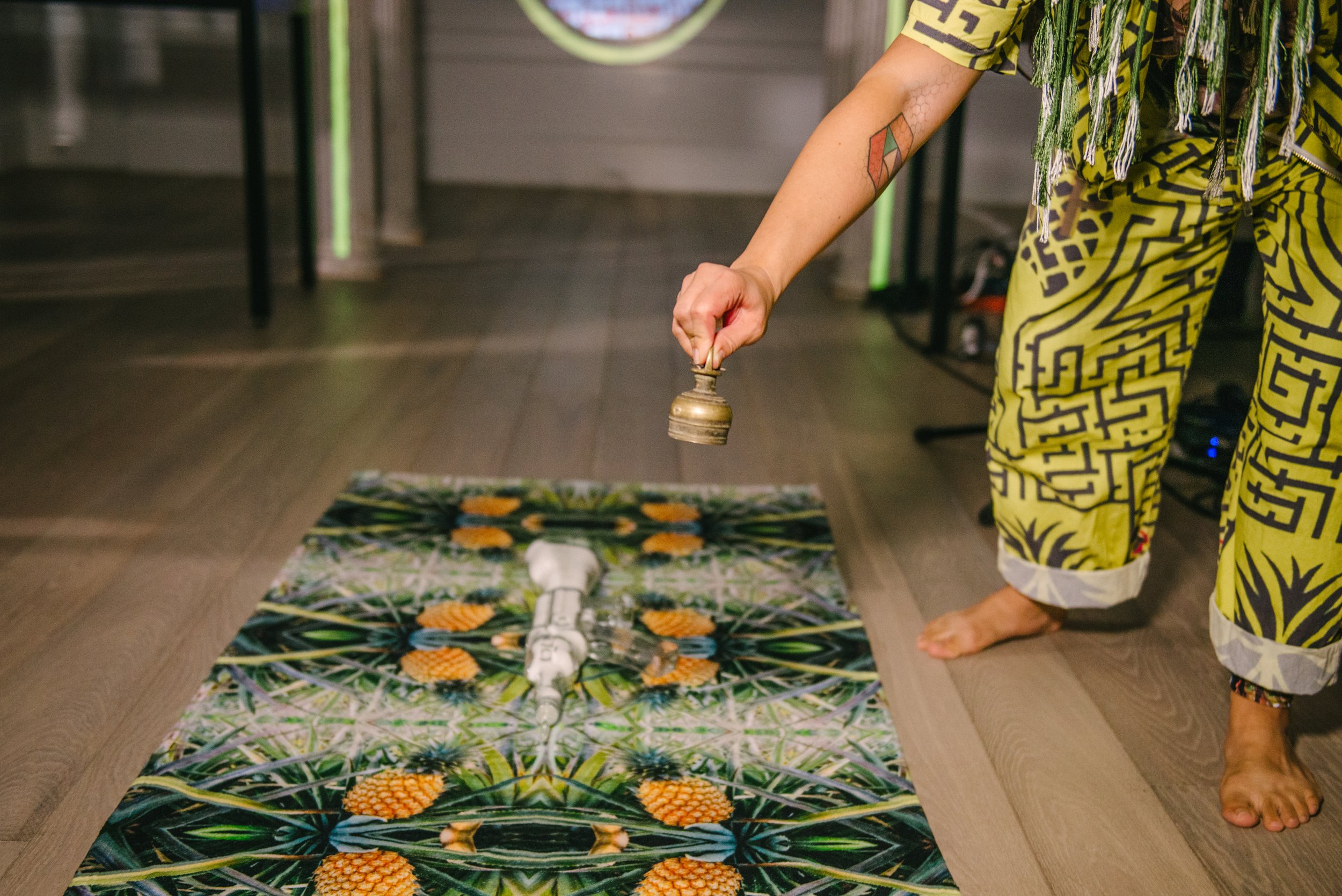
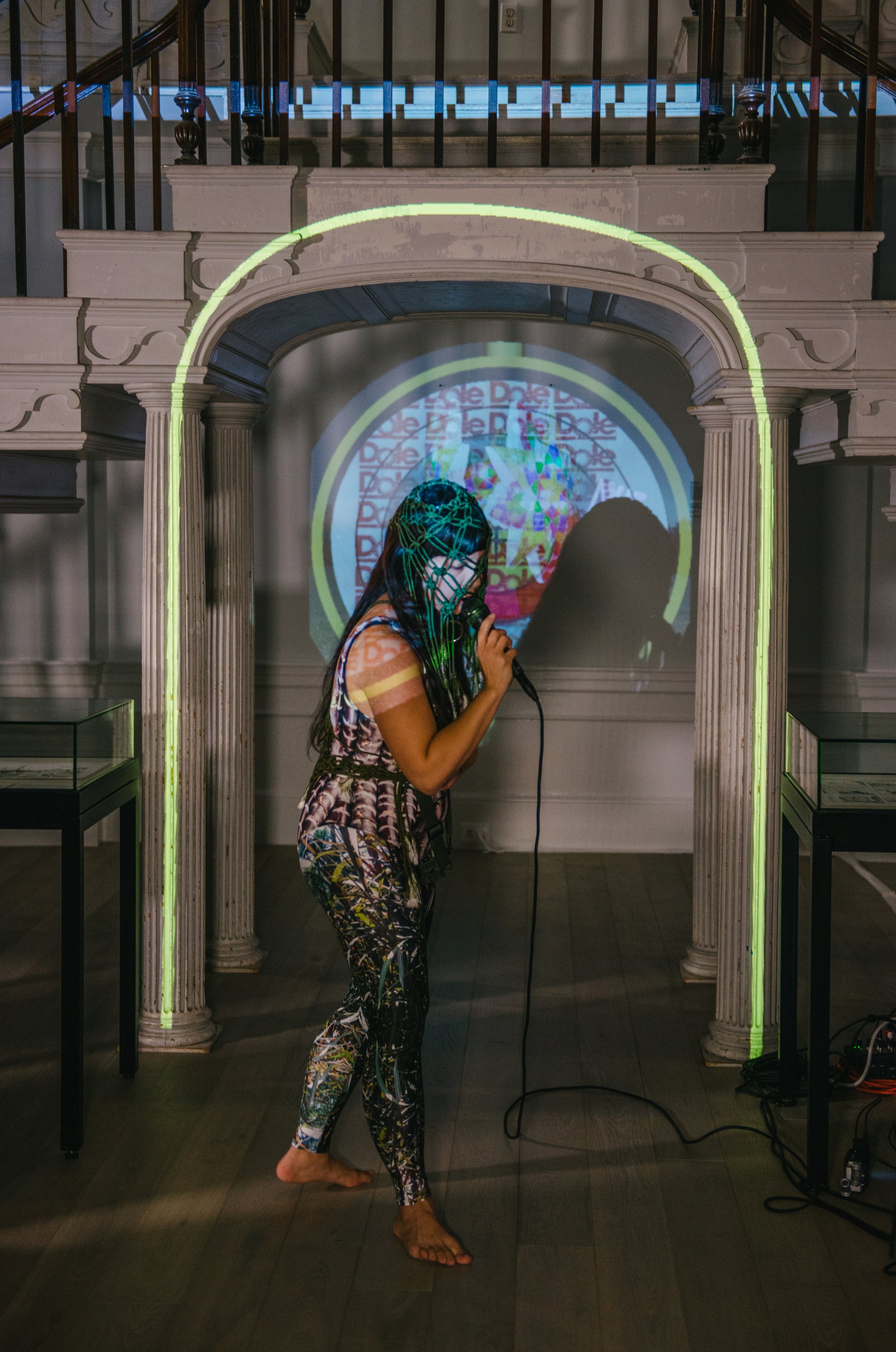
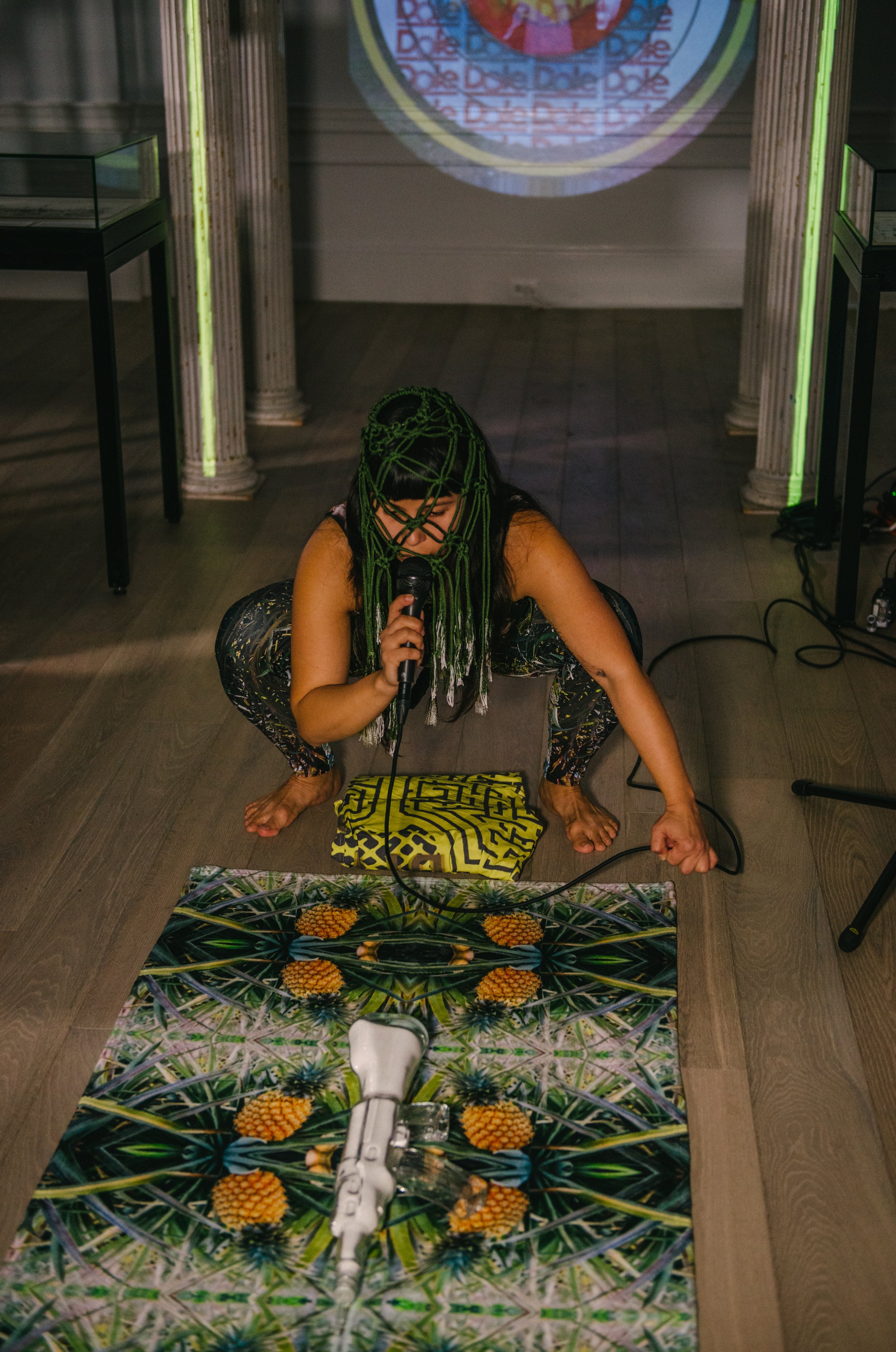
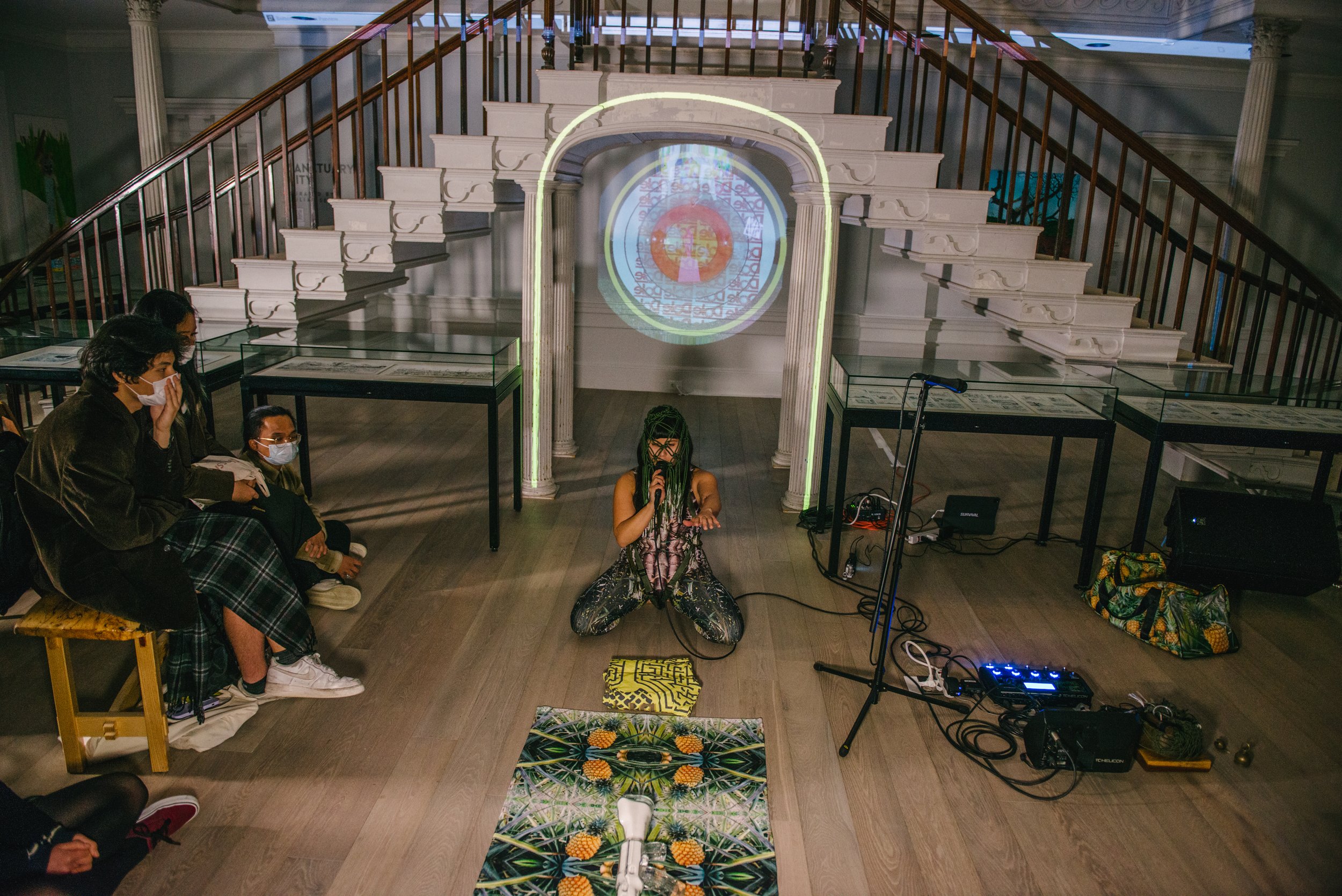
Duty-Free Paradise (DFP) is a series that focuses on Trans-Pacific connections between the Pacific, West Coast, and New England histories of ecotourism, biopolitics, and militarism; it aims to find points of healing of ancestral intergenerational trauma narratives through the work. This collaborative performance with mezzo-soprano Pauline Tan, is part of new work in the DFP series, both artists took an approach of improvisation focusing on experimental voice work and Asuncion playing the ancient kulintang gong from the Philippines while Pauline sung traditional Filipino Folk songs in the operatic style in the following Filipino dialects — Cebuano, Ilokano, T’boli, Visayan, Hiligaynon, and Tagalog — can be heard throughout this performance.
Video production by Nicolas Andrew Visuals assisted by Christian Ruiz
This performance and work exhibited in Sanctuary City group show at the Somerville Museum is work developed from the Duty-Free Paradise (2020-22) series with photos from the Dole House and Isle of the Blessed performance.
This project was supported by a Local Cultural Council Grant (2022) from Somerville Arts Council
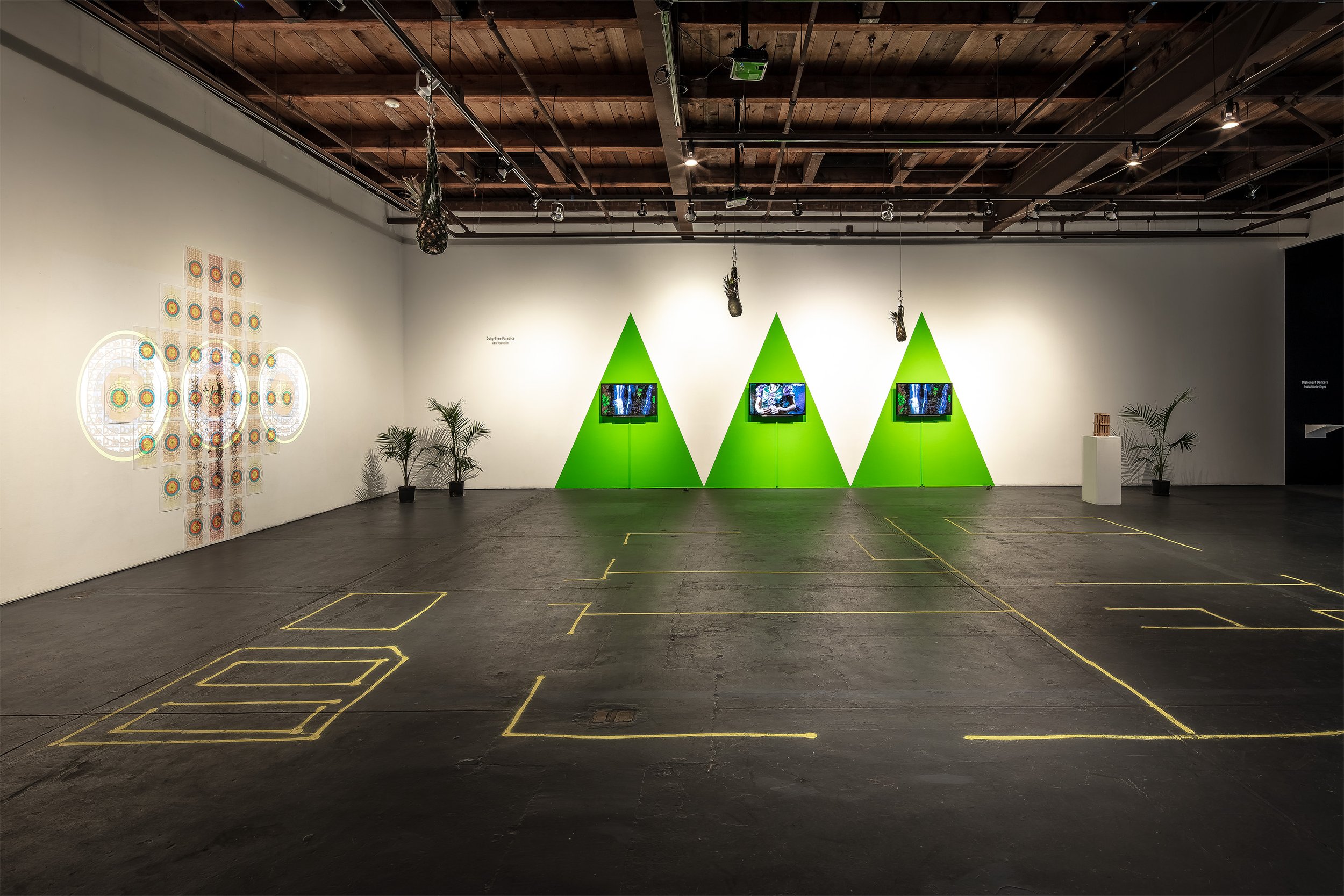
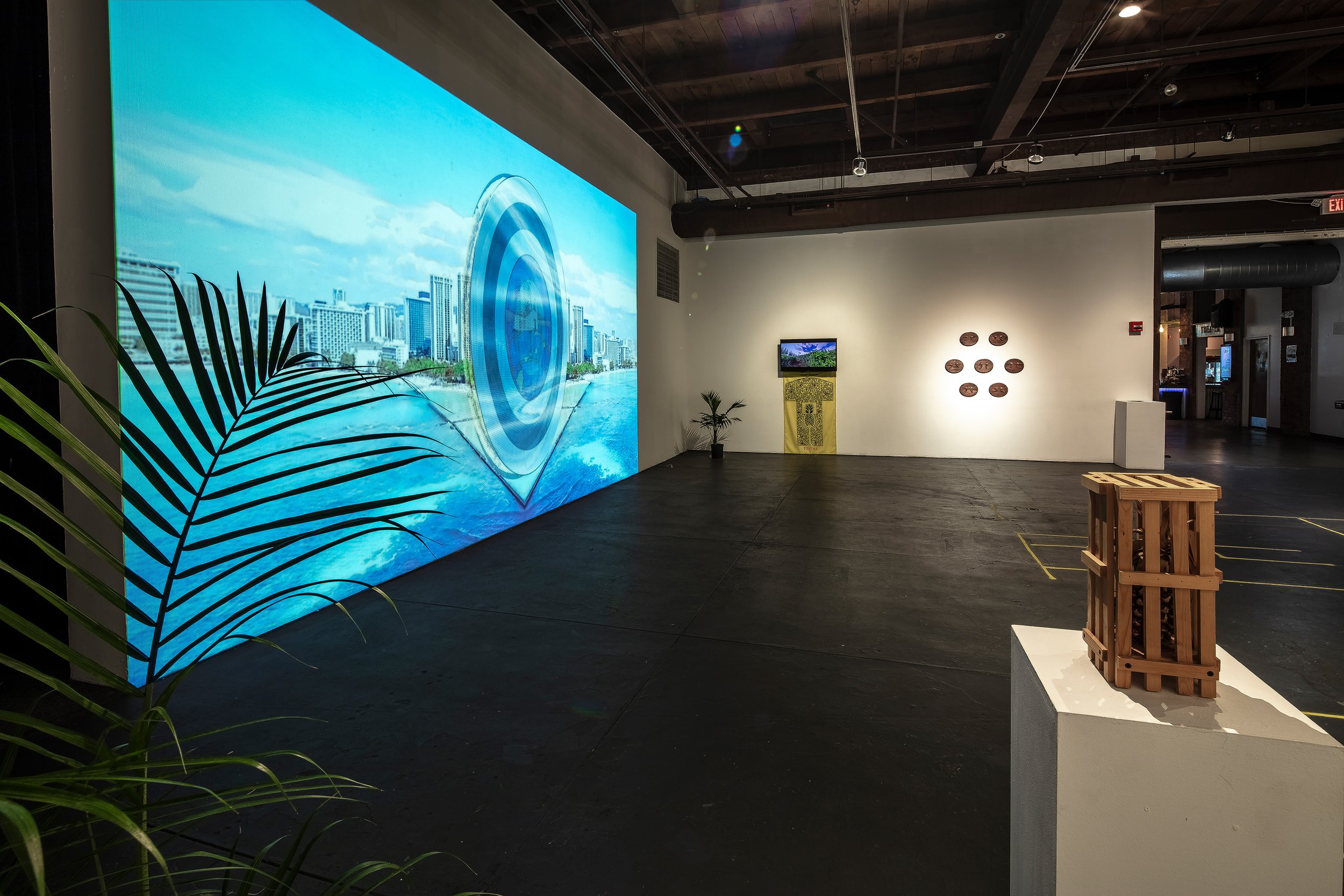
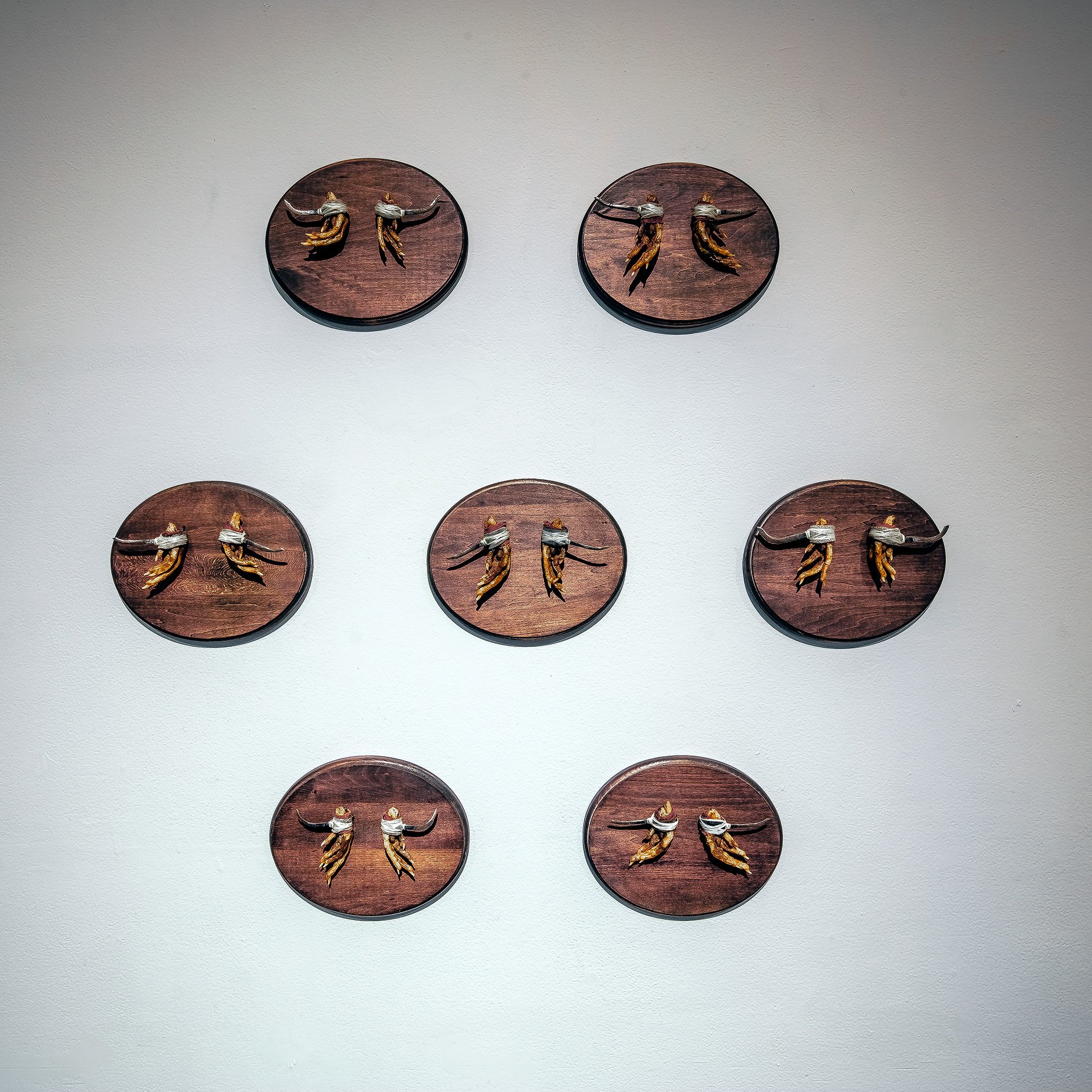
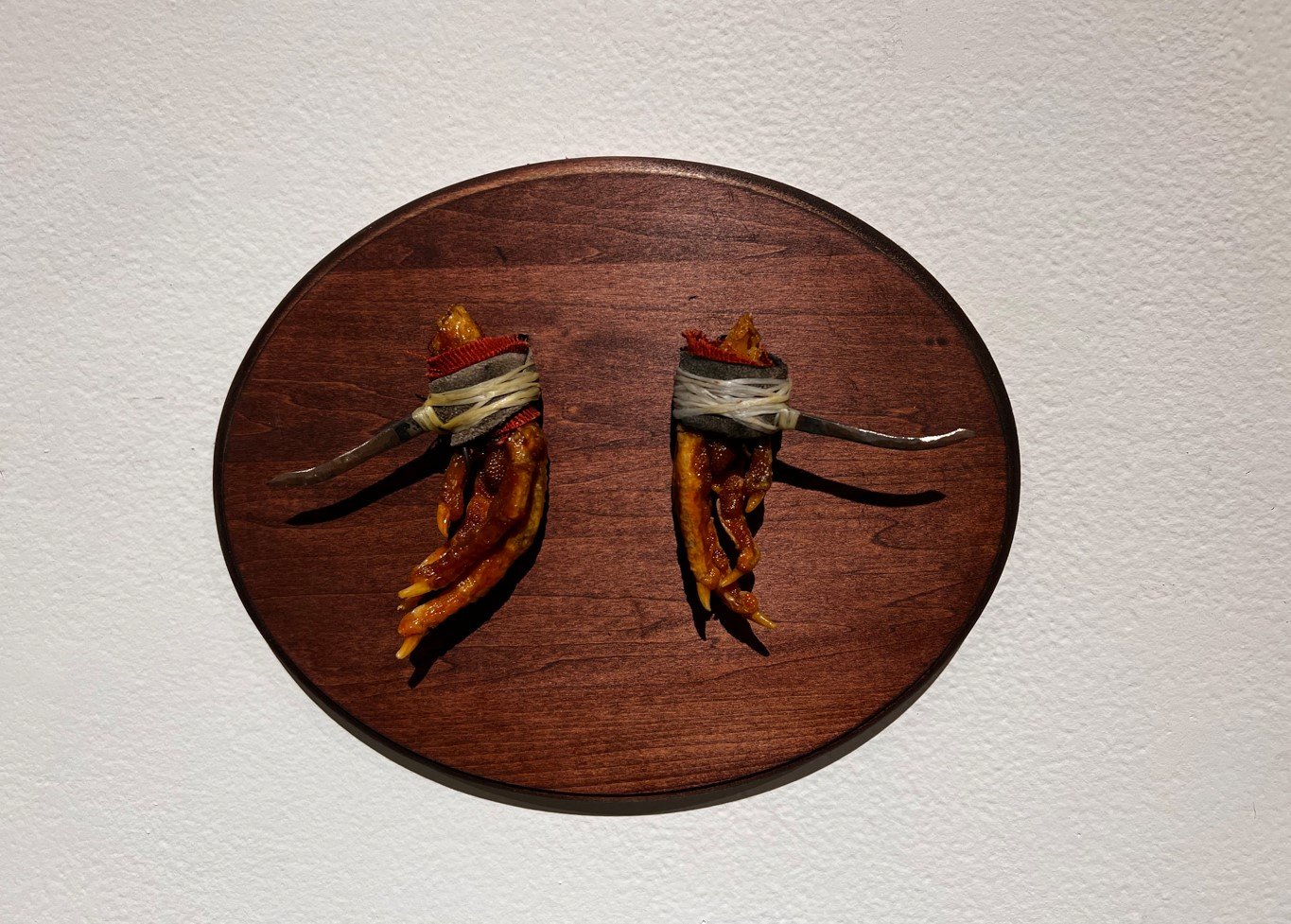
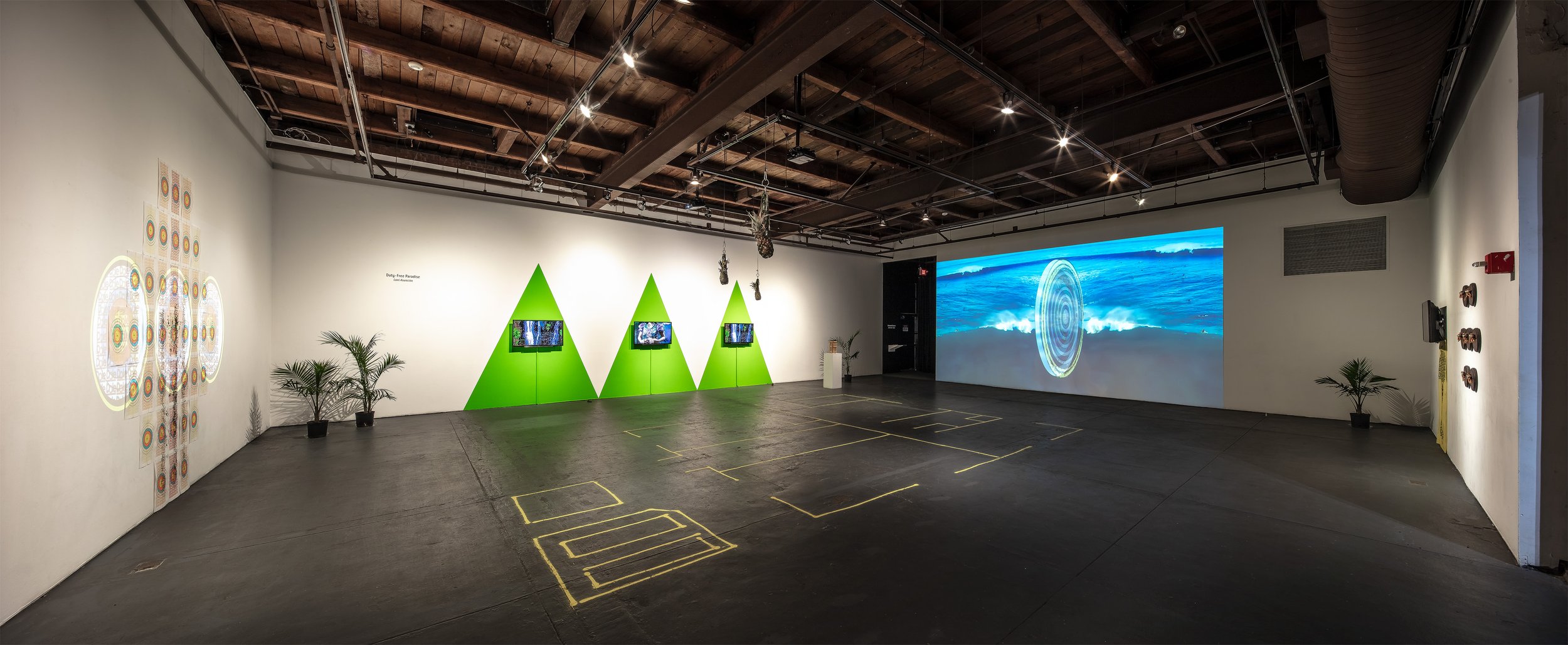

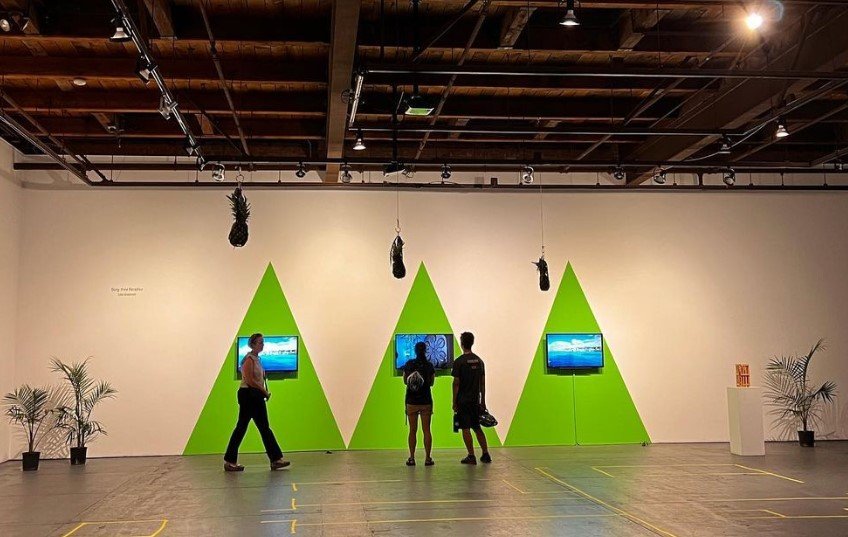
Duty-Free Paradise solo exhibition at Real Art Ways (main gallery), Hartford, CT | July 21-Aug. 27, 2022
Performance & Panel Discussion w/ Billie Lee & Joe Bun Keo | Aug. 8, 2022
DFP | Dole House at 10b projects in JP performing with Forbes Graham | May 8, 2022
Photography by Taylor Blackley
The Scope Boston | A work in progress: Developing equitable spaces for artistry to flourish in Boston by Taylor Blackley
May 9, 2022 [Read full story here]
Photography by Sasha Pedro
Duty-Free Paradise Installation & Performance at Studios at MassMoCA/ Assets for Artists, Future Frequencies Fellow, 2022.
Collab headpiece with artist Timothy Manalo
3D custom settlers board fabrication GOAT3DCreations
Photography above by Sasha Pedro
DFP | WAI: Red Hill Hex
Live-Performance at Aurora Picture Show, Huston, TX — April 30, 2022
DFP | WAI: Red Hill Hex is a multimedia performance addressing the ongoing water crisis in Hawai'i due to leakage from the U.S. Navy Red Hill Fuel Storage Facility in Kapūkaki, 100 feet below the facility sits the Southern Oʻahu Basal Aquifer—the primary drinking water source for the island. This piece serves as a call to action to protect the most sacred of resources, water, in solidarity with the water protectors fighting against irreversible damage. Asuncion uses wearable sculptures, projection mapping, movement, and voice to activate the performance space, across the gallery, land, and sea to their ancestors to protect the land they once labored on to heal those who have been poisoned by these negligent actions.
Documentation from the Duty-Free Paradise Performance that aired live-stream and performed on February 19, 2022 at Studios at MASS MoCA, North Adams, MA | Future Frequencies Fellow from Assets for Artists (A4A) in partnership with The CreateWell Fund.
Performance Photography by Michelle Falcón Fontánez
BIG 5 + 1 Prints
1 color silkscreen, 4 color risograph, printed at + Queer.Archive.Work/ Binch Press
View in DFP | Duty-Free Paradise store for print details.
DFP PROJECT LINKS:





















